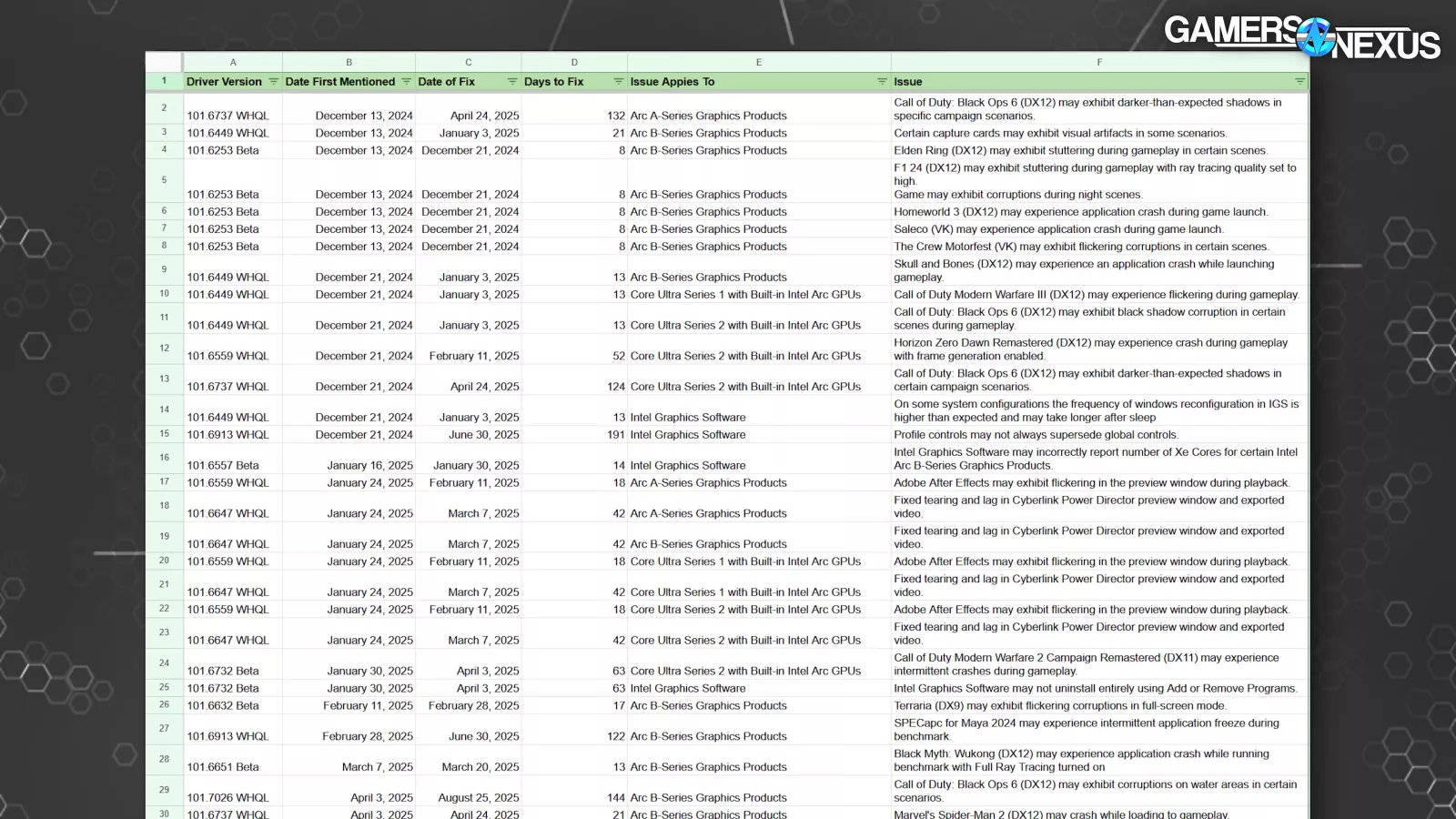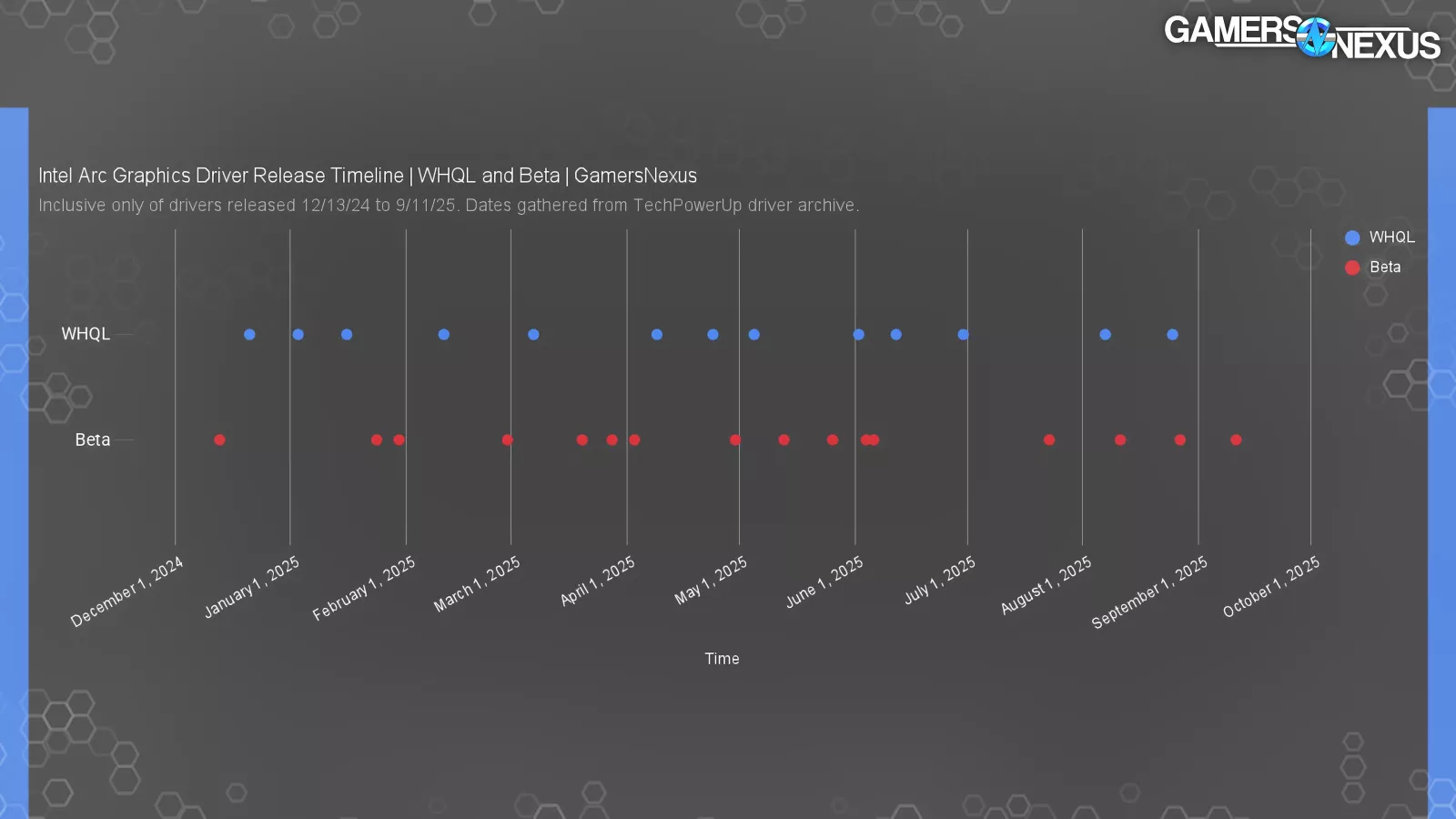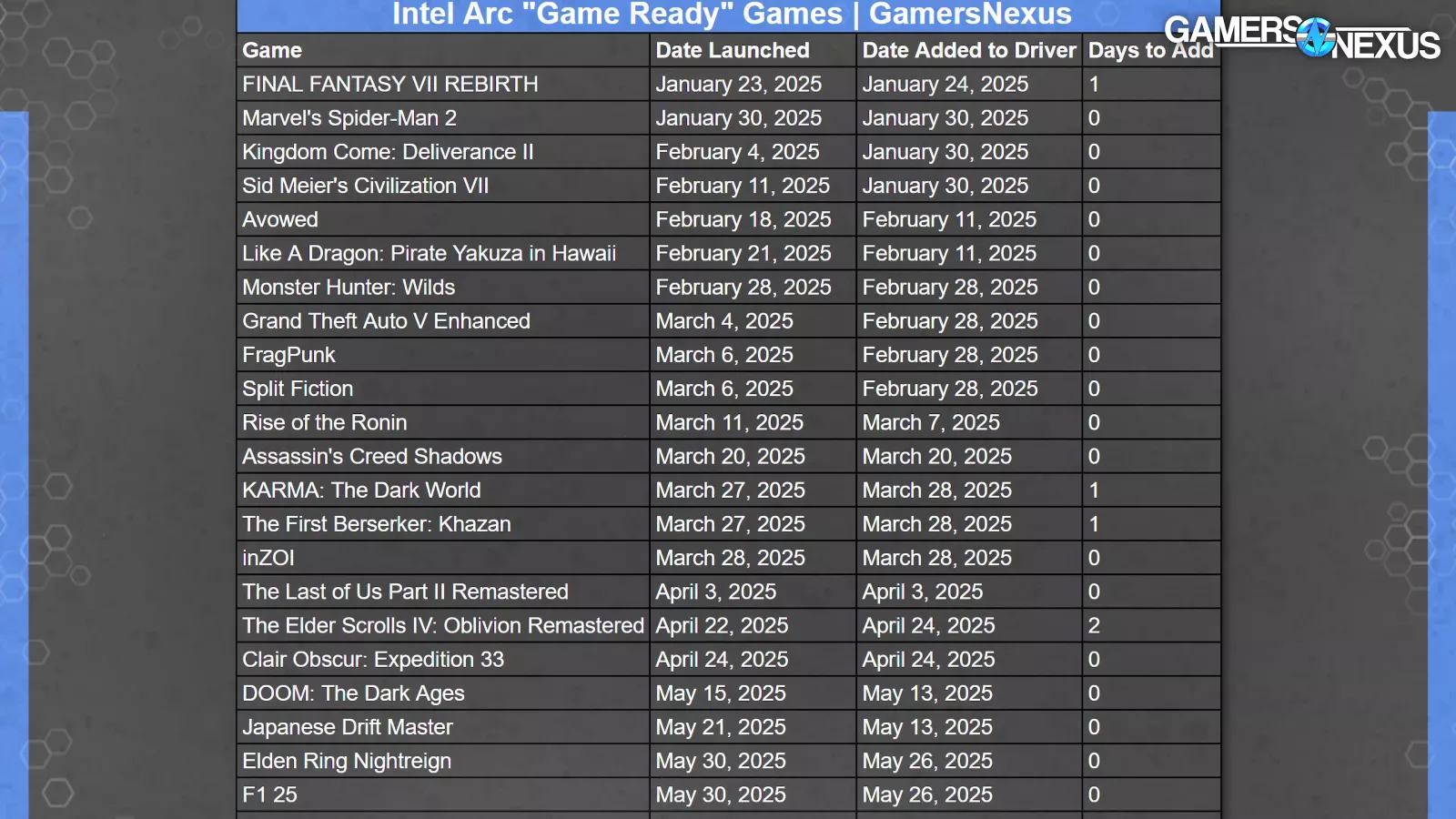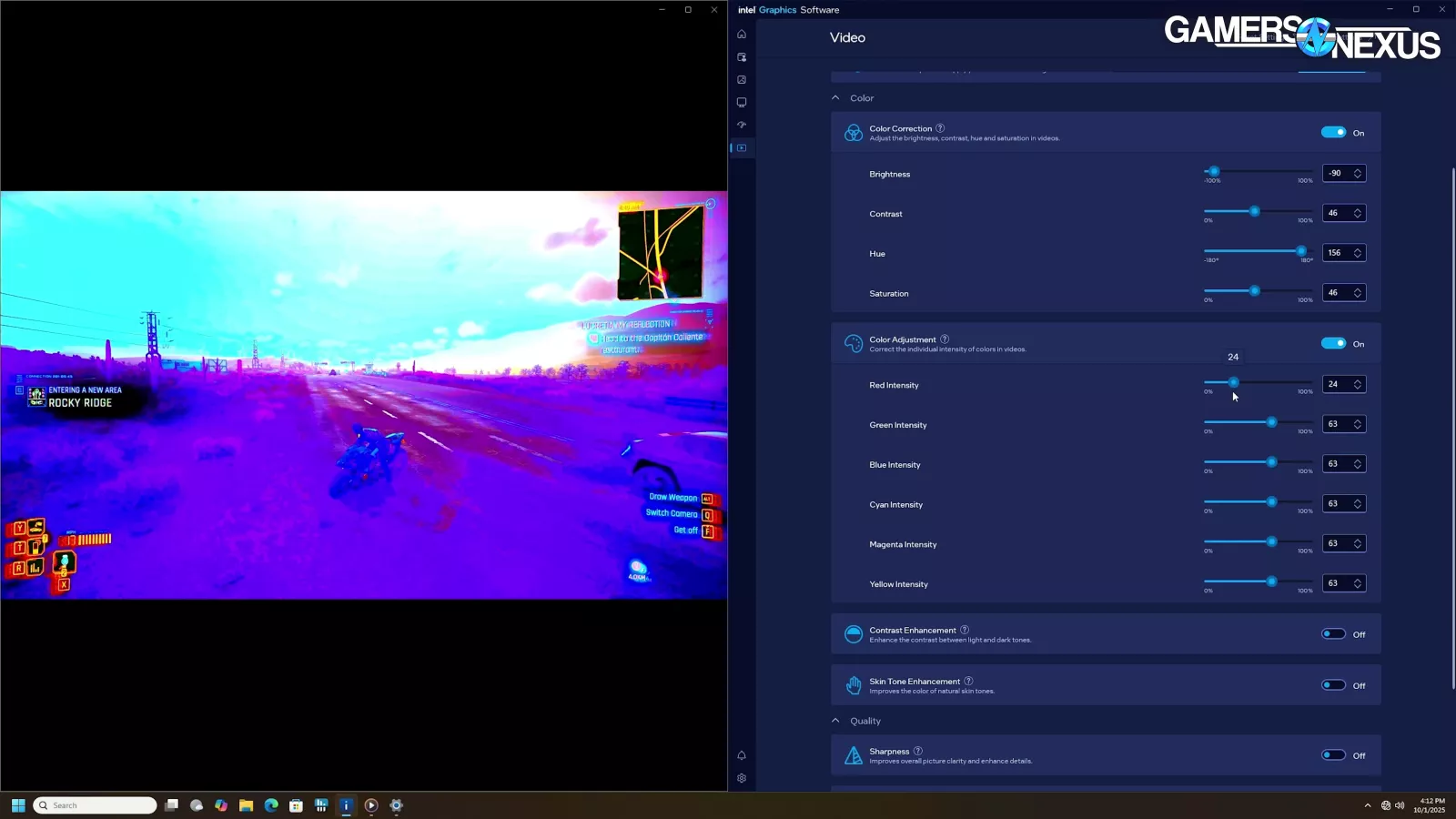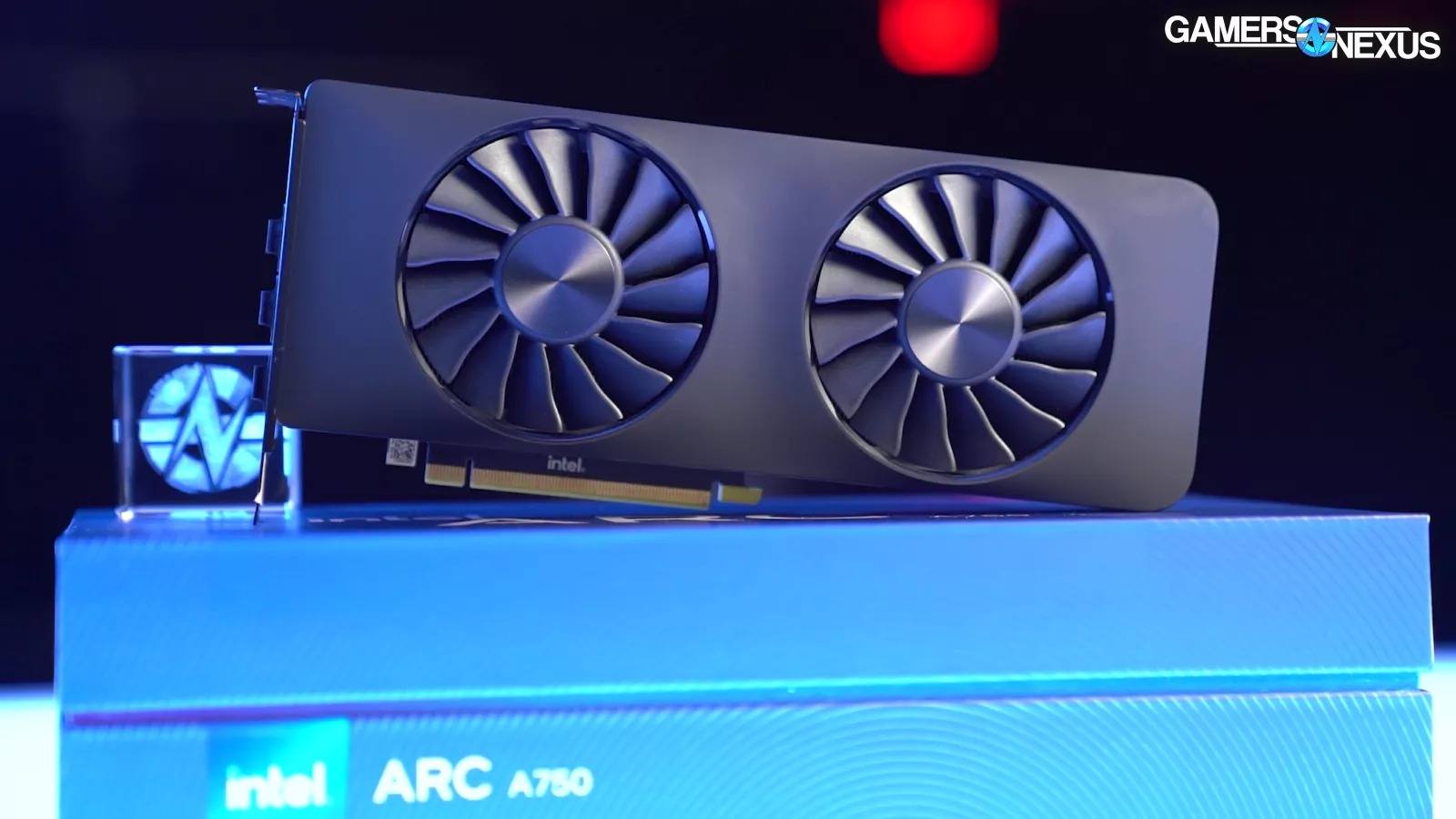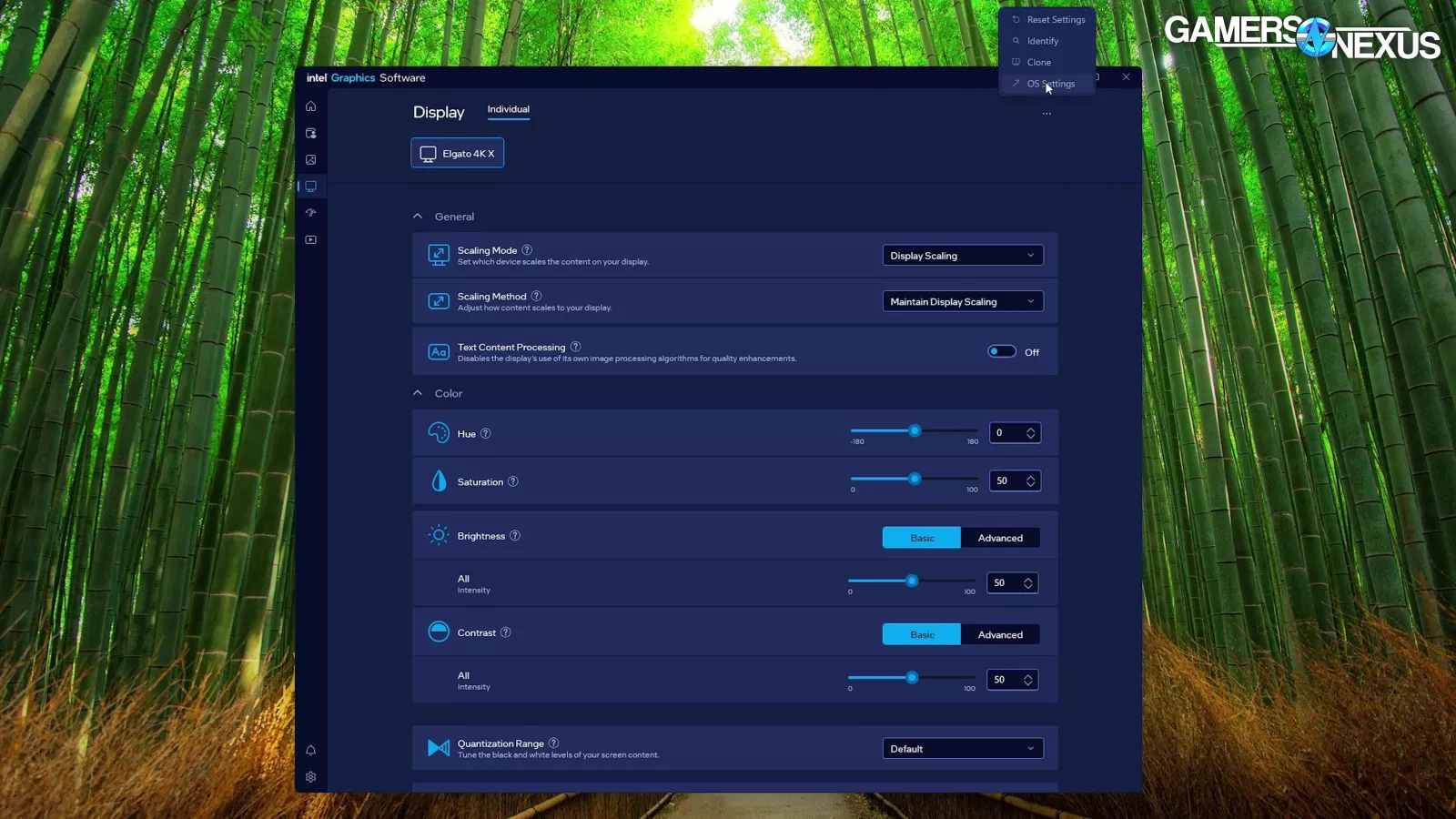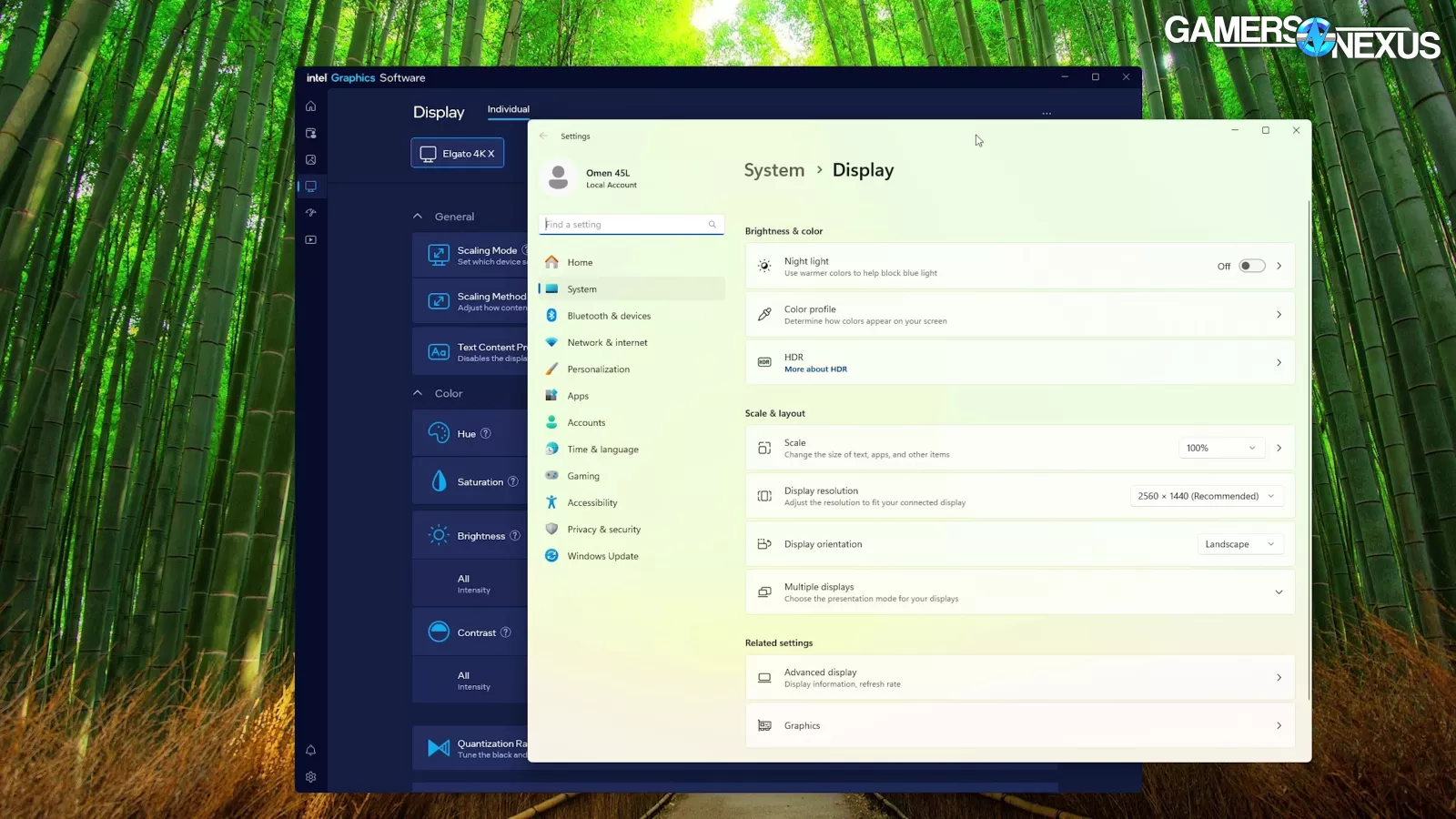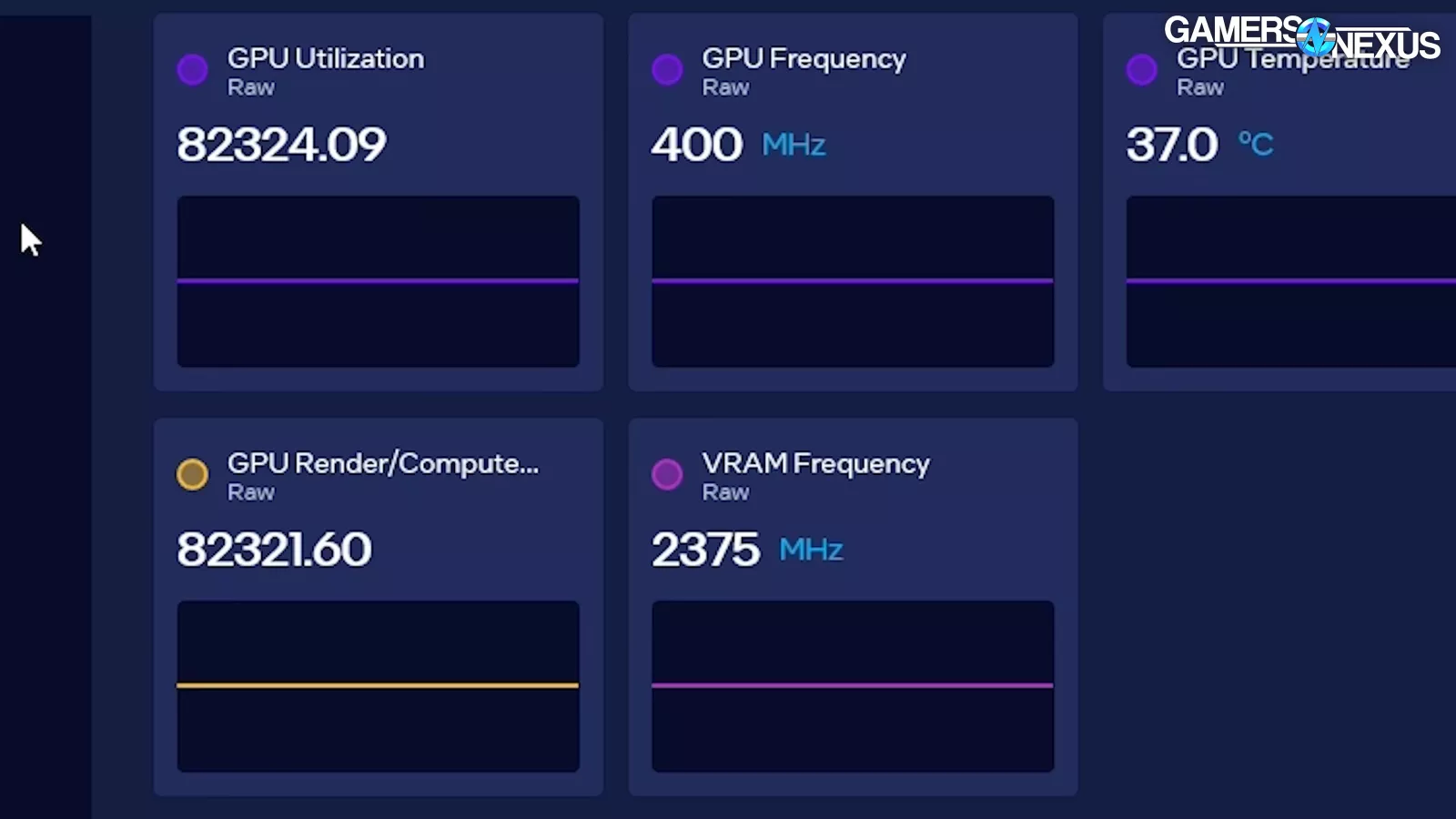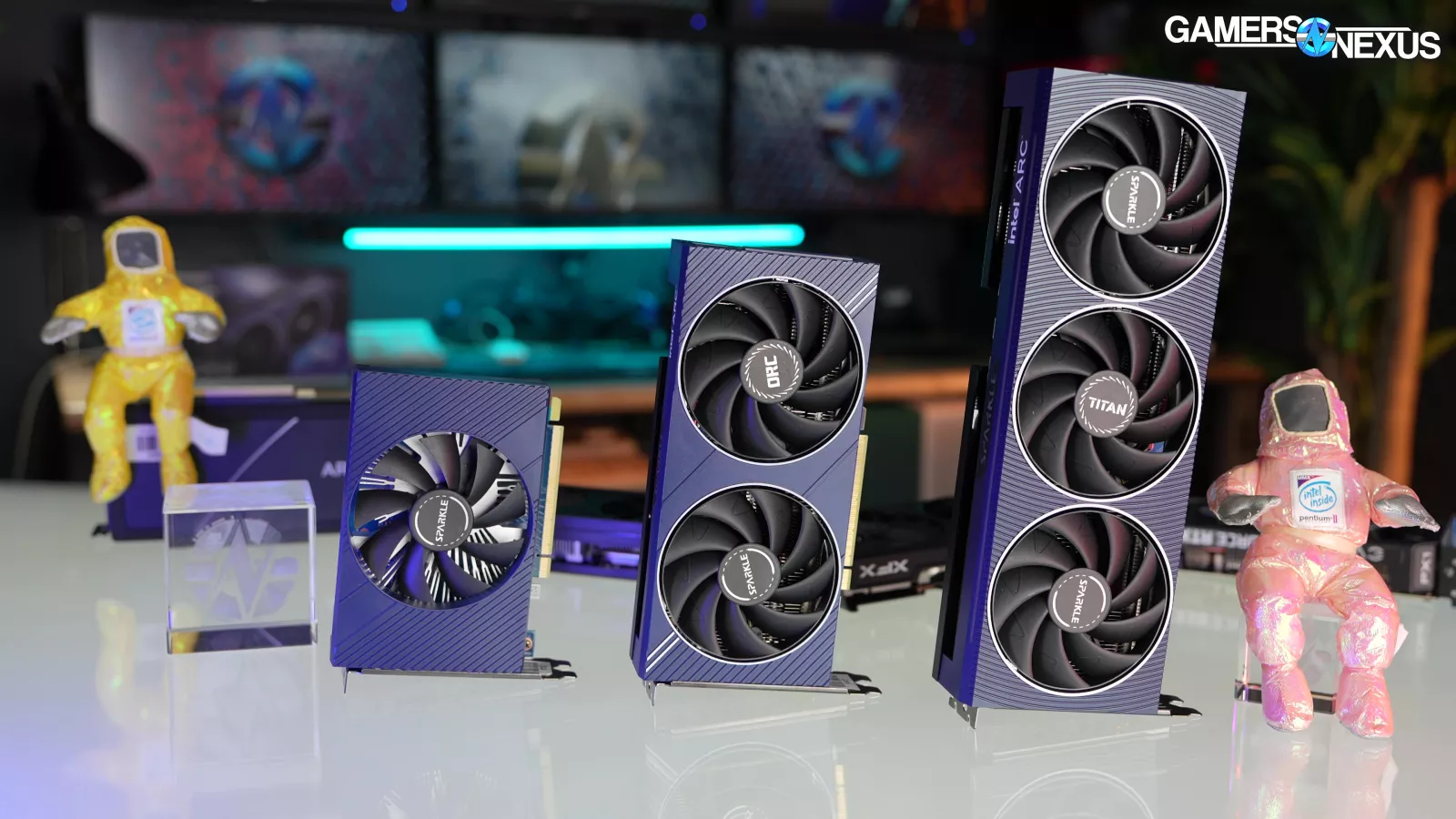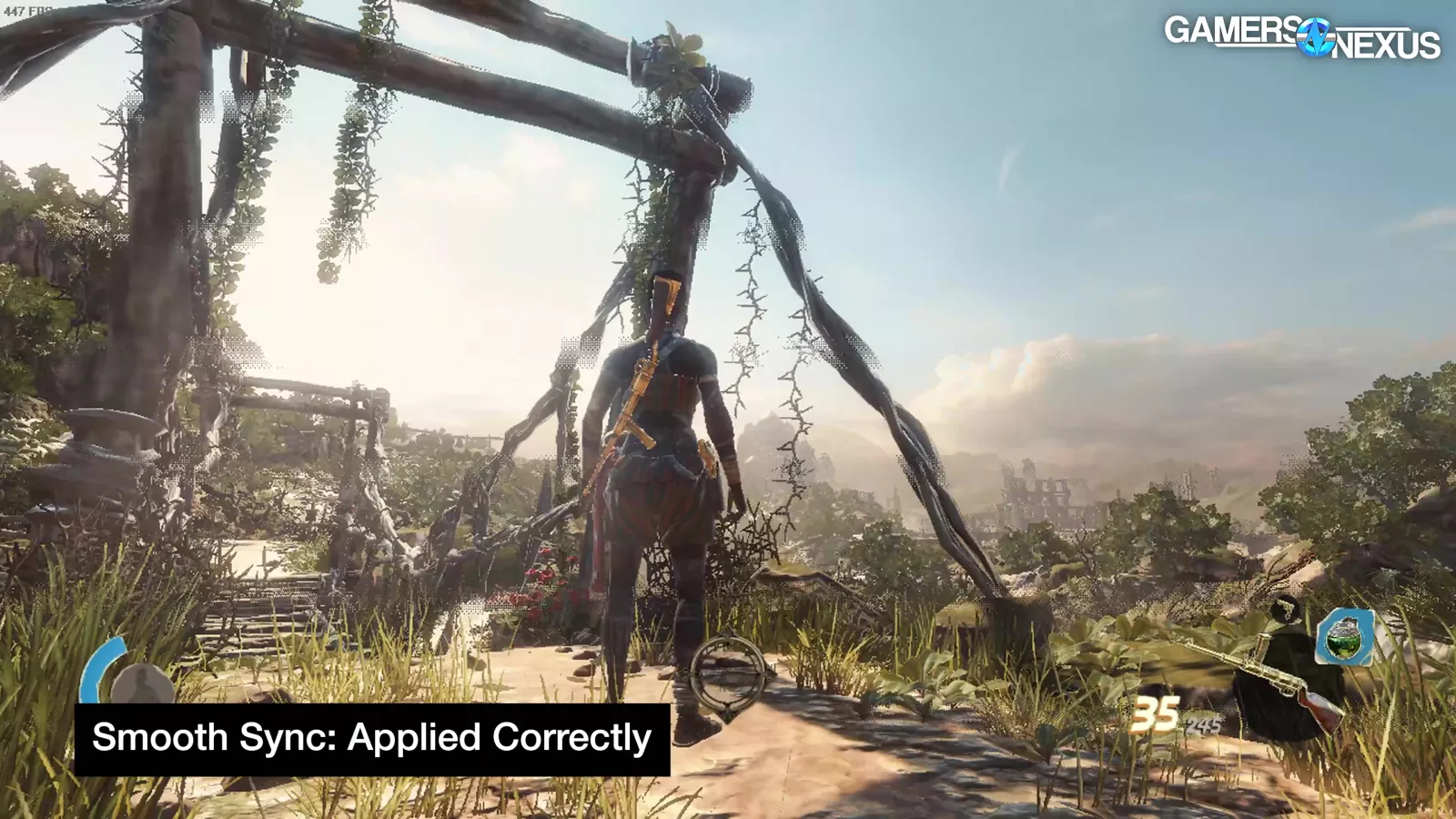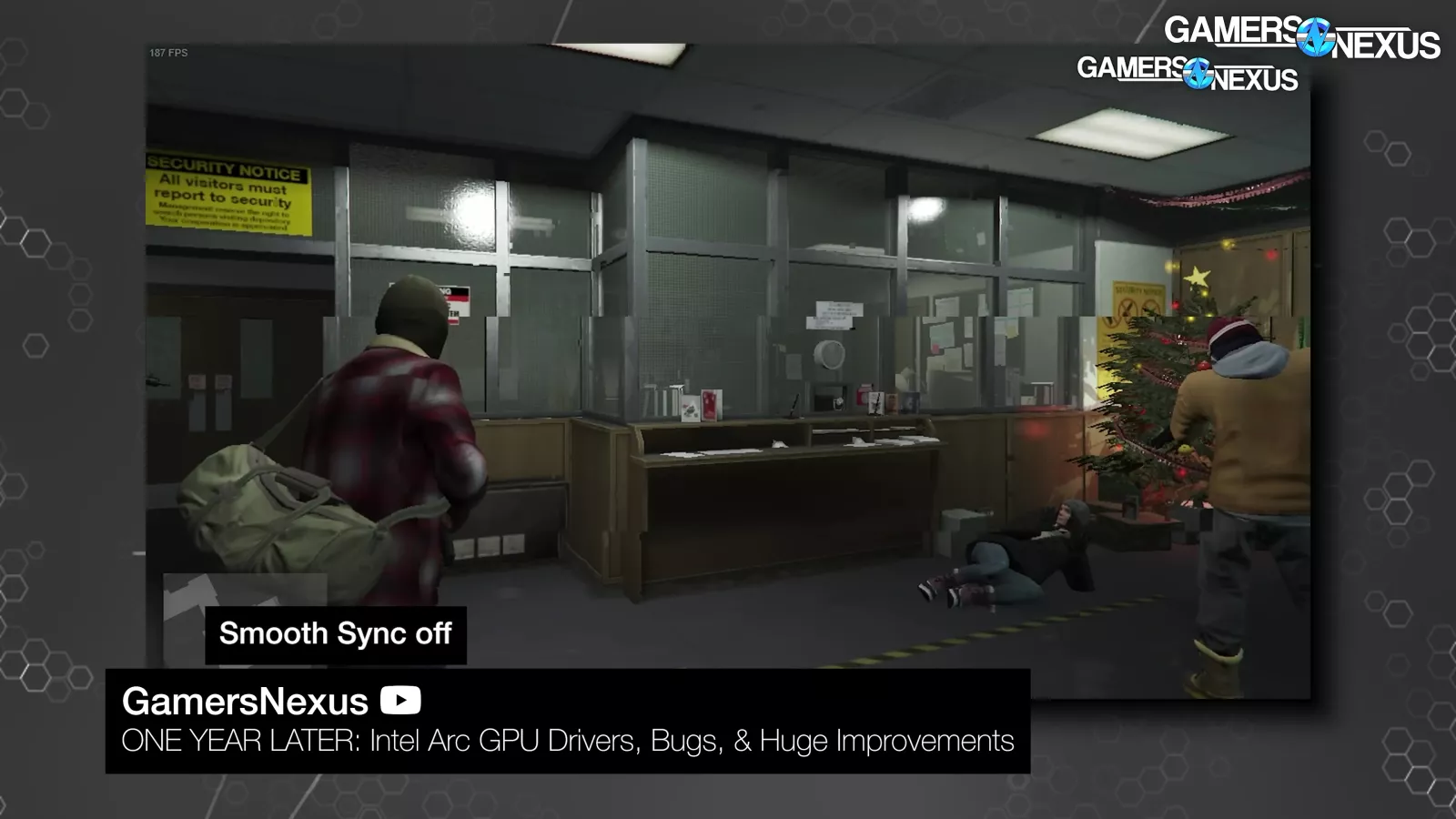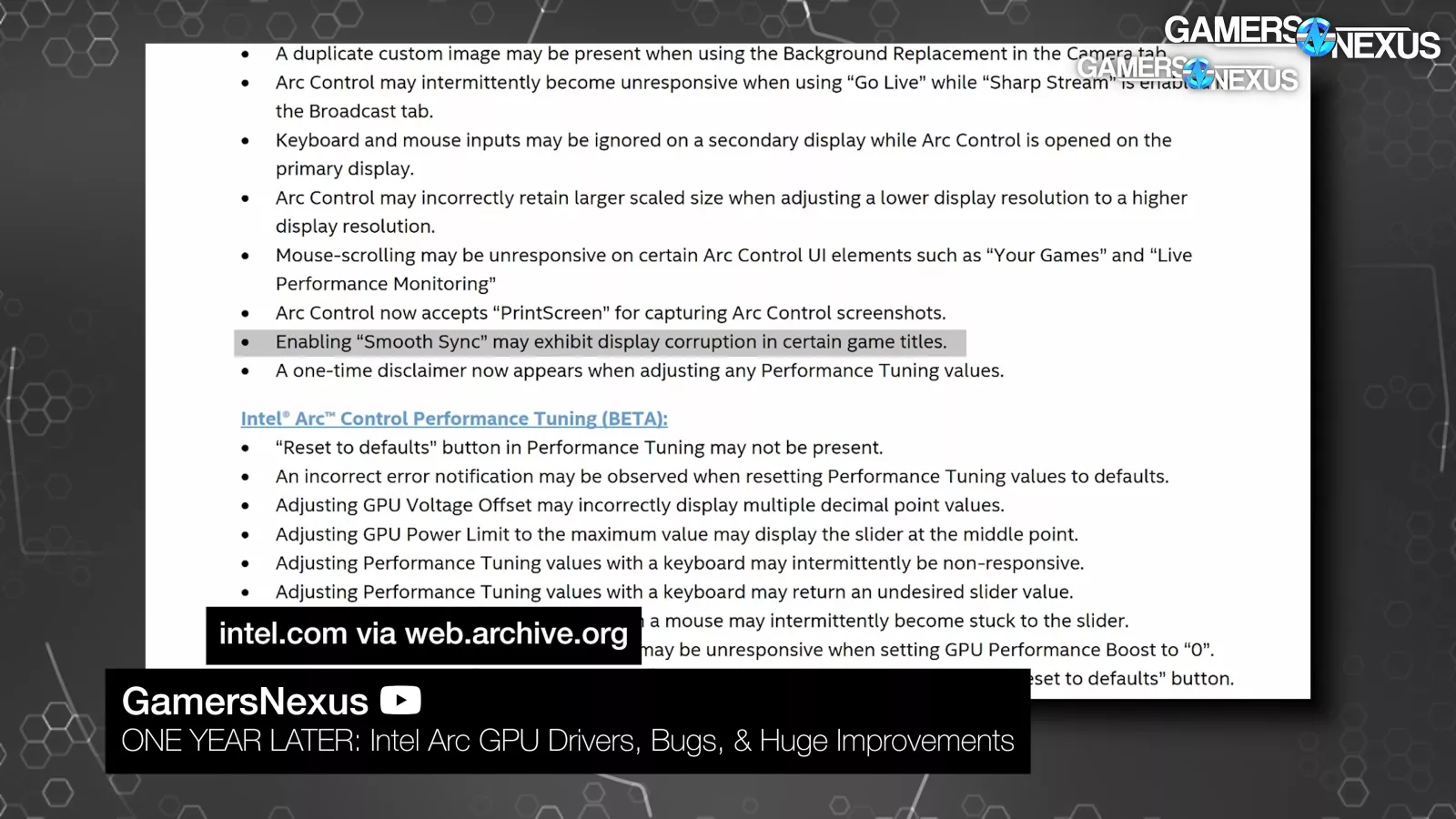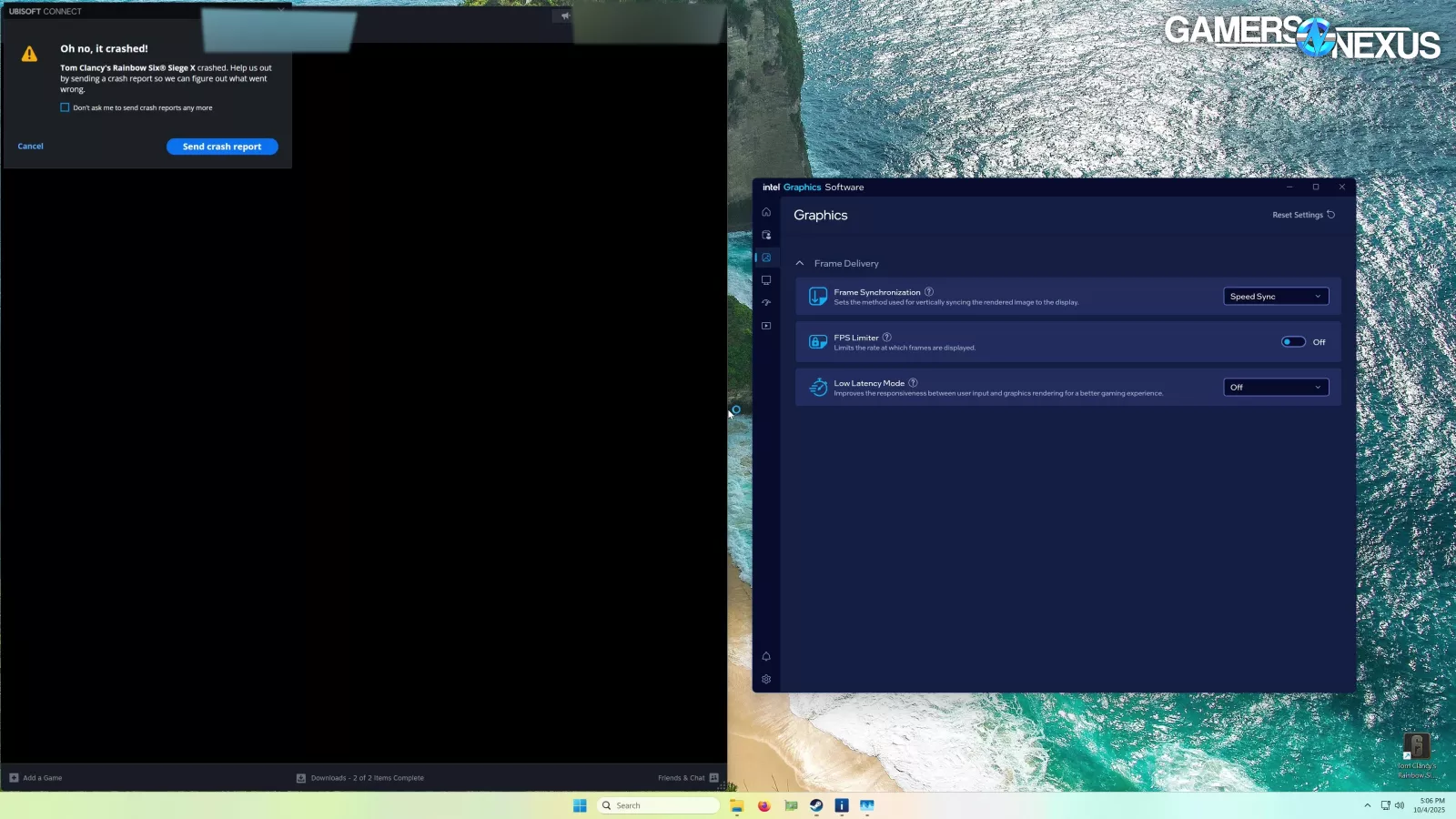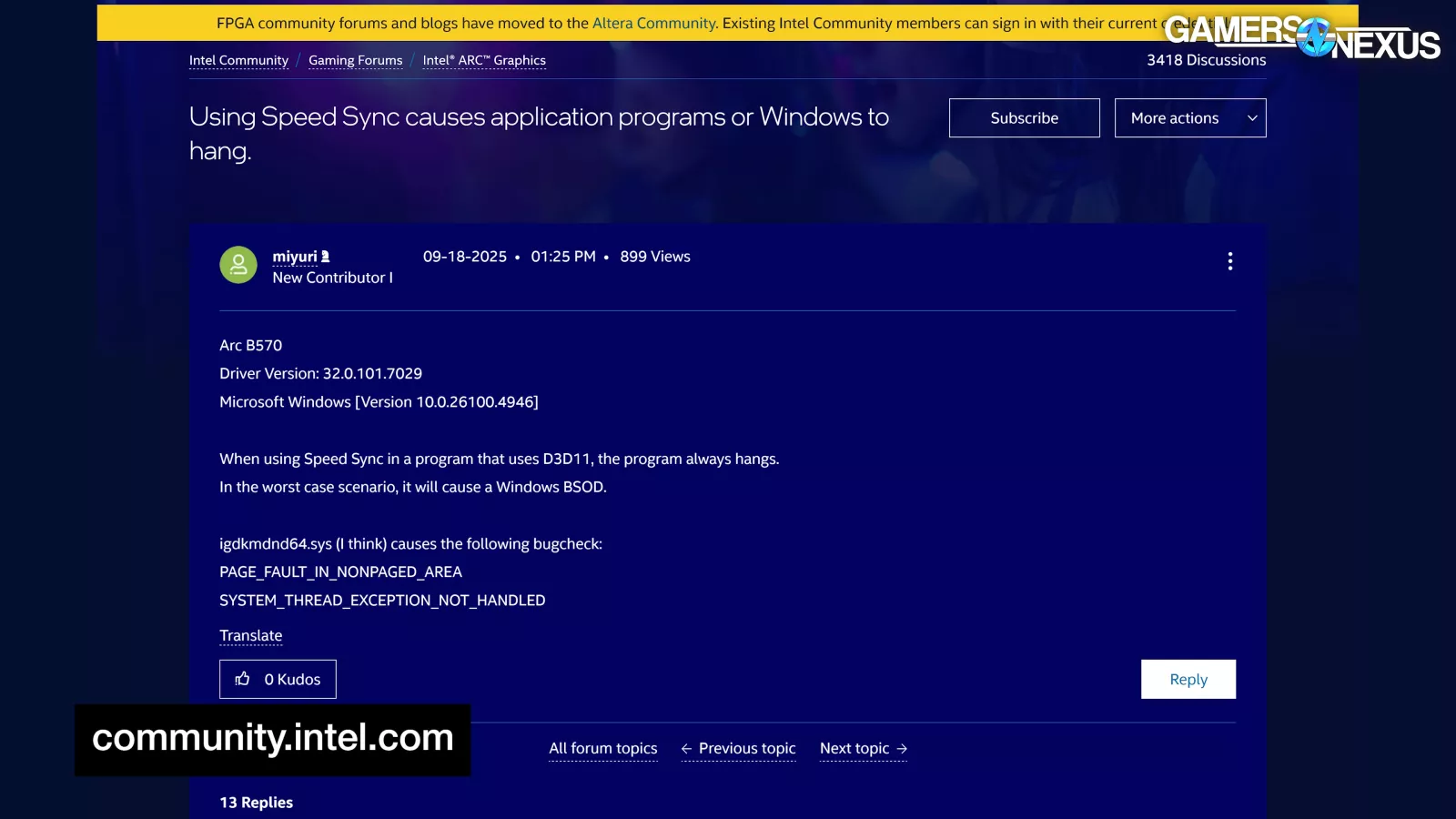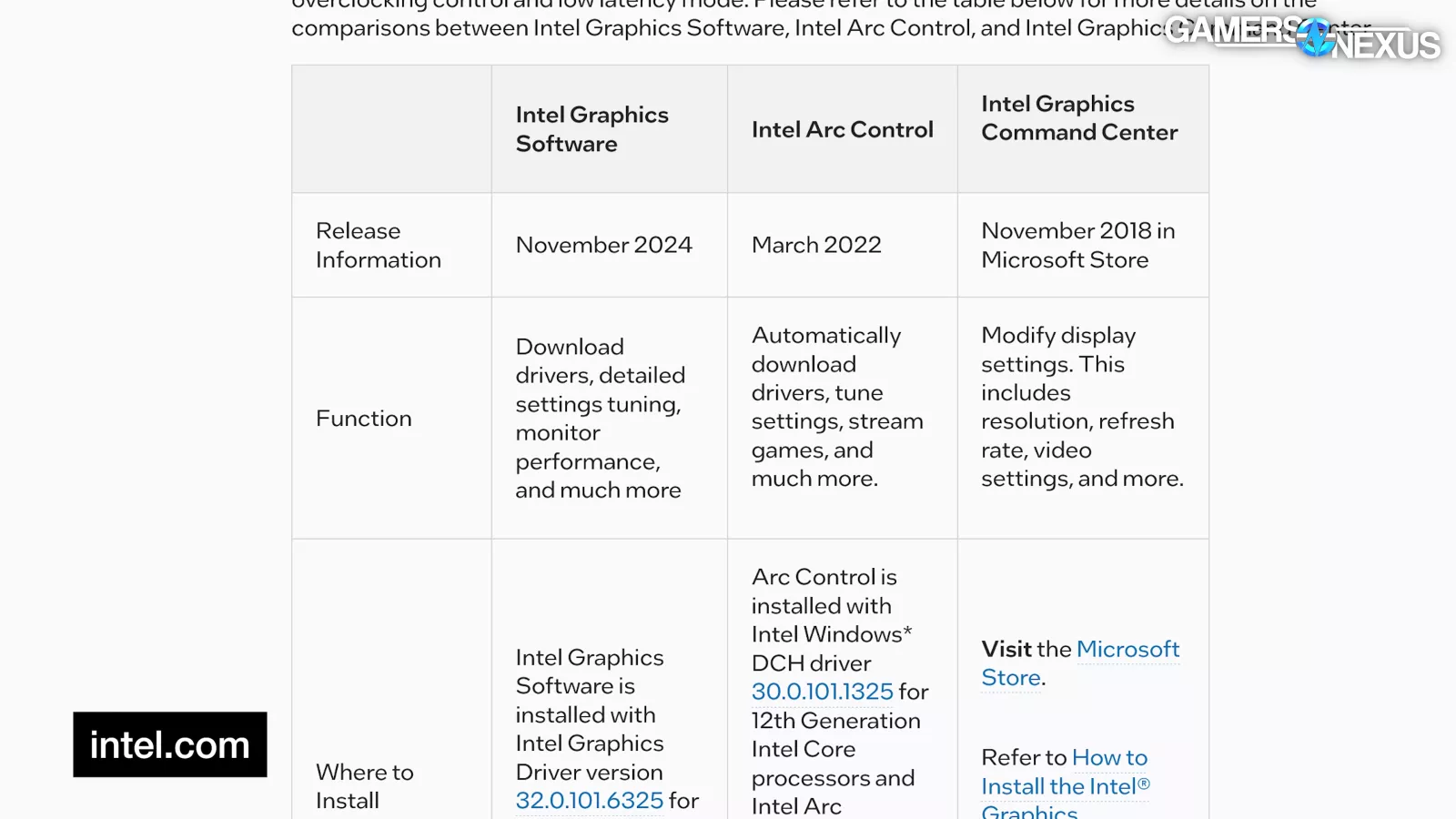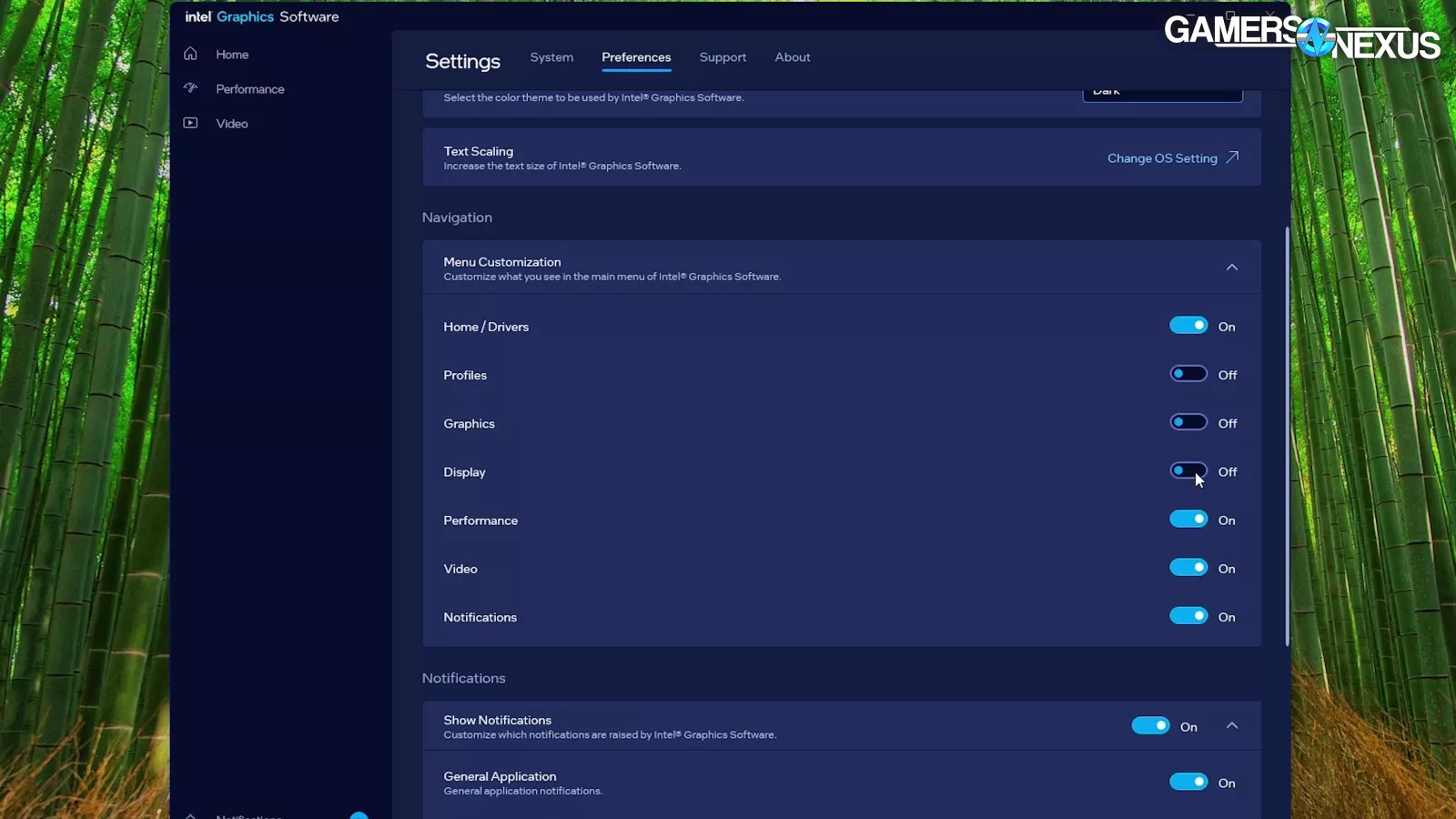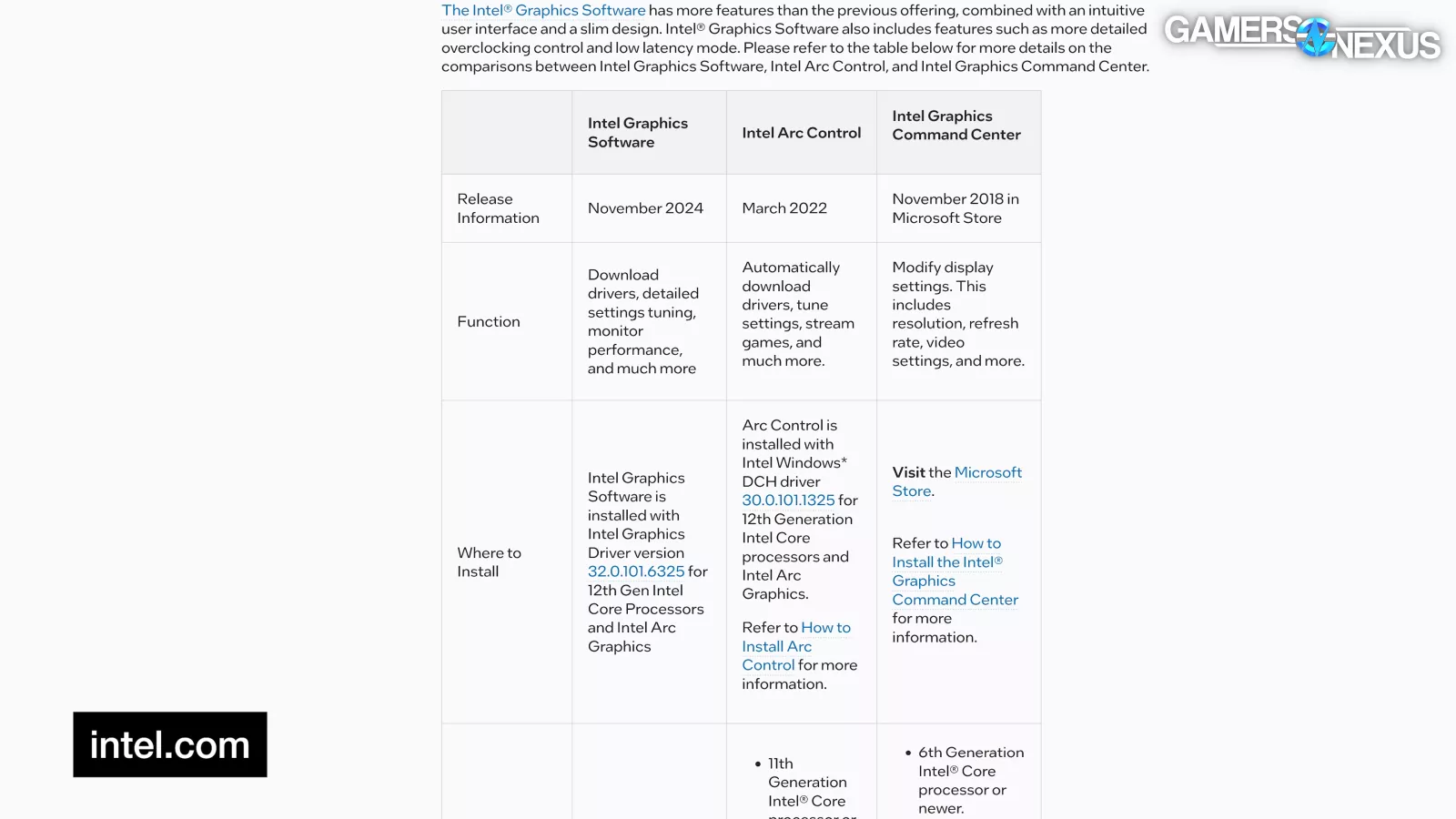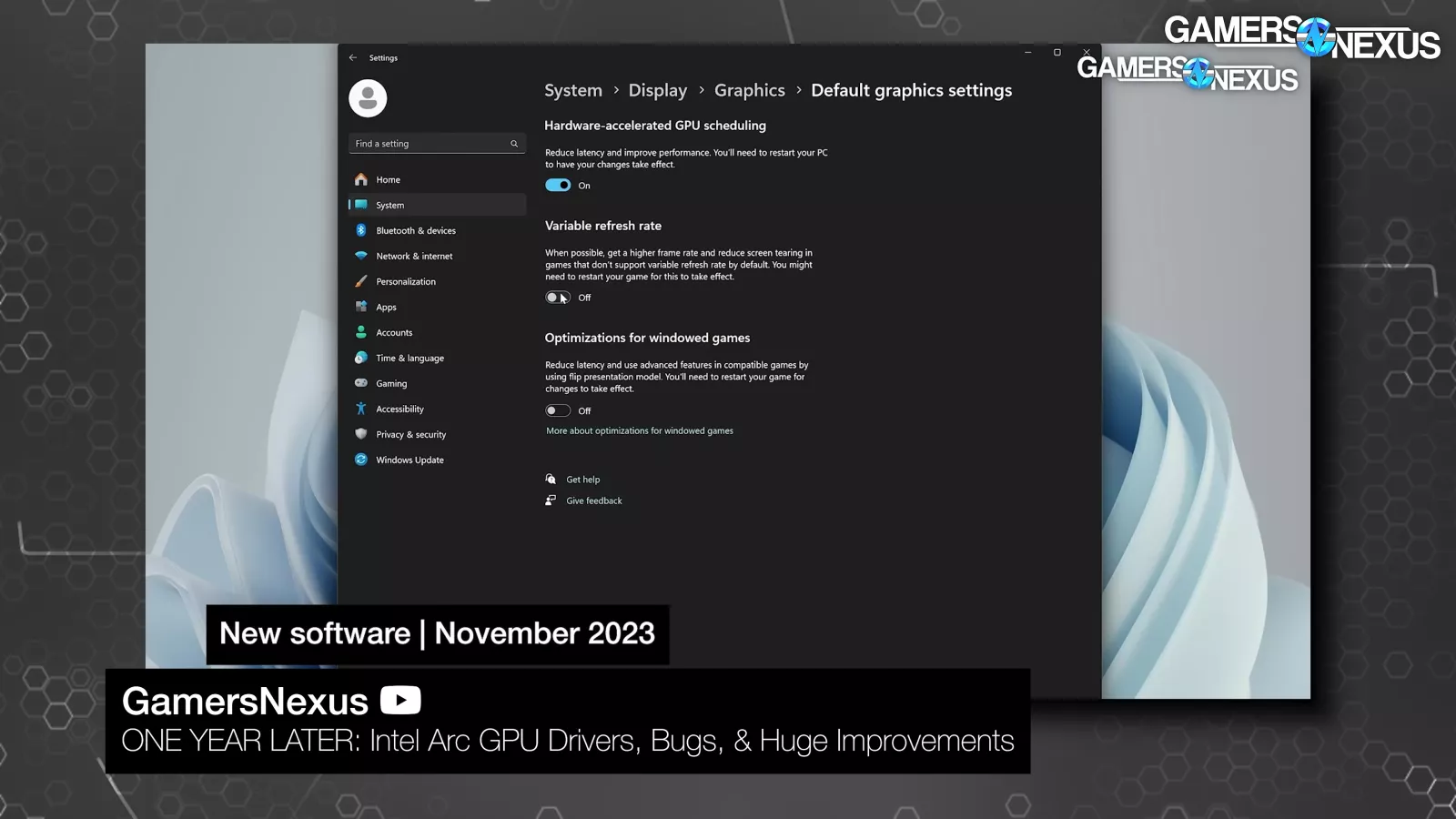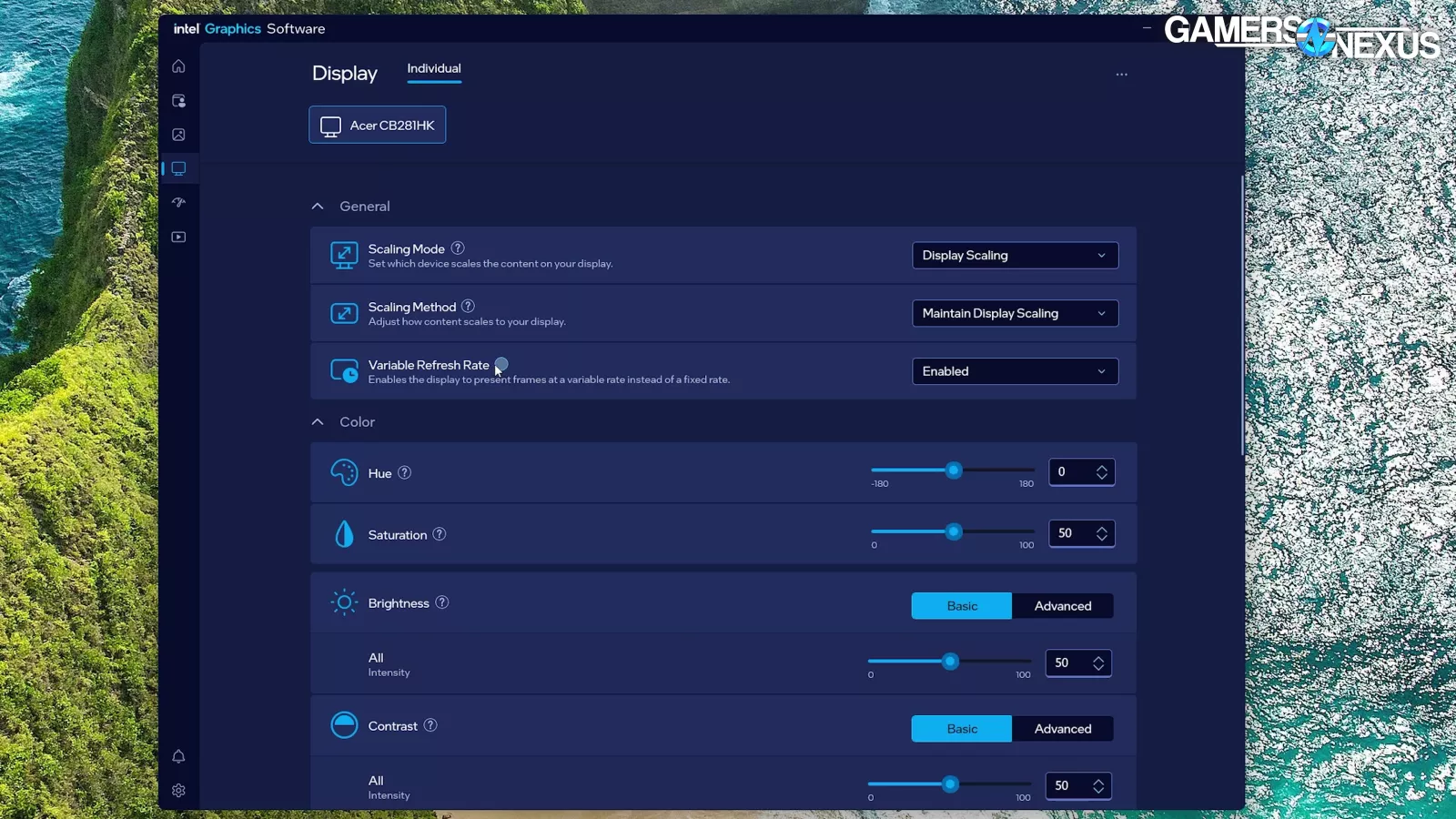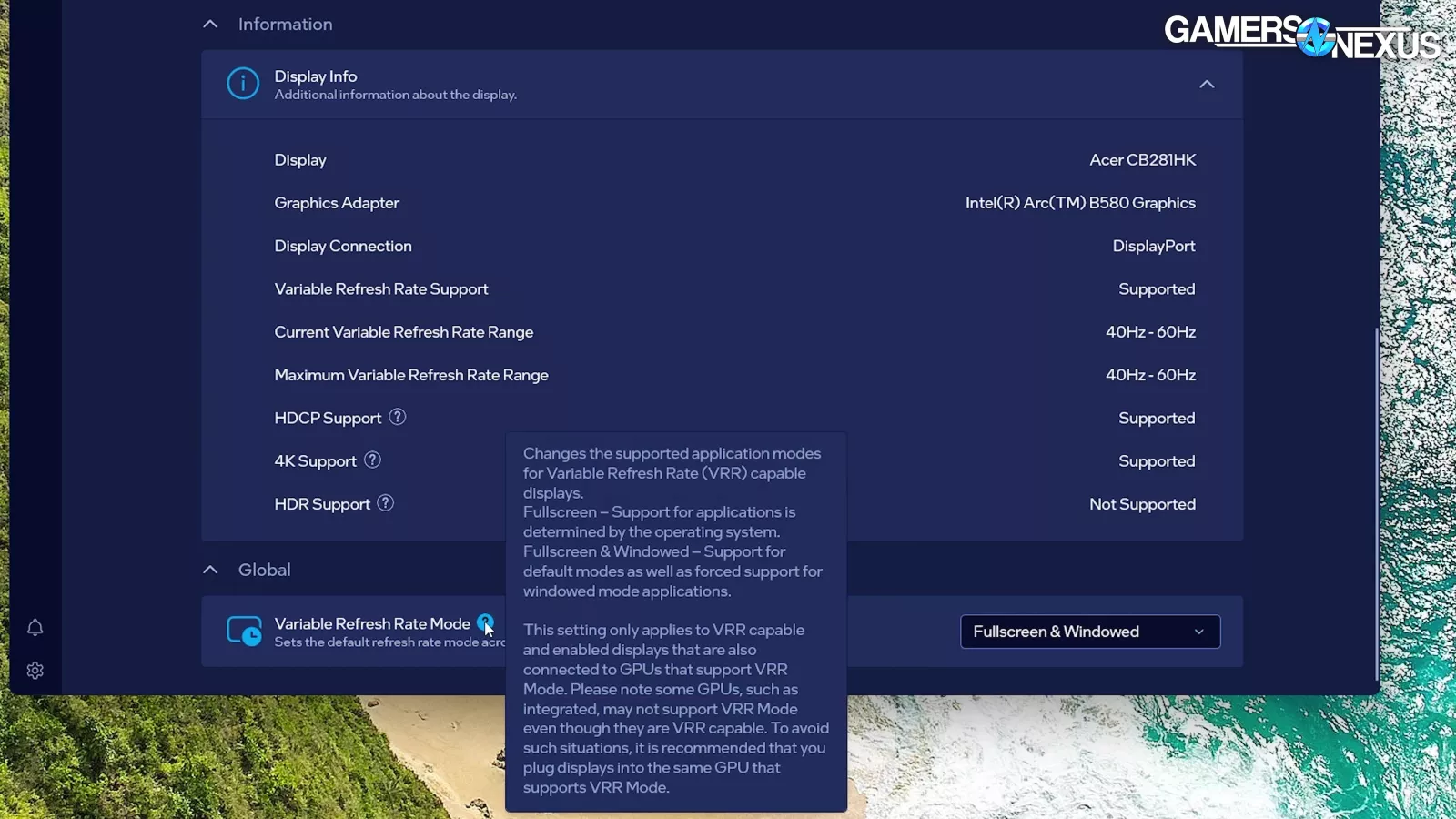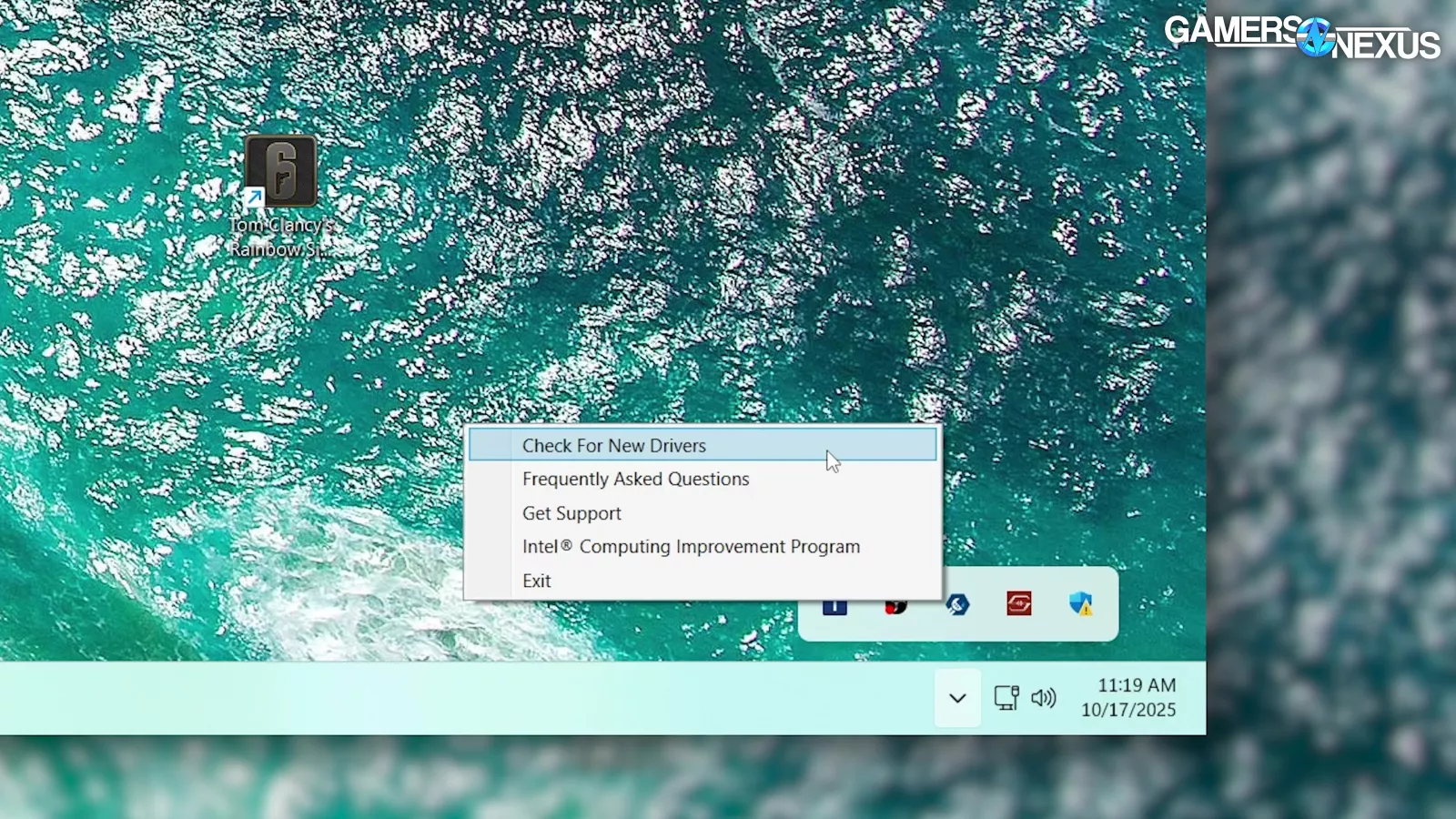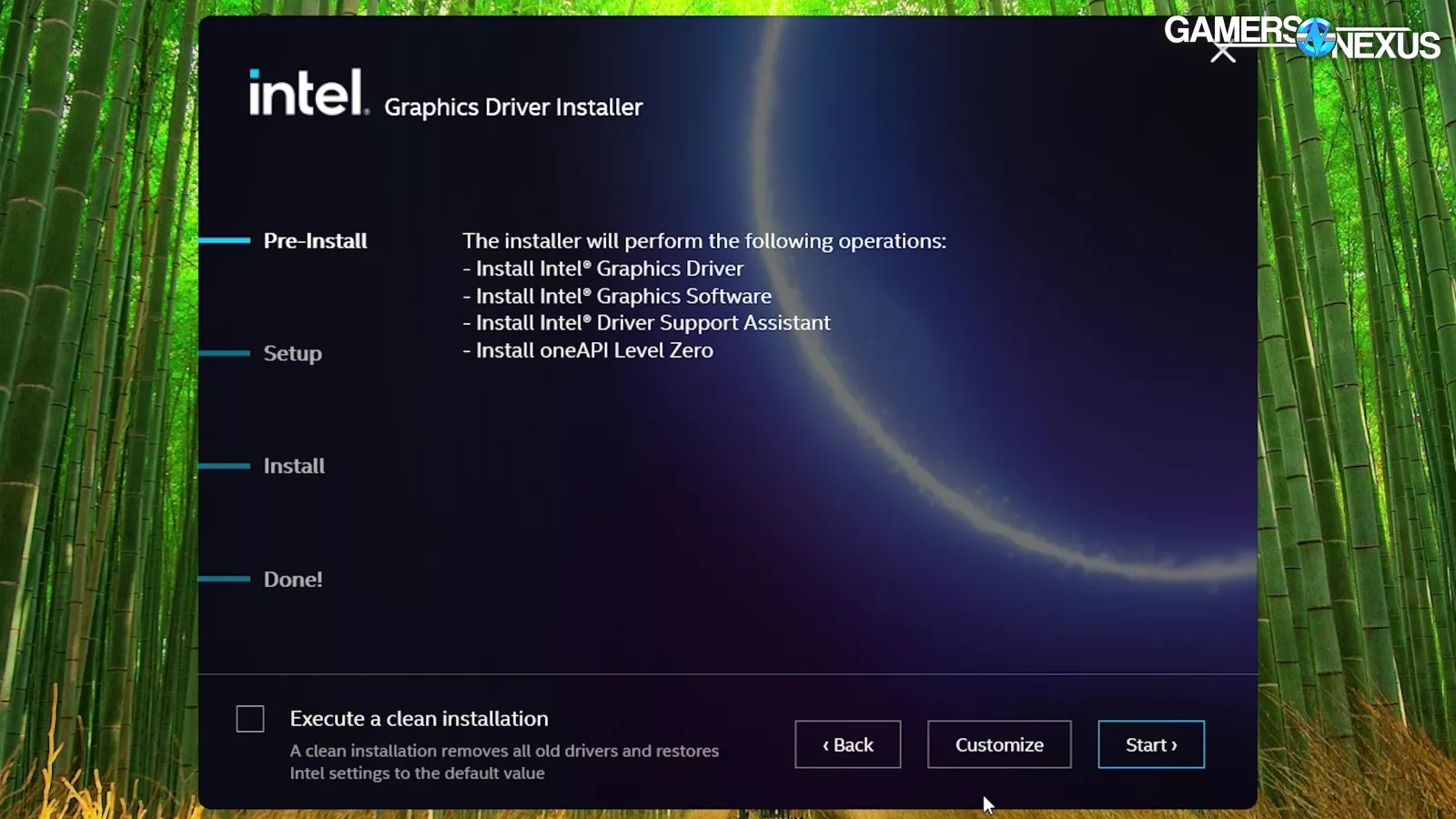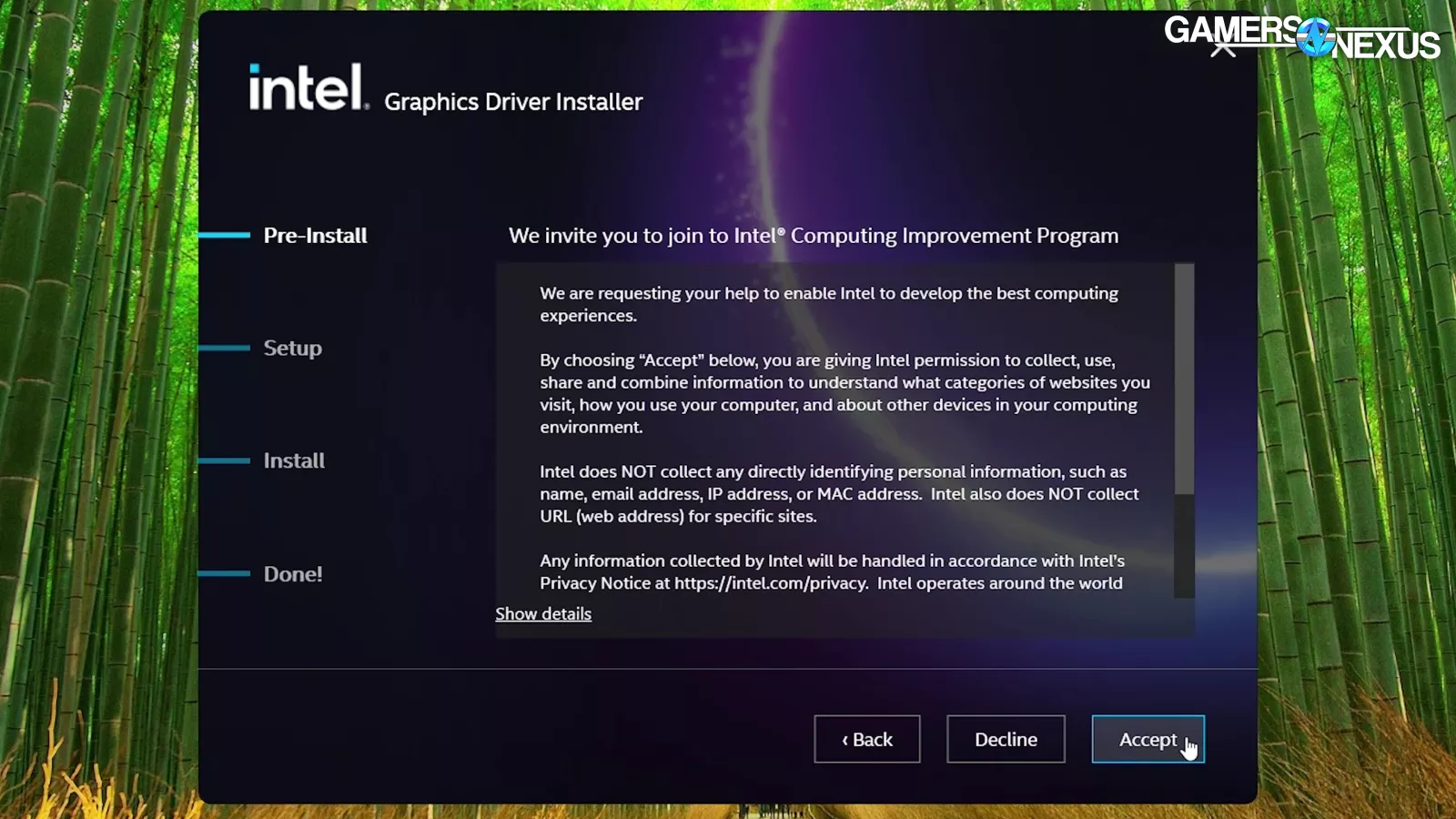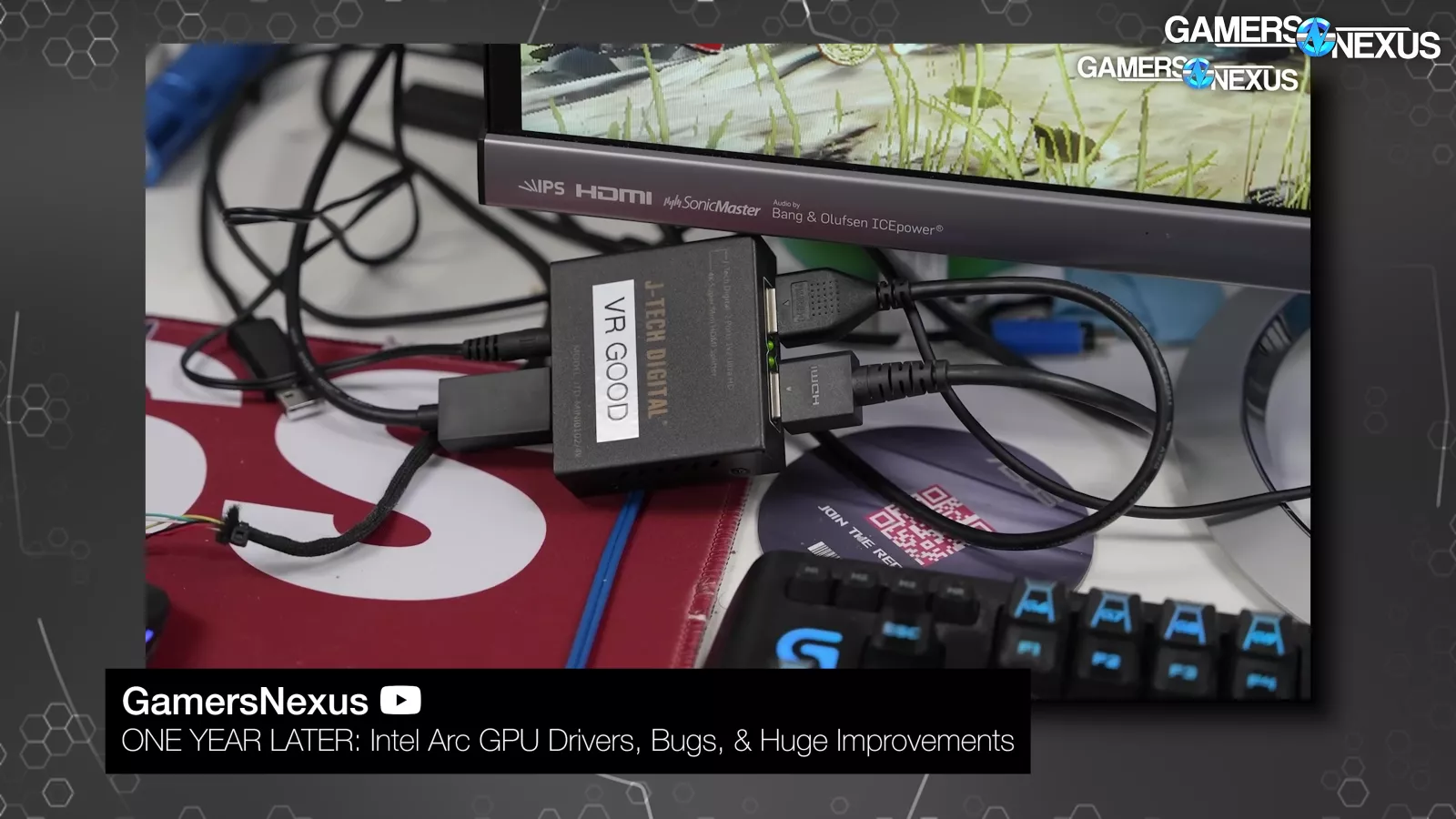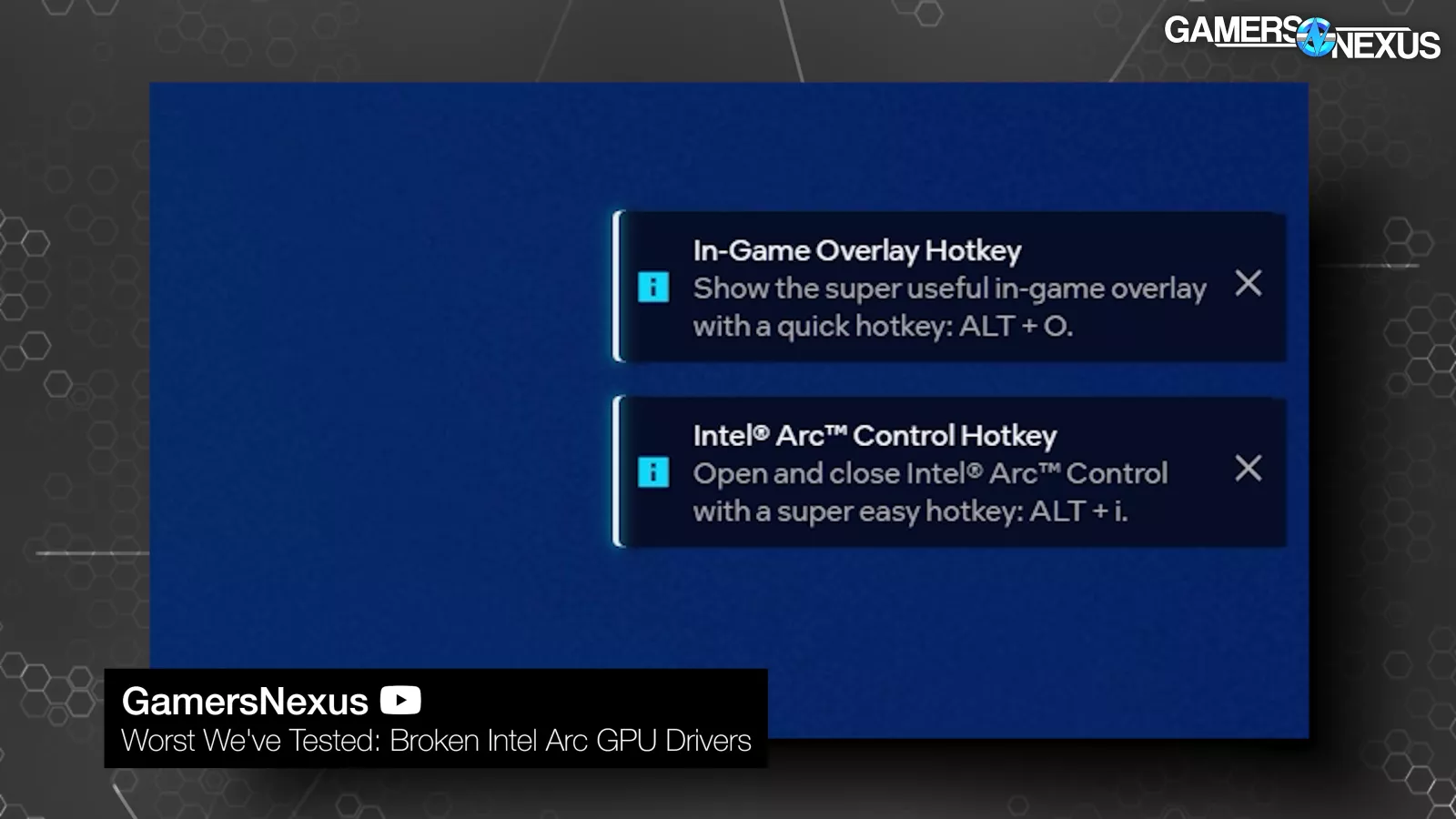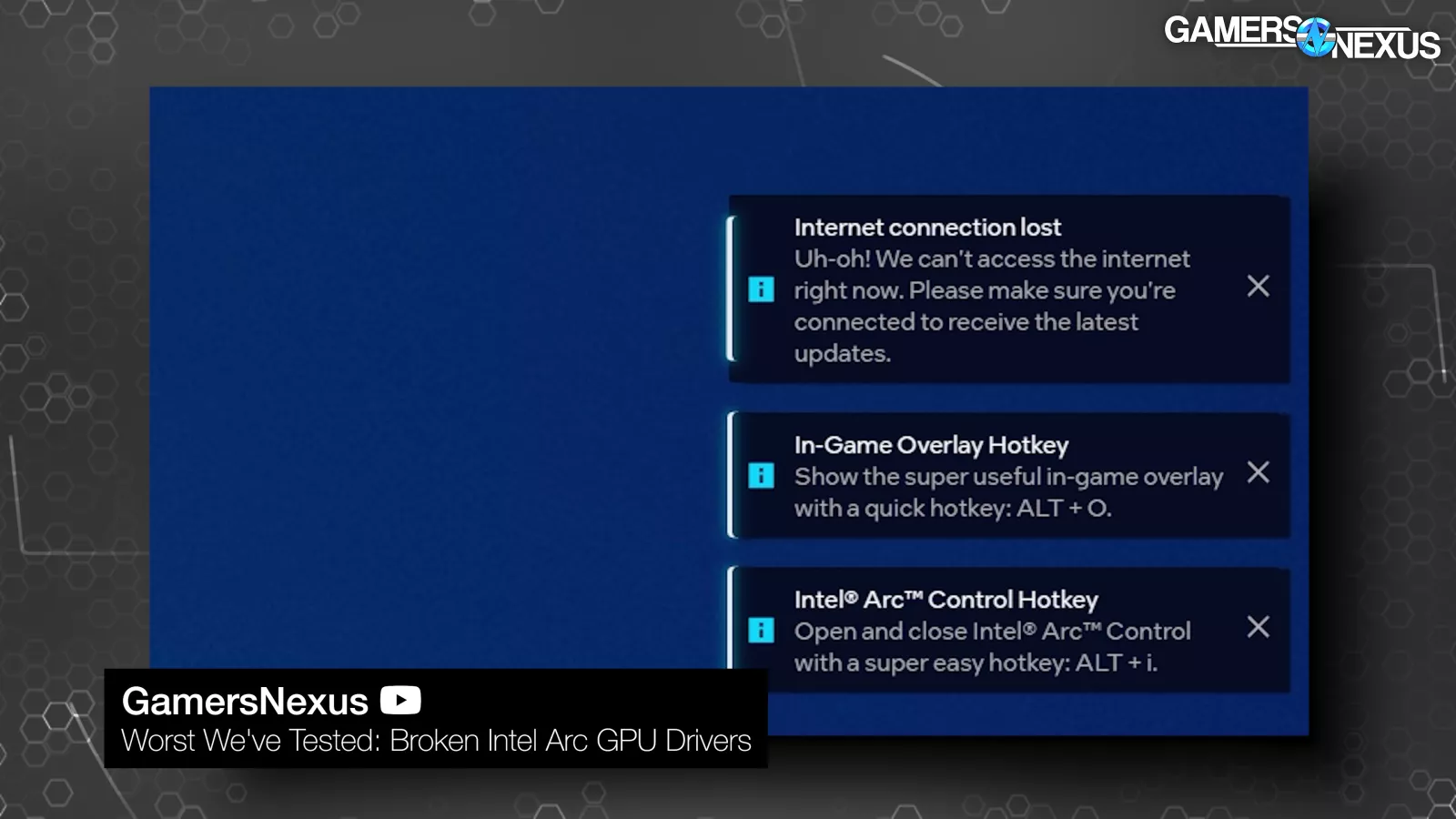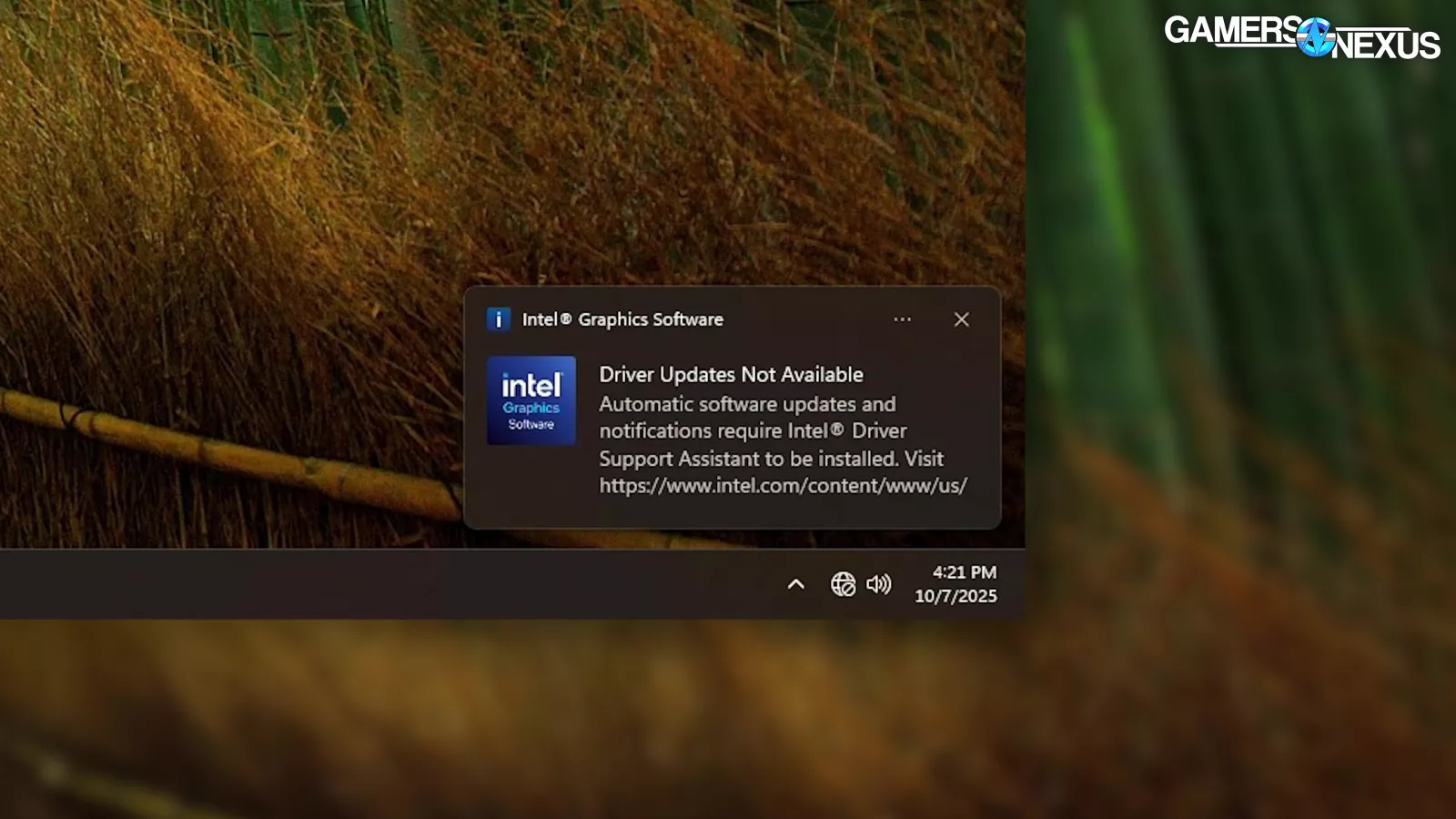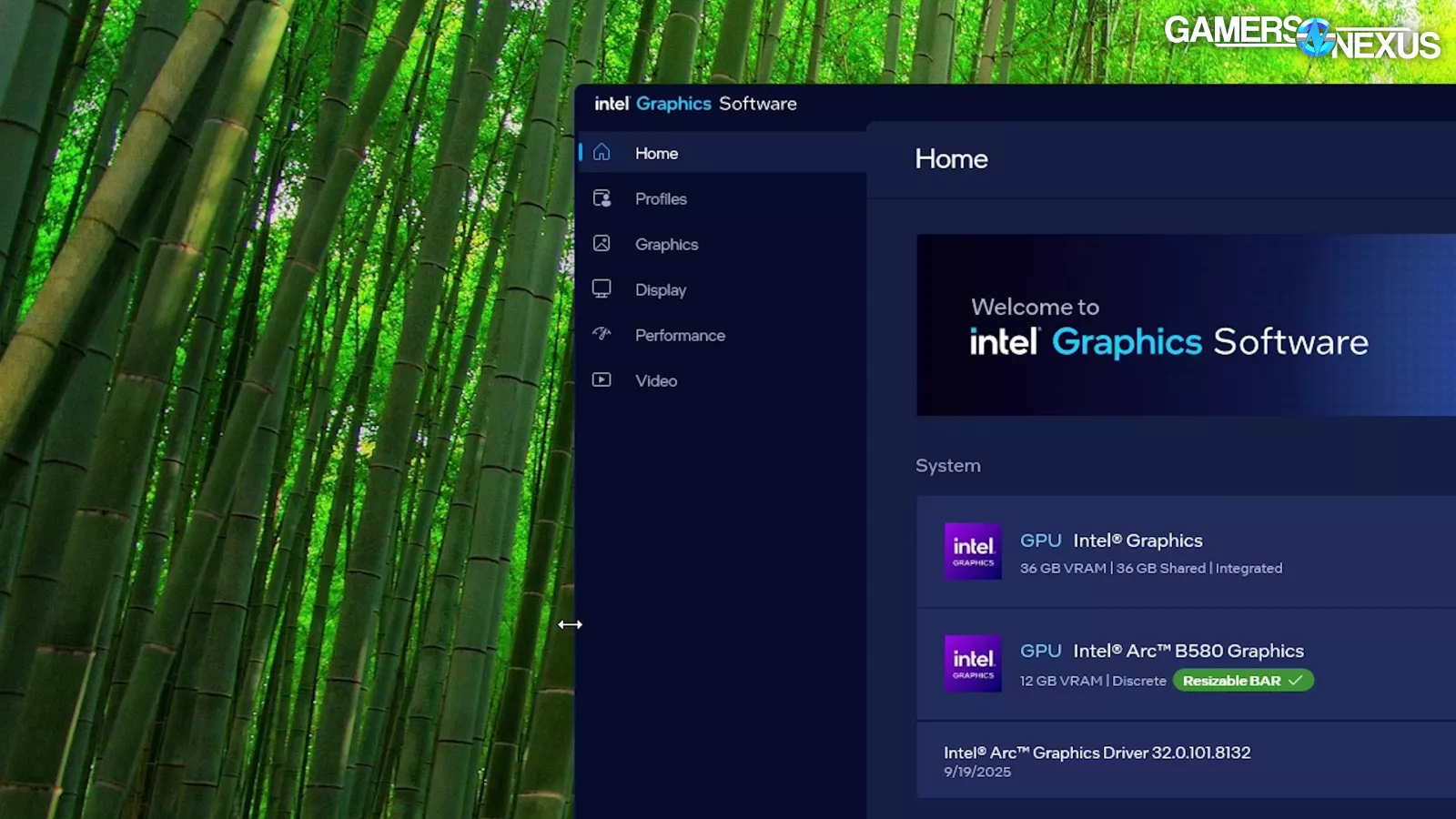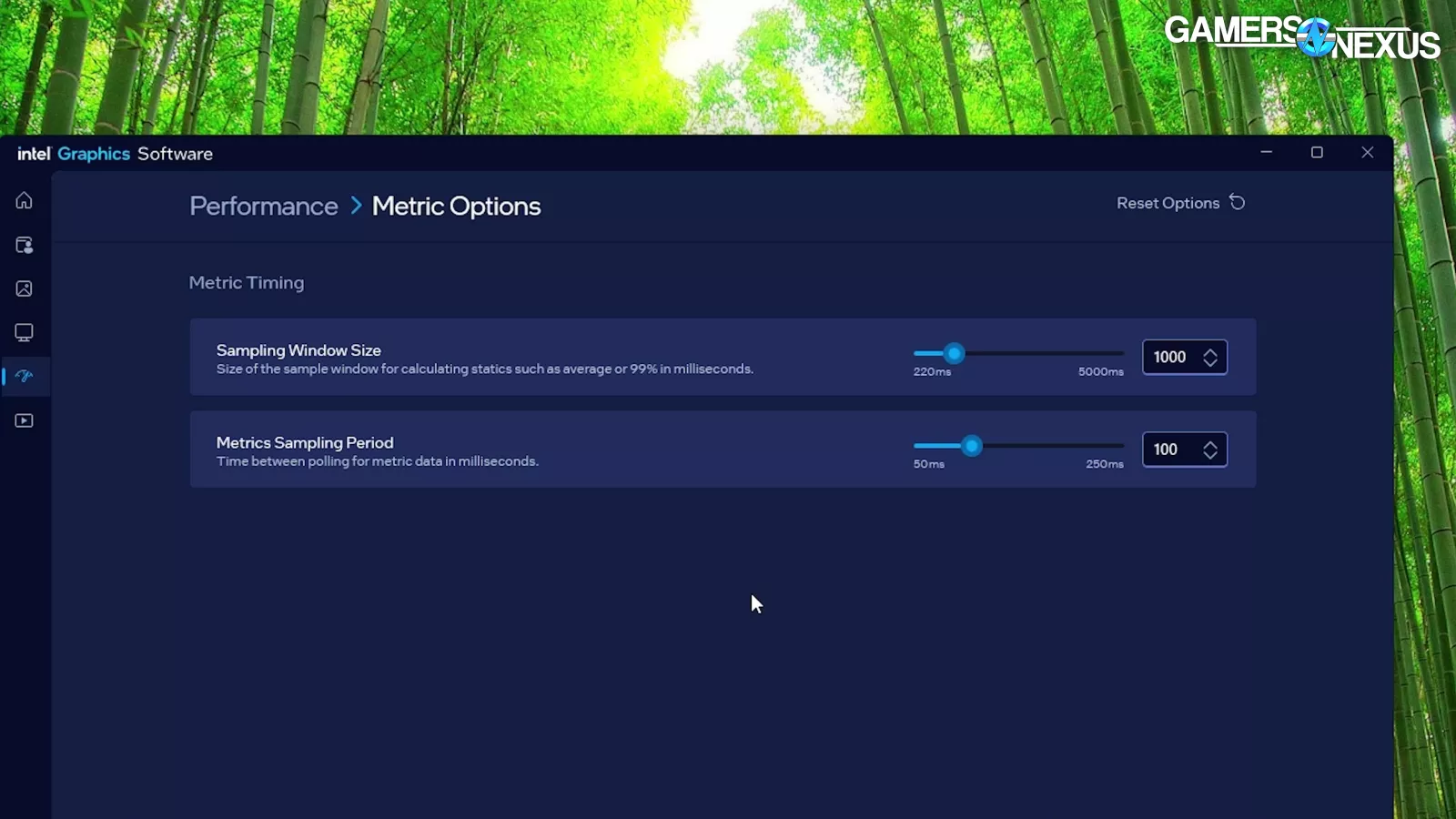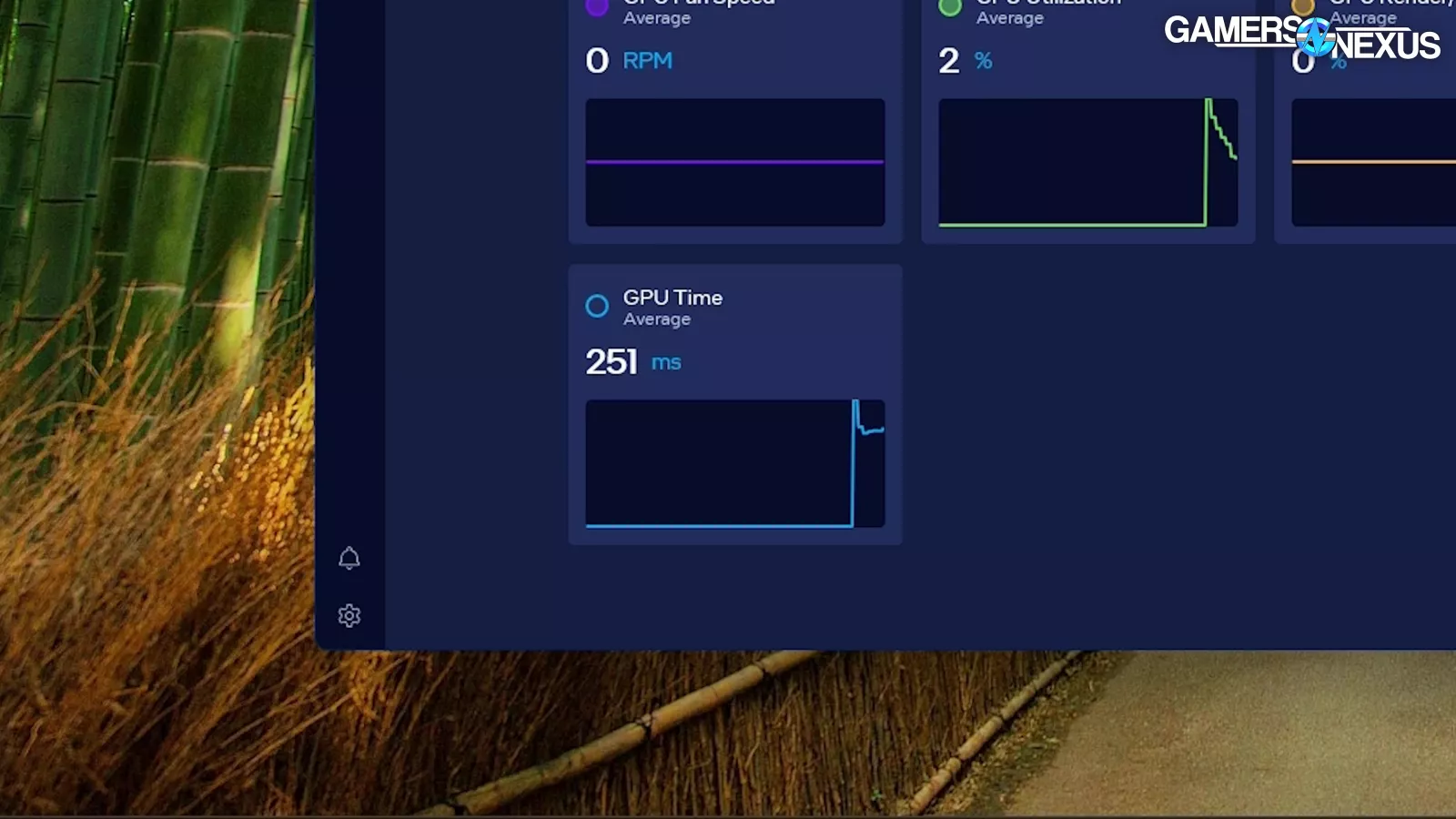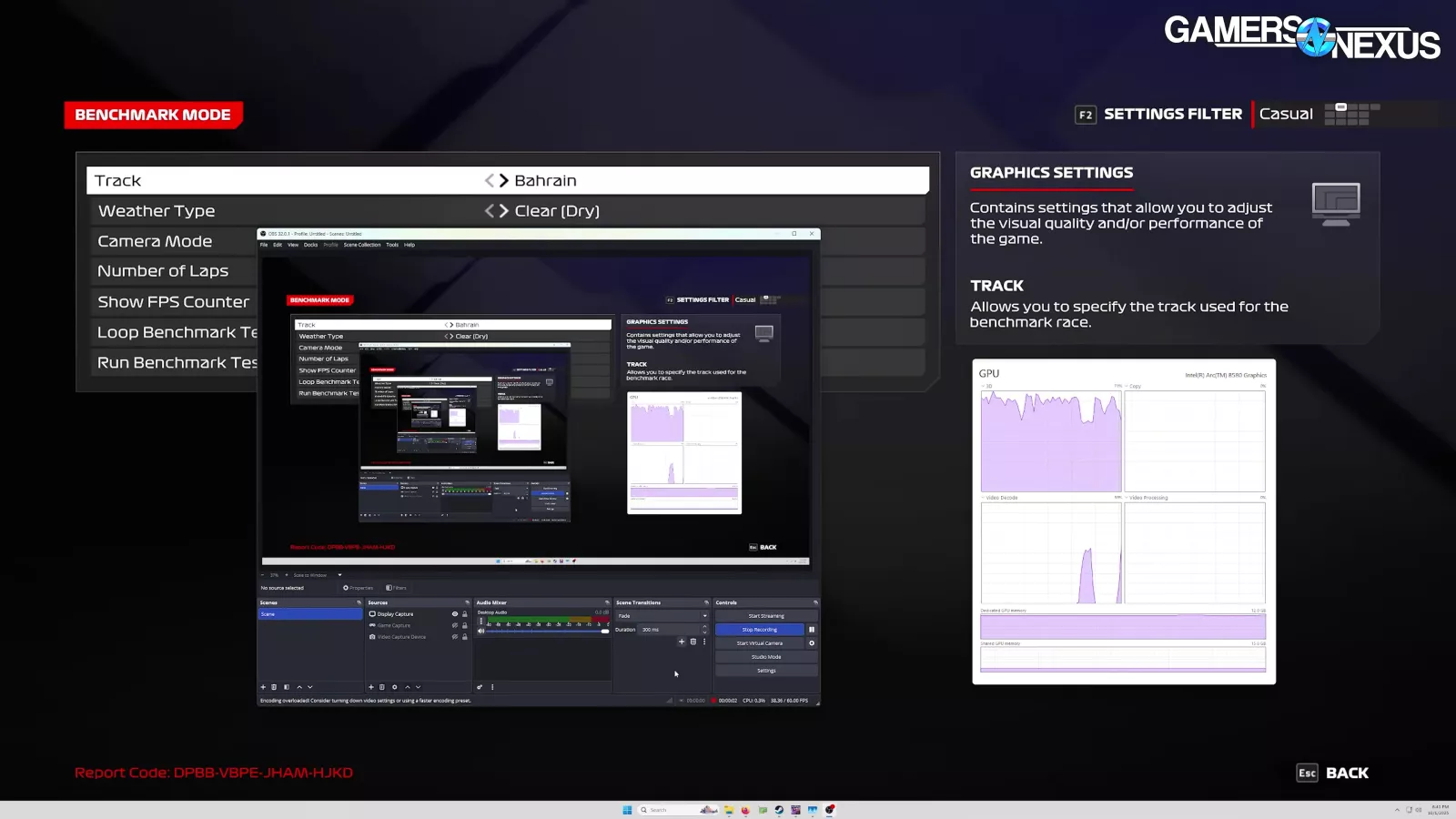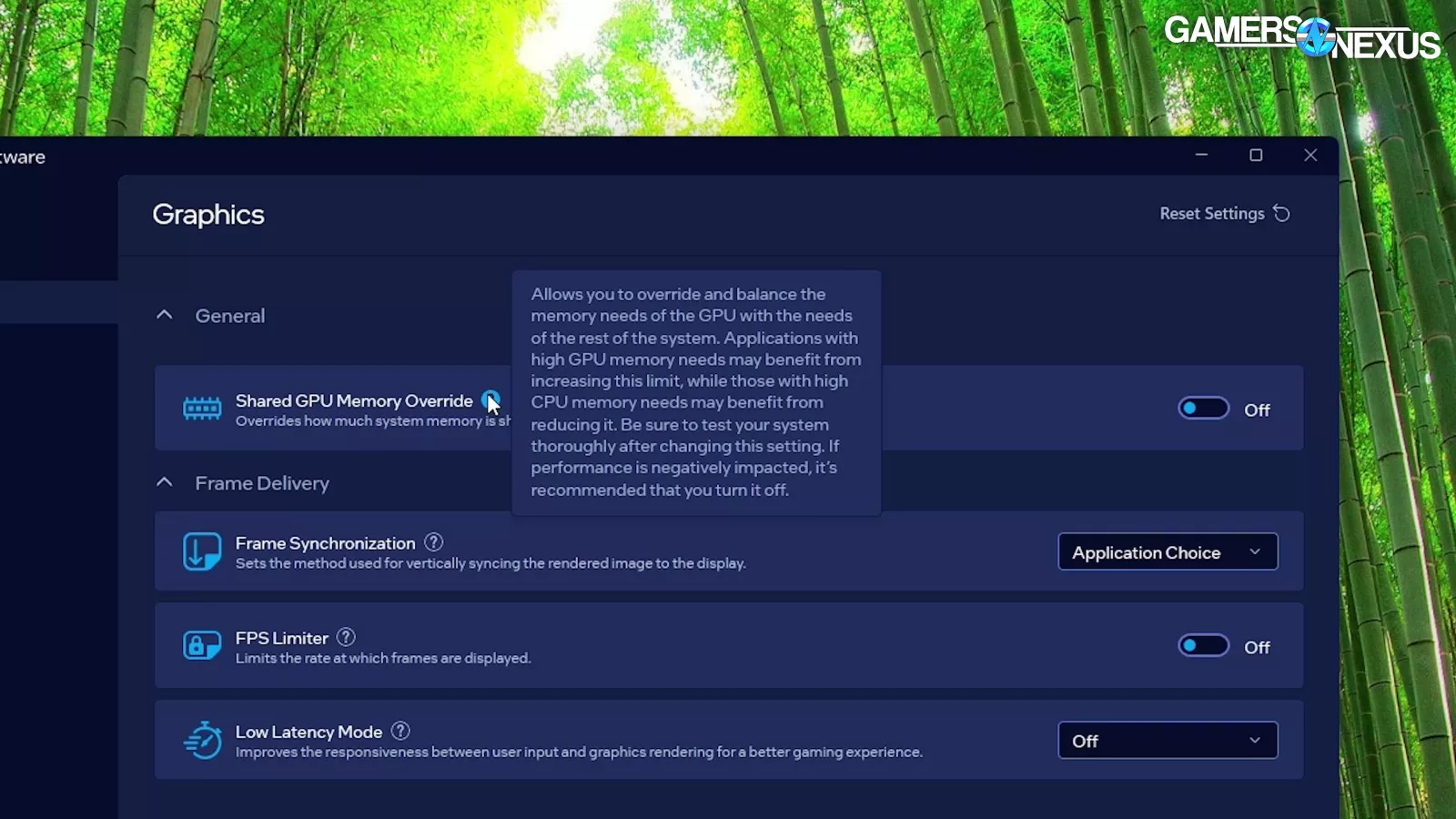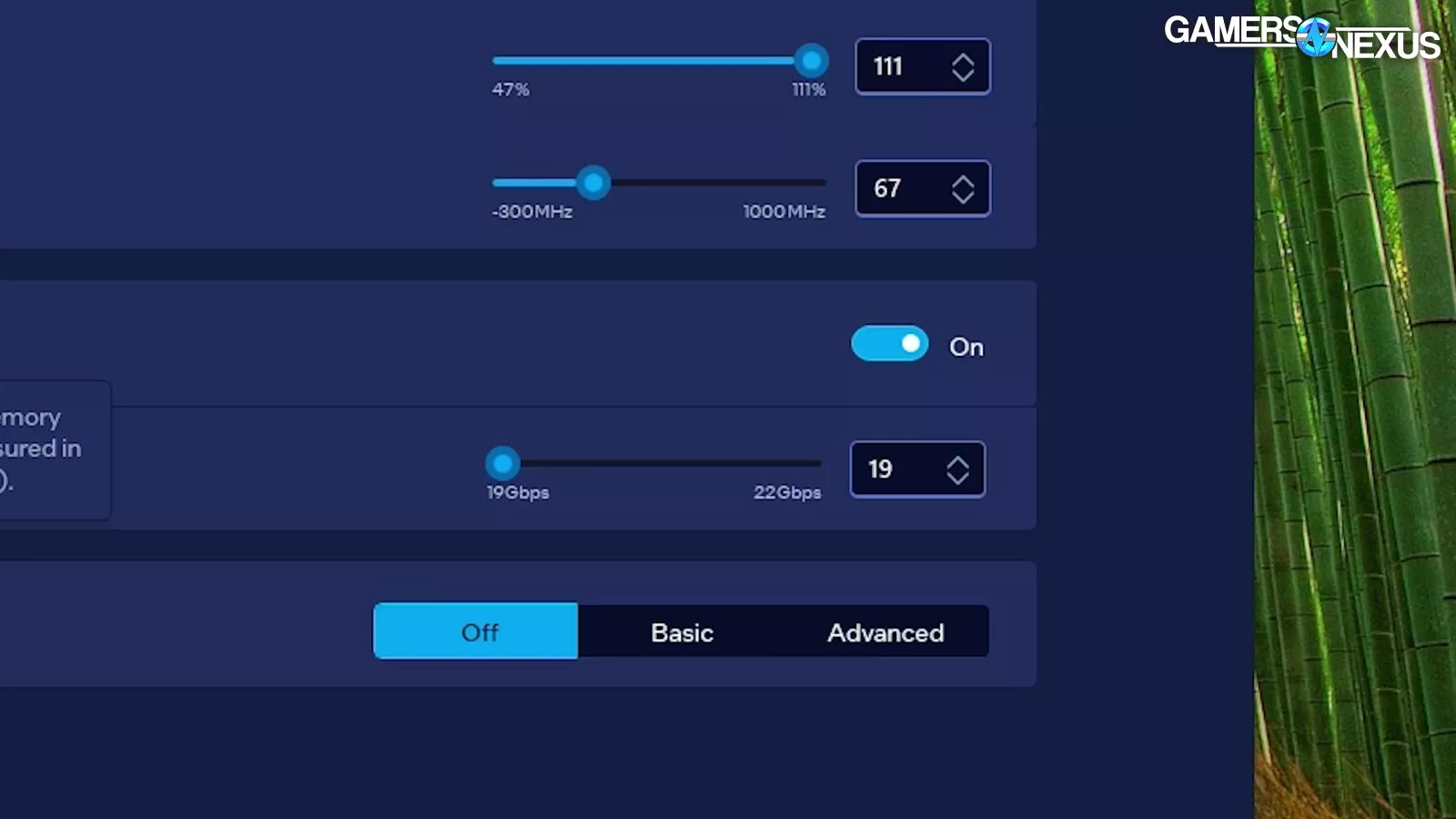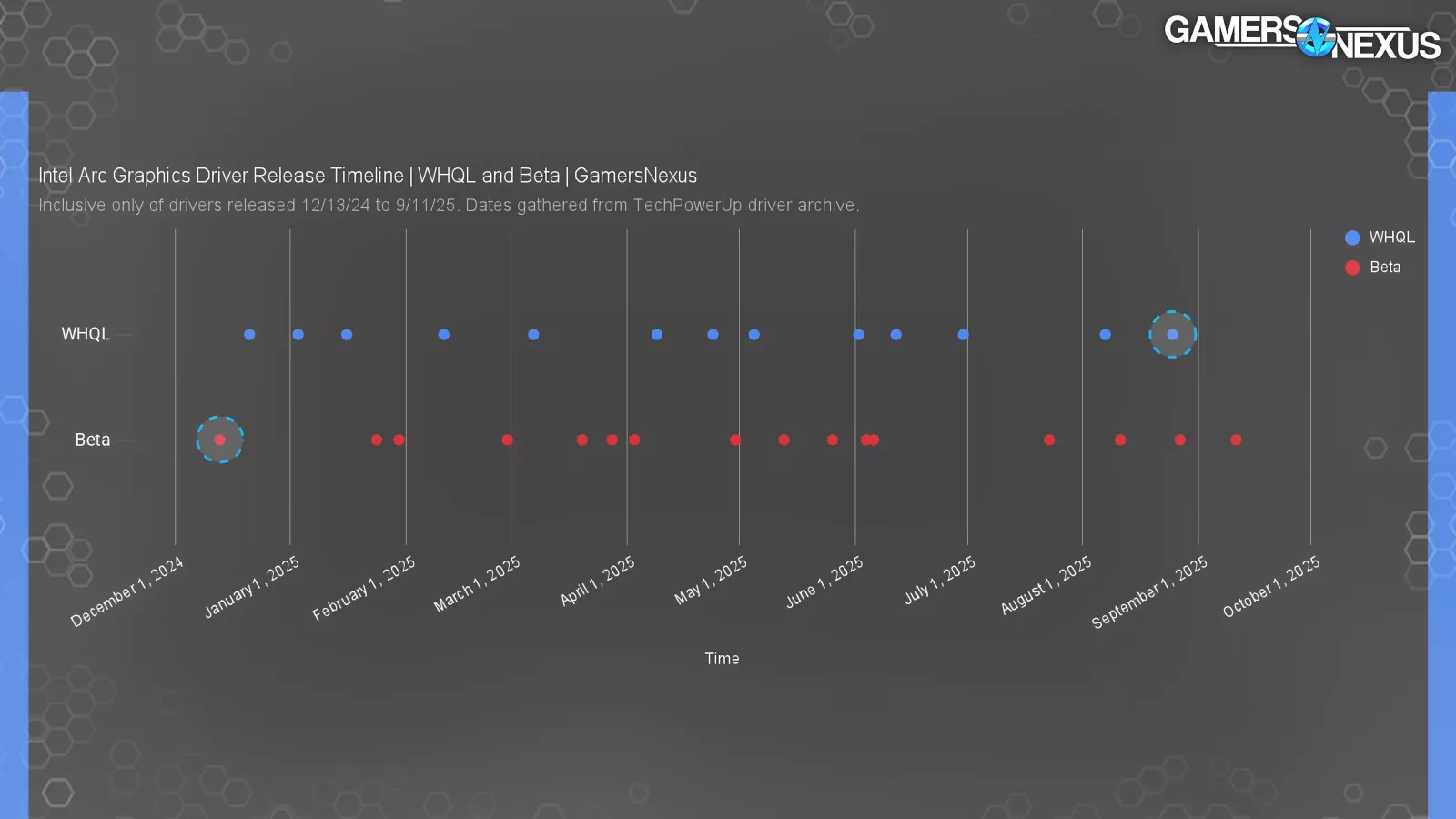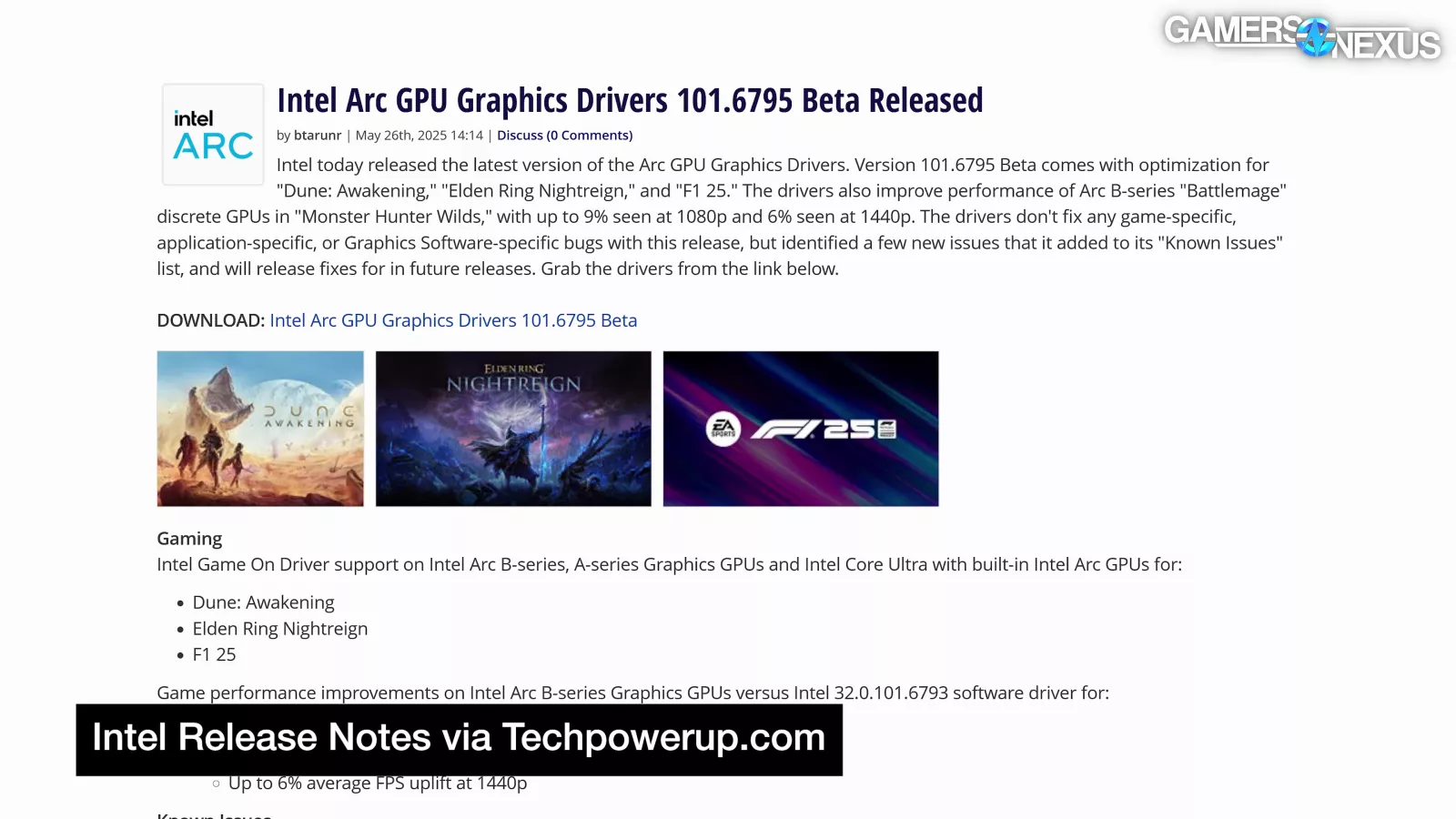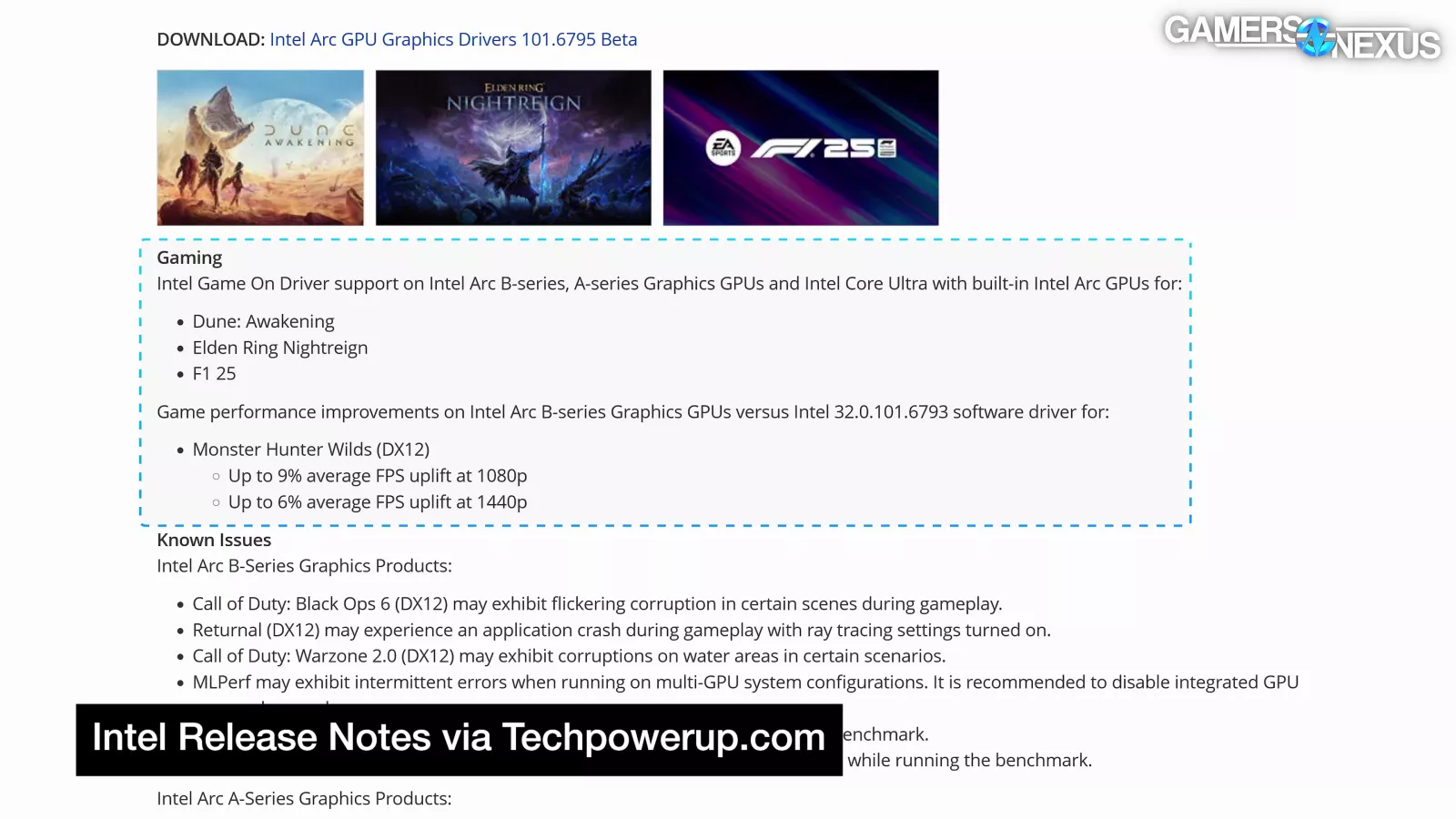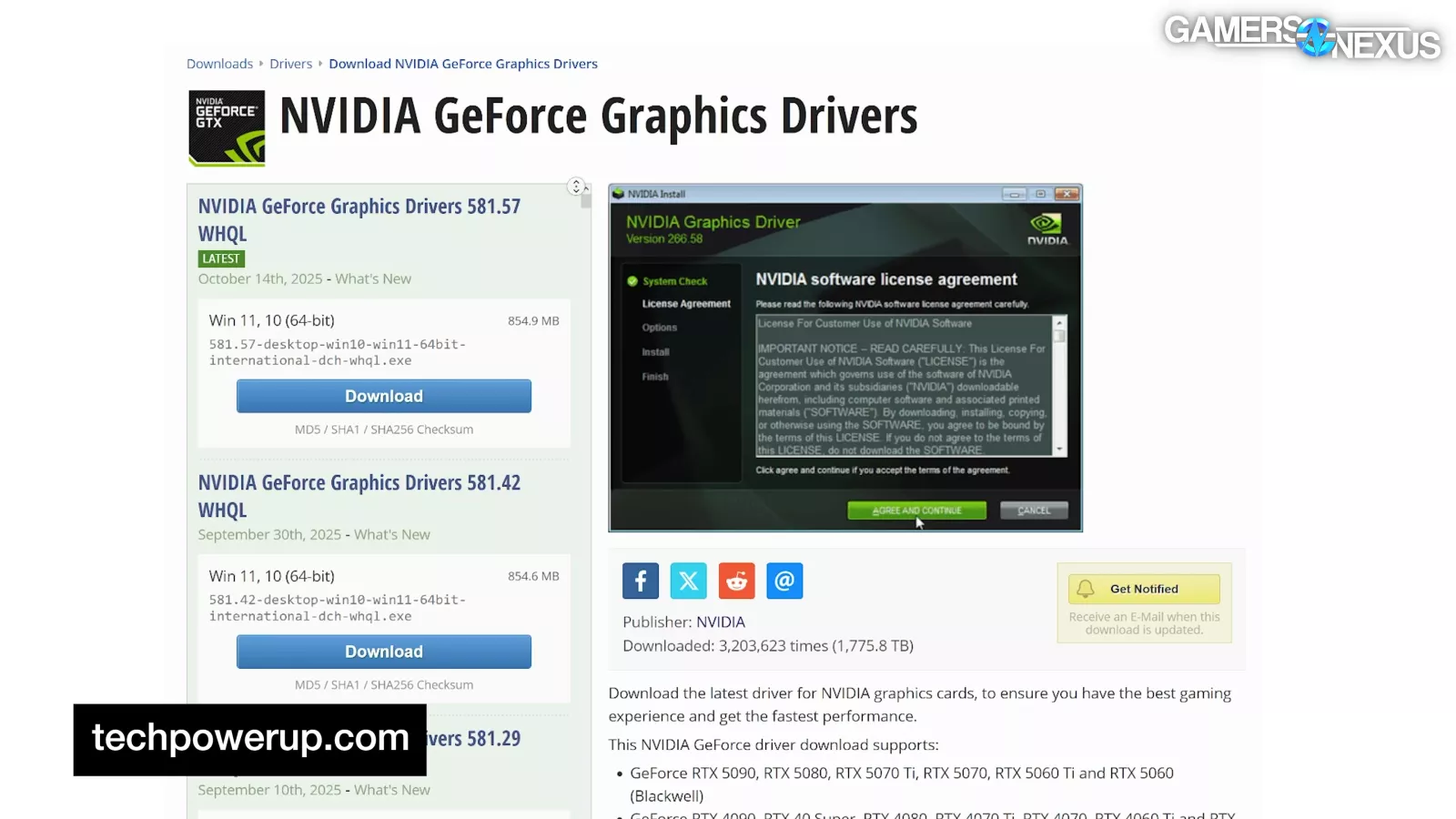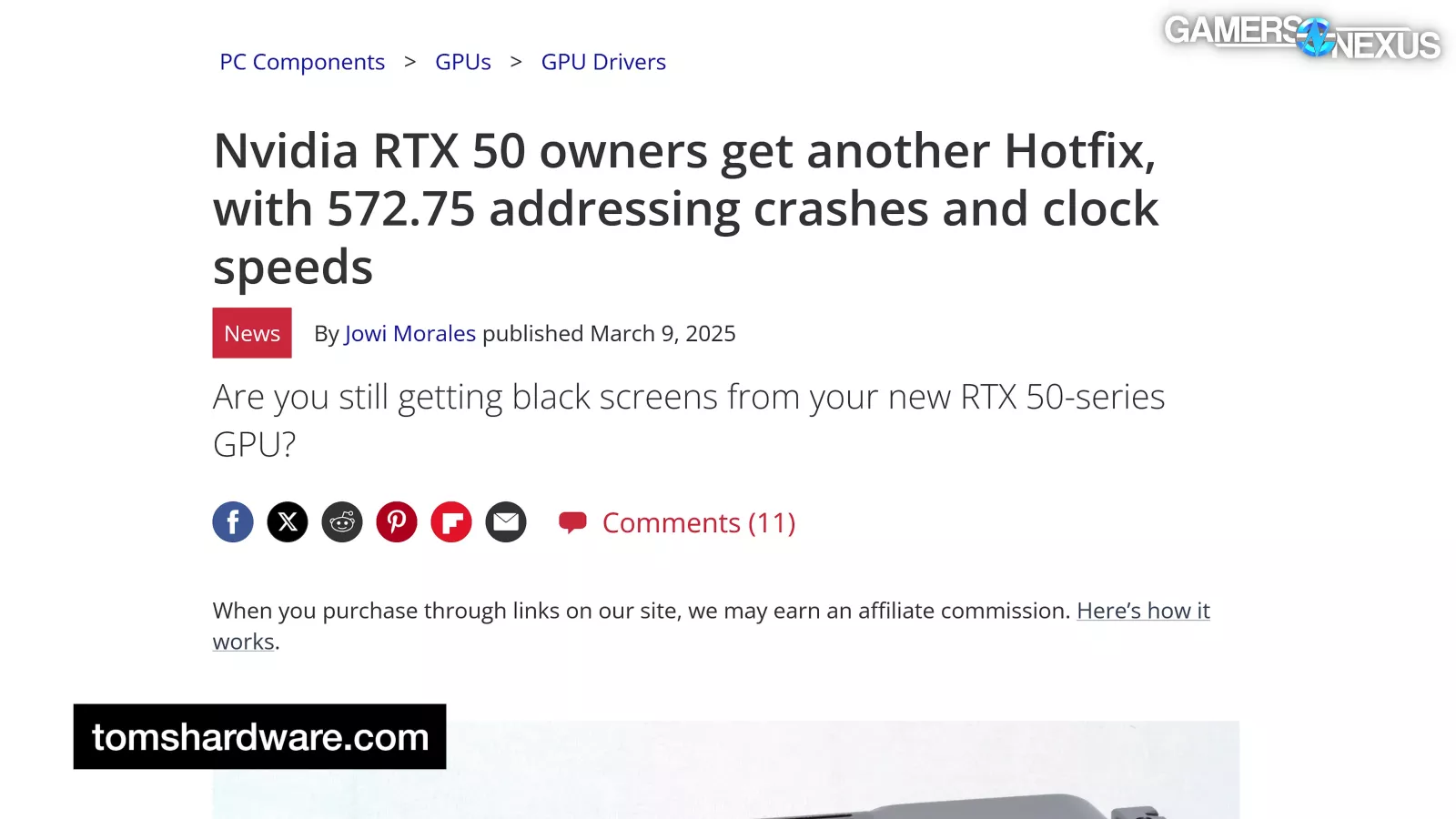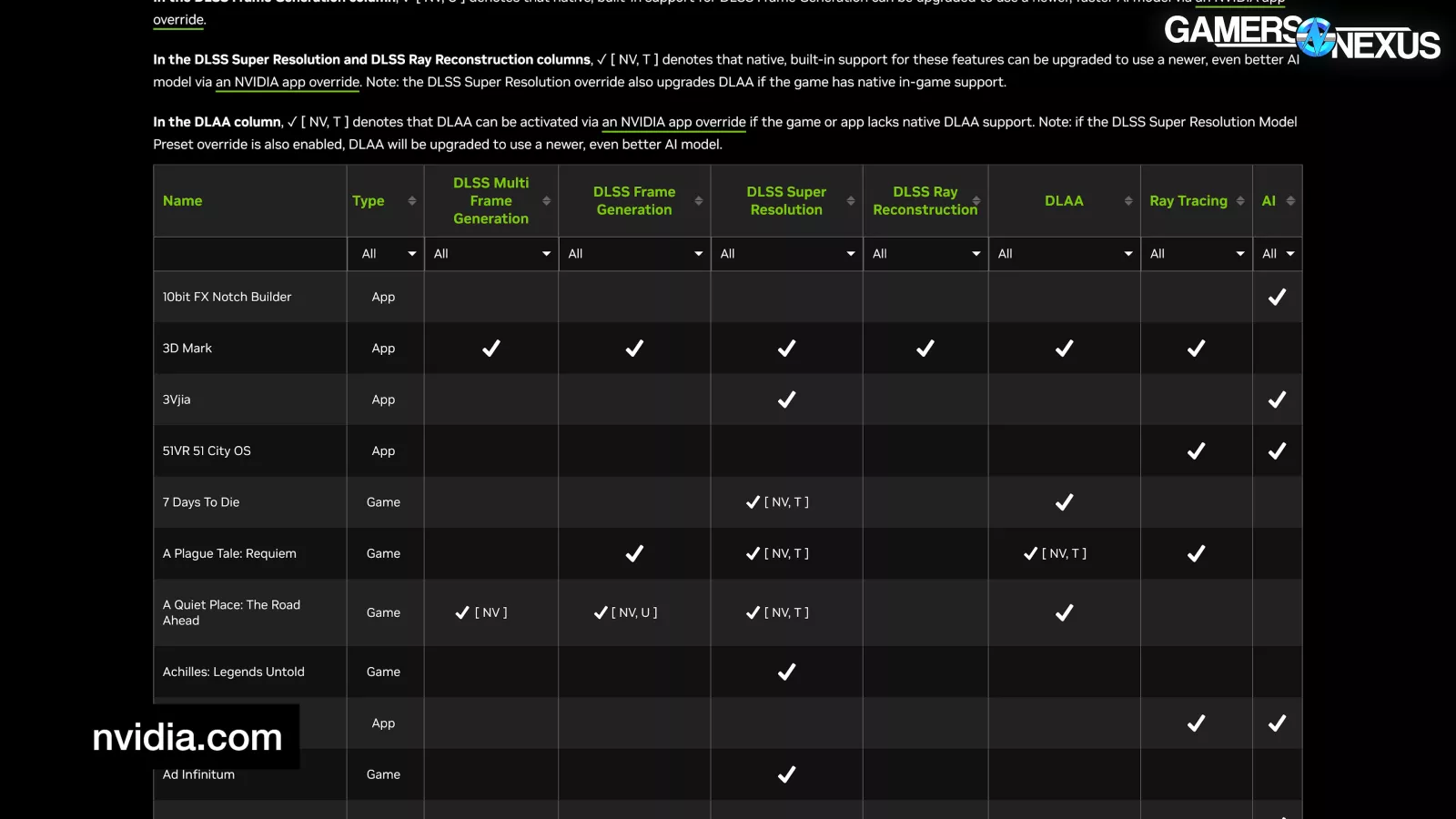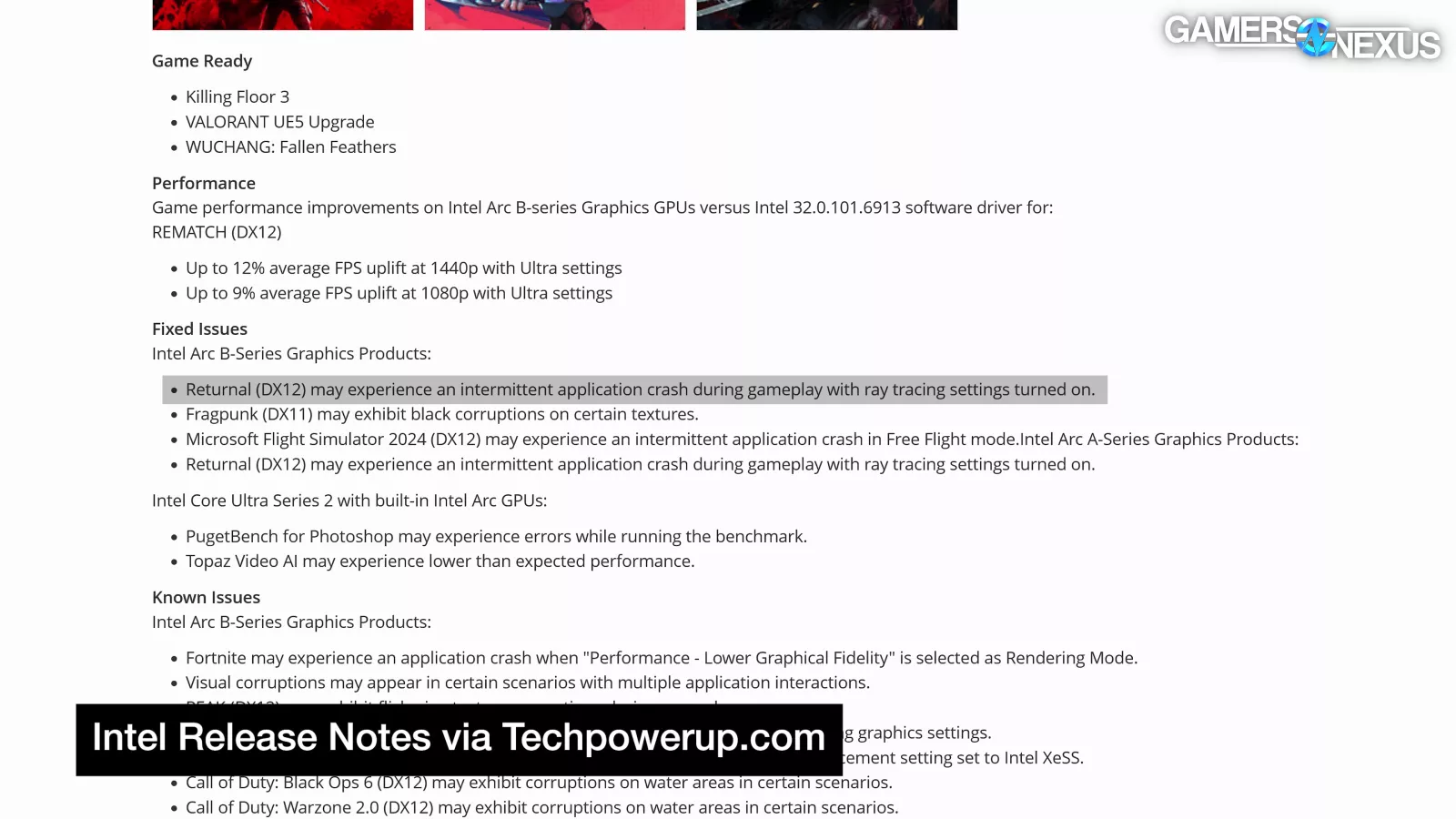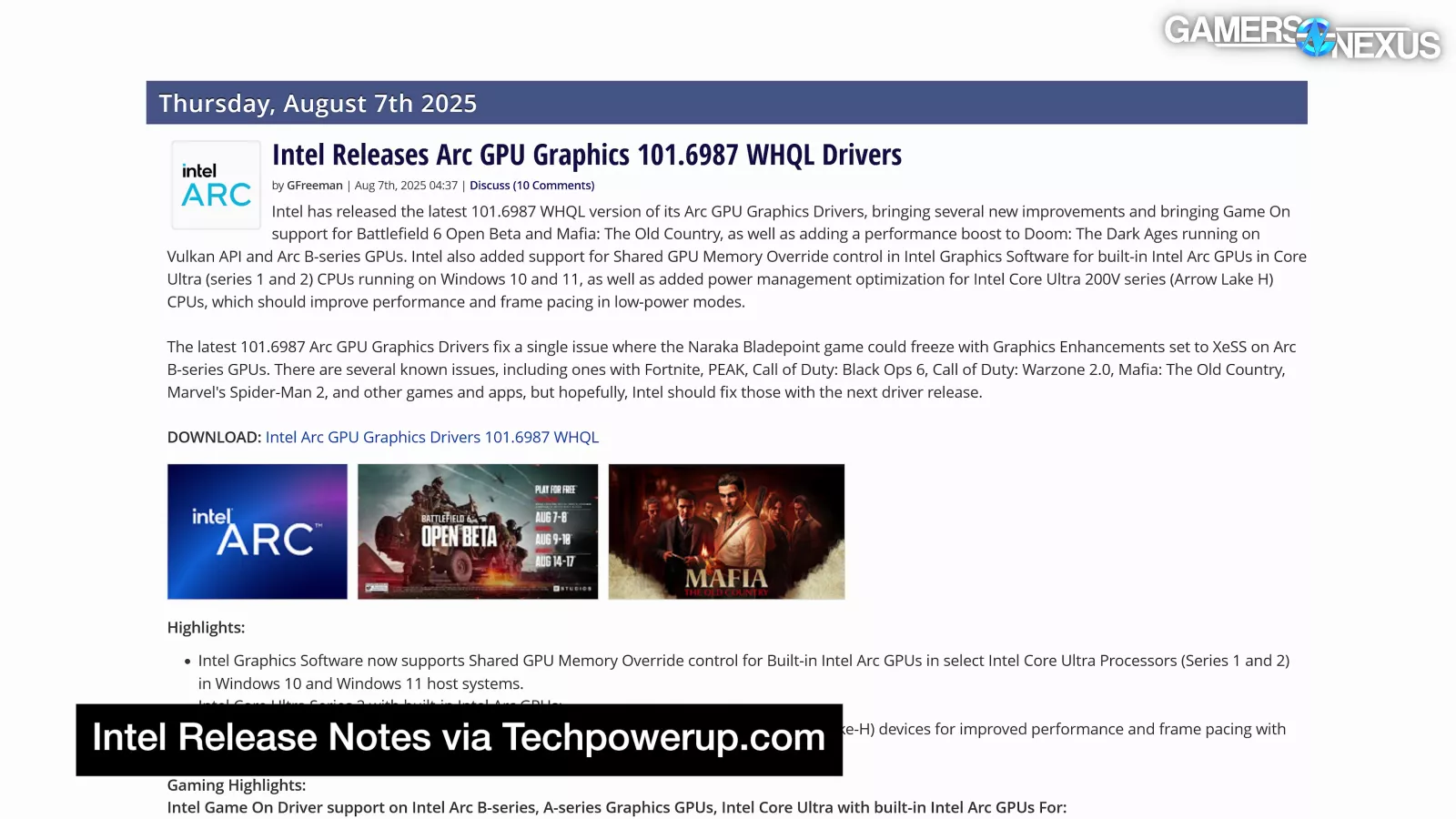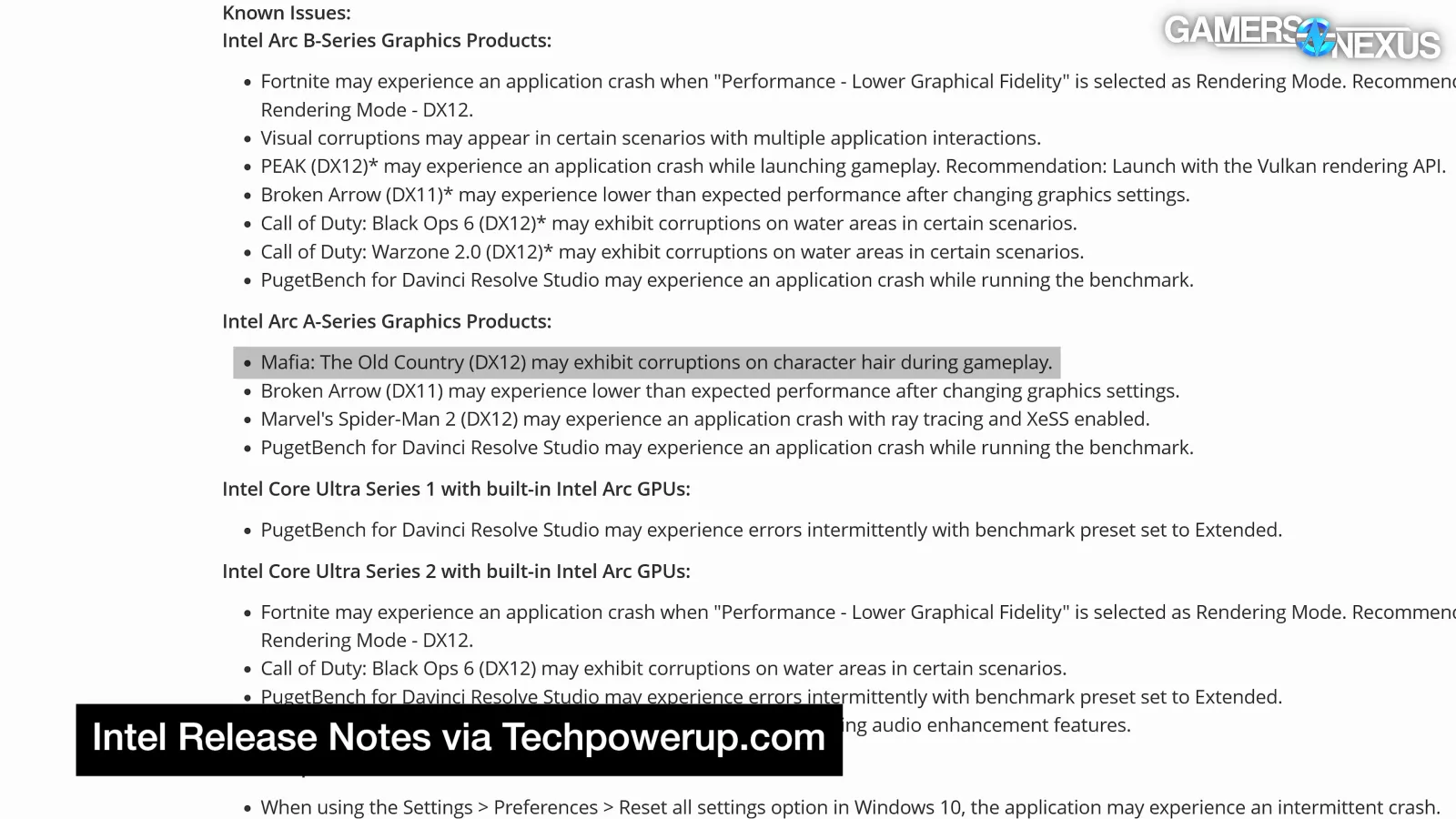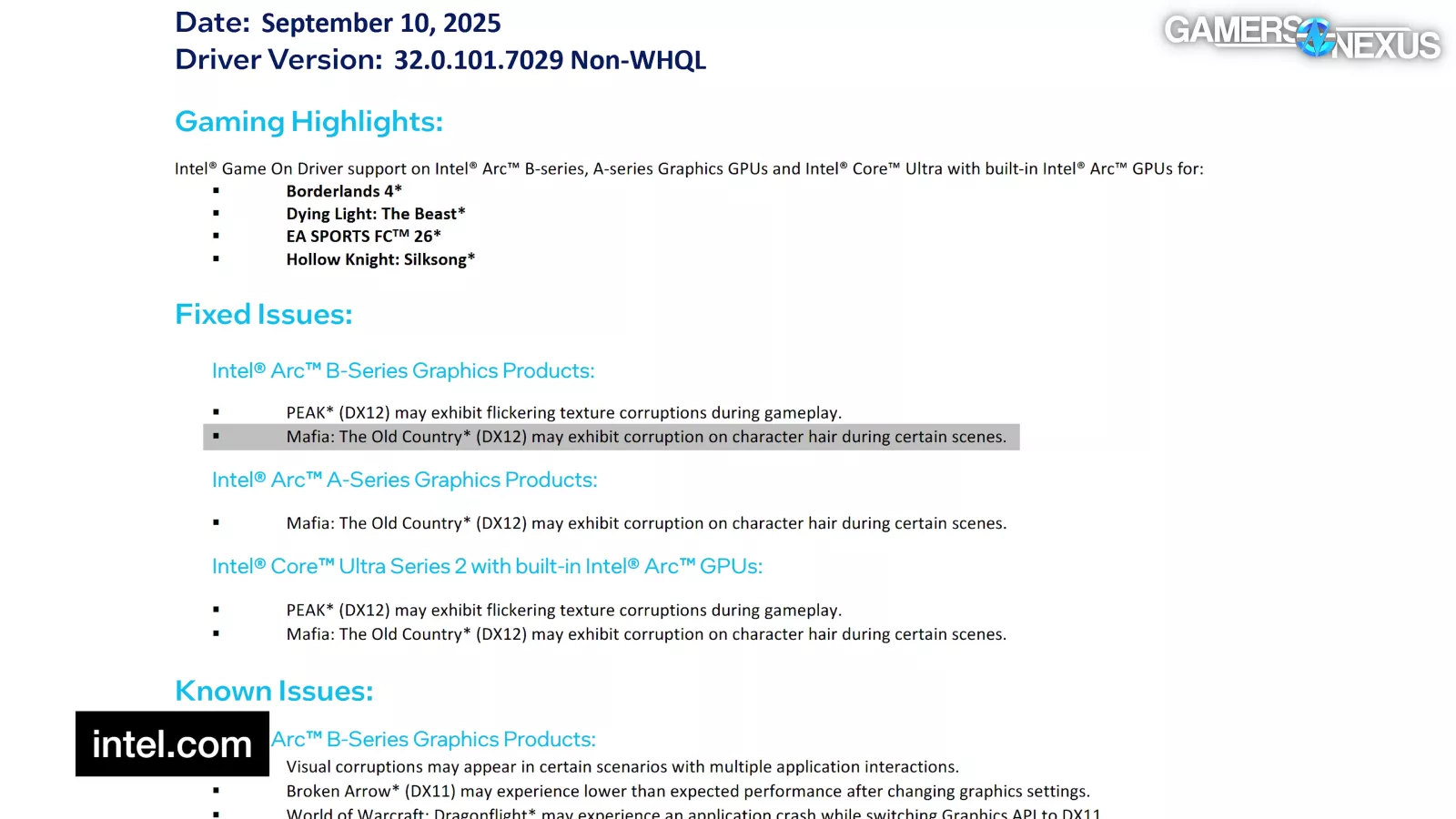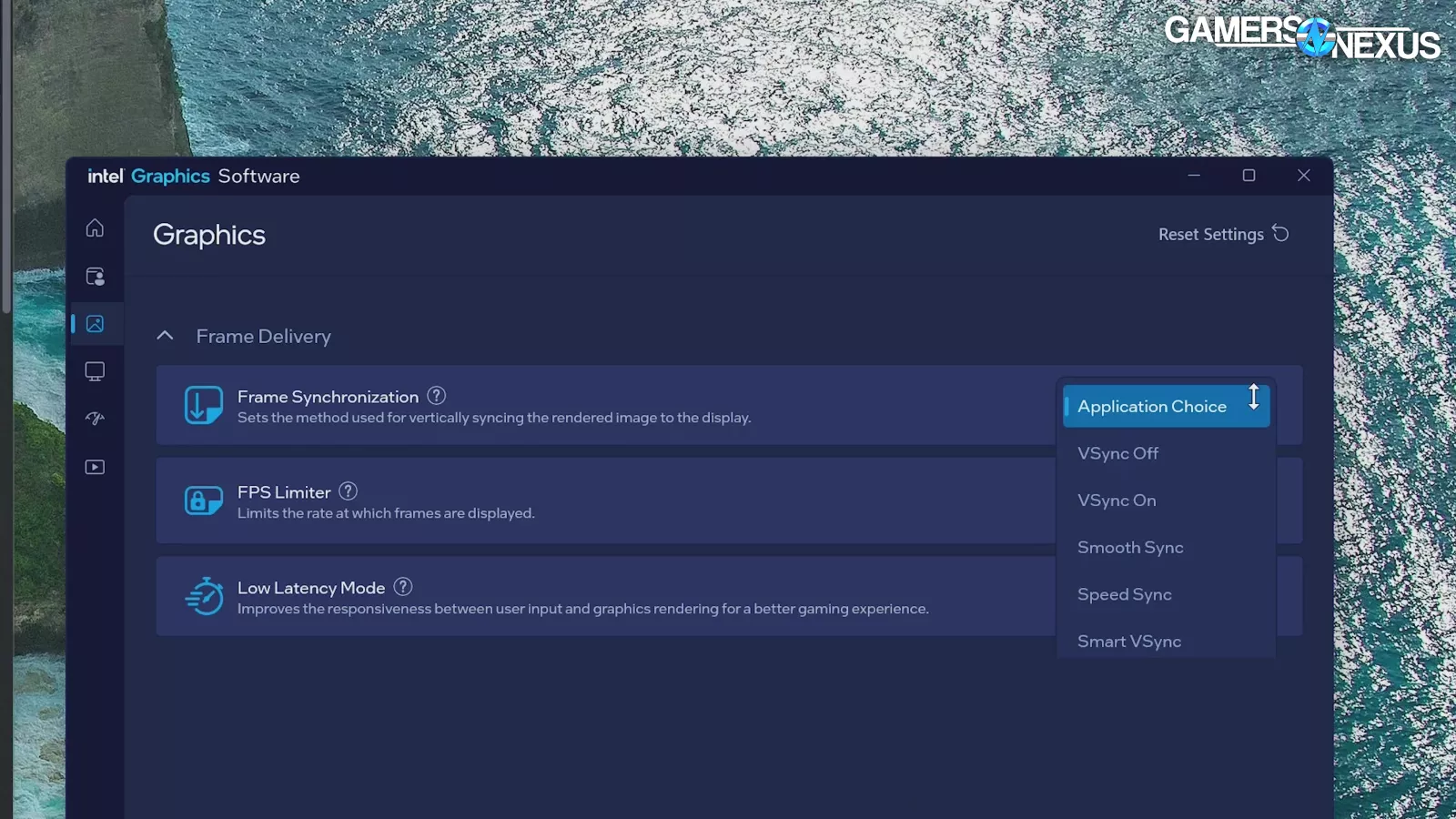
We test nearly every single button in Intel's graphics software, track 641 bugs across 10 months of updates, and more
The Highlights
- We're revisiting Intel Arc drivers in 2025 to look at the post-Battlemage, pre-Celestial GPU driver situation
- We experienced one catastrophic crash that seemed to break the drivers
- Intel’s drivers have improved significantly, but we still wouldn’t recommend the company’s Arc GPUs to those not willing to do any troubleshooting
Table of Contents
- AutoTOC

Intro
It’s time to revisit Intel’s Arc GPU driver situation.
Editor's note: This was originally published on October 31, 2025 as a video. This content has been adapted to written format for this article and is unchanged from the original publication.
Credits
Test Lead, Host, Writing
Steve Burke
Writing, Testing
Jeremy Clayton
Video Editing, Camera
Tim Phetdara
Writing, Web Editing
Jimmy Thang
We built a gigantic spreadsheet to track 641 issues across Intel’s Arc GPU driver software for the past 10 months, compiled the driver release timeline to see how committed Intel is to new game releases and their speed of driver launches for those games, checked the game-ready driver launch lag, and clicked nearly every single button in Intel’s graphics software to see what features are broken -- and out of all of that, we only had one catastrophic crash that seemed to break the drivers.
And to be fair to Intel, that is a massive improvement from when we first tested their driver software.
Intel Arc GPUs have been around for over three years now, from the “Alchemist” A380 (watch our review) in July of 2022, to the B580 (read our review) and B570 (read our review) 10 months ago, to now. It’s been a real rollercoaster of ups and downs.
In this story, we’re focusing fully on Intel’s driver updates, patch cadence, and bugginess. This is our second revisit and third in the series to see how Arc is progressing. Instead of focusing on performance this time, we’re looking at how actually usable the drivers are since Intel is the newcomer to this space.
Overview
We have two sections to this: Intel’s driver update timeline and its bugfix consistency for one, then positive features, bugs, issues, and usability annoyances in Intel’s current graphics software.
Outstanding Issues From Our Last Revisit
Now we’re escaping the patch notes to revisit the issues that we specifically mentioned as unfixed or semi-fixed in our One Year Later piece. If any of these are still around after two years, we have a big problem.
We’ll start with a recap of existing and prior broken features, bugs, and shortcomings to see where Intel has improved, then move to their driver update cadence.
Crash that Broke the Driver

Back when Arc launched, we experienced a lot of driver crashes and occasional driver corruption. That’s improved, but isn’t fully resolved.
This time, we had one really bad situation where IGS locked up and eventually crashed when we used the embedded link to the Windows display settings menu from the IGS Display tab. After restarting IGS, the performance metrics were humorously broken, showing extremely high numbers of “Raw” type, which you can't even pick under normal circumstances.
After rebooting, we didn’t get any video out to the monitor beyond the Windows 11 loading spinning graphic. This is when the graphics drivers are loaded, so it seemed the crash cooked the driver to the point of being nonfunctional. Reinstalling it fixed this, but we couldn’t replicate the problem a second time.
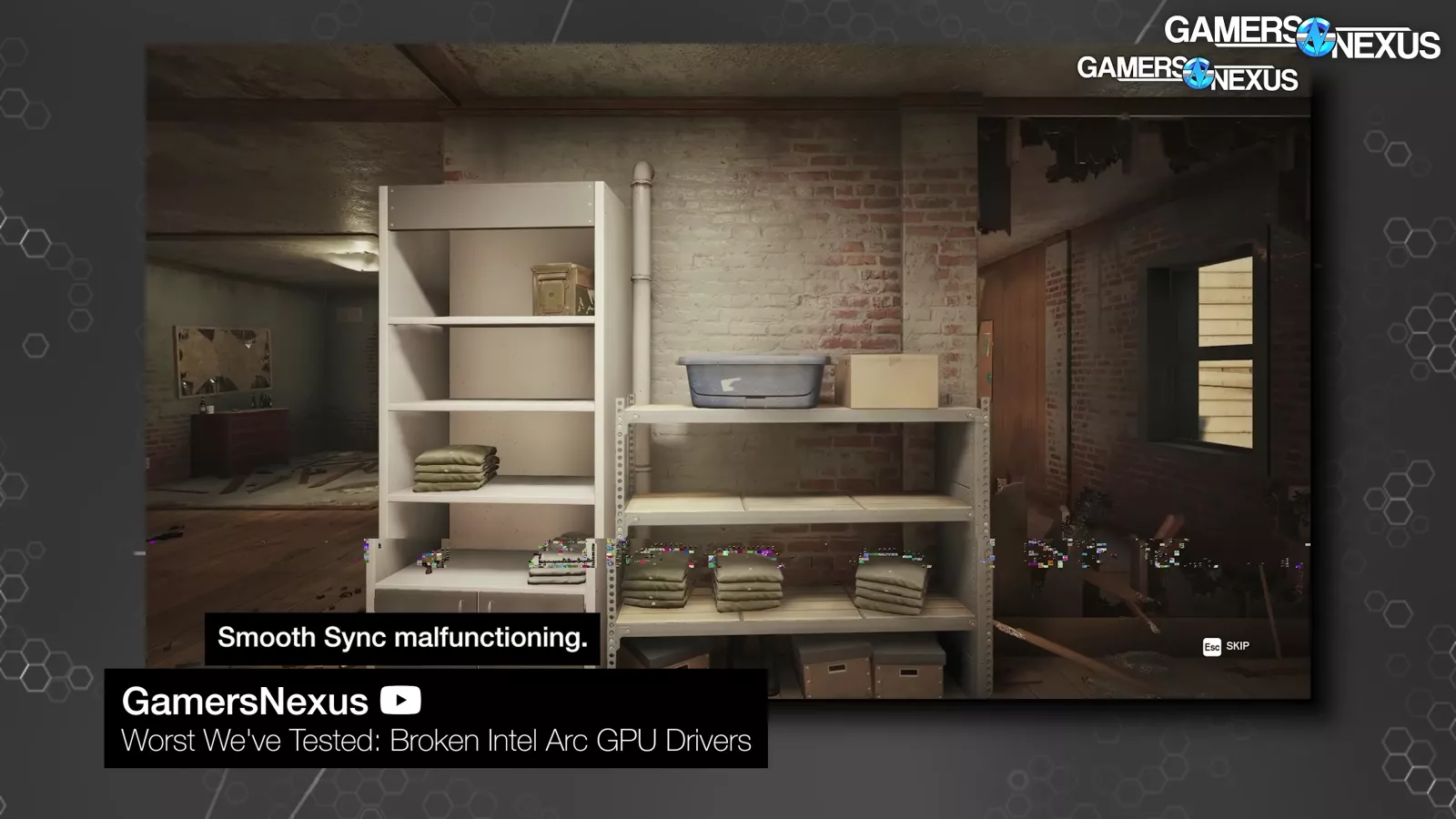
Happening once is still a problem. Intel has to fix these high severity issues of crashing and driver corruption long-term to win over users out of the enthusiast base.

It’s easy to say “it only happened once,” which is true, and a lot of our audience can deal with that. But this is the distinction between Intel and more established companies in graphics -- not that NVIDIA’s drivers have been particularly good this year.
Smooth Sync
Smooth Sync is up next, which is different from other forms of frame synchronization in that it doesn’t prevent tearing, but instead adds a dithering effect on the border between torn frames on screen. It originally had issues with visual corruption in several games, one of which was Rainbow Six: Siege. We showed this in our original driver check-in, leading to Intel disabling it in problematic titles. This was their “fix.” It’s certainly hard to have feature problems if the feature no longer exists in the game.

We decided to test Smooth Sync in Siege X.
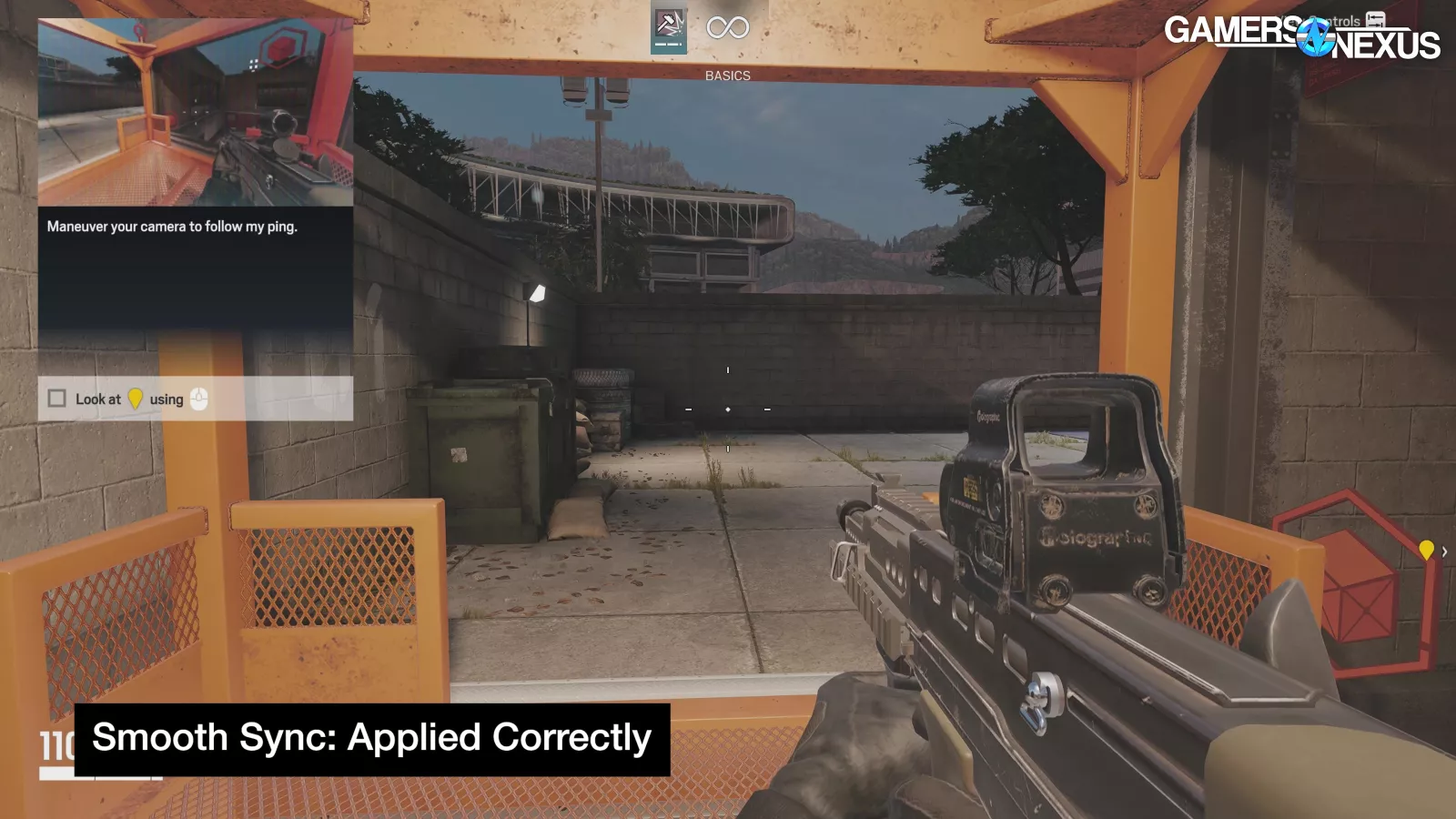
To Intel’s credit, Smooth Sync works correctly in this title. The dithering also seems cleaner now than when we last looked at it. We aren’t convinced that it actually makes it nicer to look at, but what matters is it isn’t just broken. This issue seems to be resolved.
Speed Sync
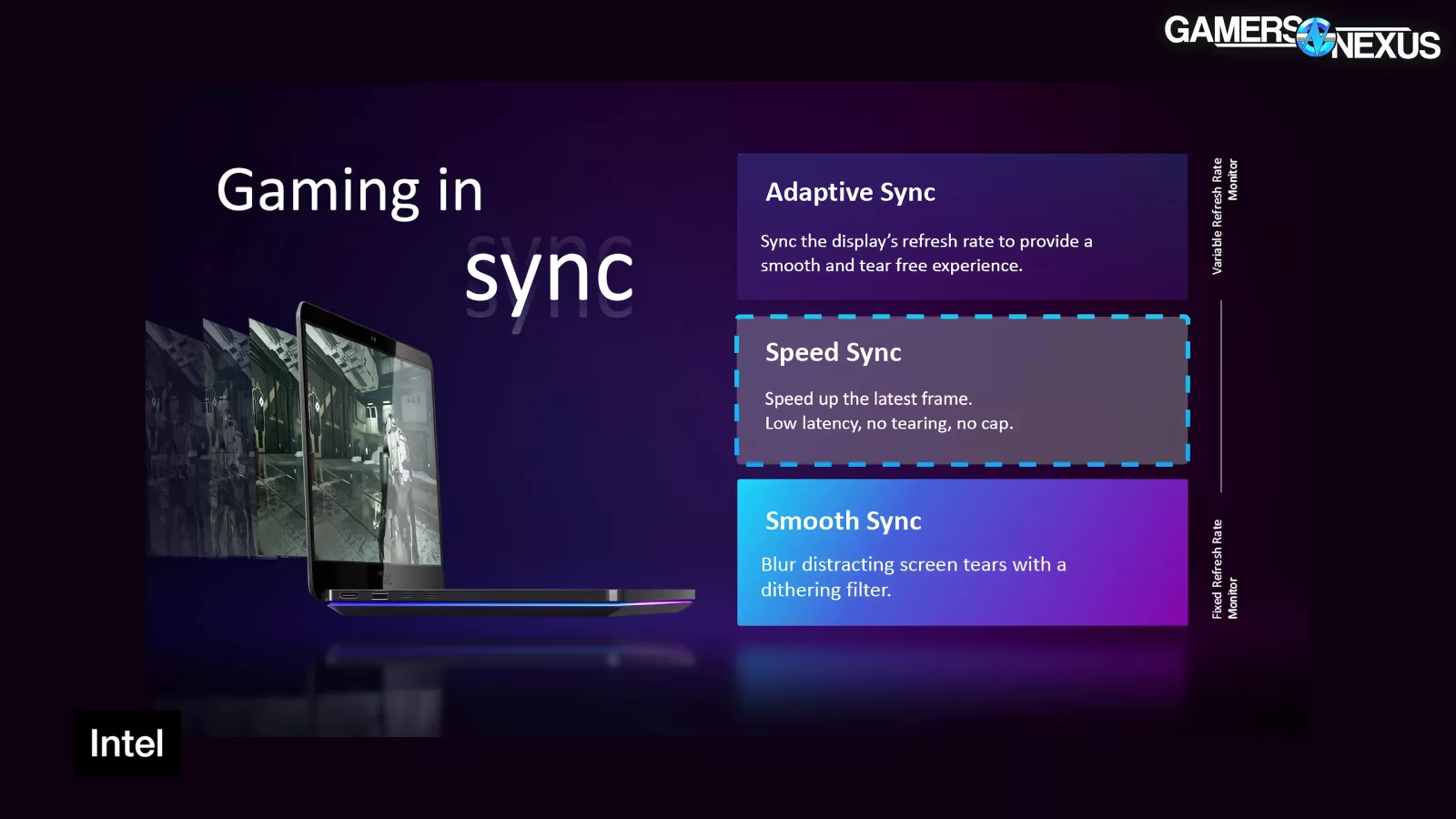
Now for Speed Sync, which allows the game engine to run uncapped, but only the most recently completed frames are sent to the monitor when the monitor is ready. The theory was that this allows the latency benefits that come from uncapped frame rates, just without creating tears. NVIDIA’s Fast Sync is similar in concept.
Two years ago during our revisit, we found Speed Sync to be gone, but it’s back now.
Trying to use Speed Sync with Siege caused the game to consistently crash on launch. This isn’t mentioned as a known issue that we could find on the Arc patch notes, but there are sporadic reports of similar issues around the internet. Intel still has problems here.
Overlapping Apps and Settings

The software is up now.
Intel used to have both “Arc Control” in the driver suite and “Graphics Command Center” in the Microsoft store as a free application, both separate but sometimes overlapping in features and it generally was a completely awful experience because you had to go to the Microsoft Store to get some of the features.
In the time since, Intel cut it down to just “Intel Graphics Software,” which Intel migrated to at the end of last year, in line with the B-Series launch. This was a good consolidation to get away from the confusing mix of applications before.
VRR and DRR
One of the annoyances previously was that there were multiple locations to control Variable Refresh Rate. And there still are.
The Display tab of Intel Graphics Software has a toggle for Variable Refresh Rate, the bottom of the Display tab has “Variable Refresh Rate Mode,” and then separately, Windows has its own “Dynamic refresh rate” under the Advanced display menu, which isn’t supported in this instance even though the same page says that variable refresh rate is supported.
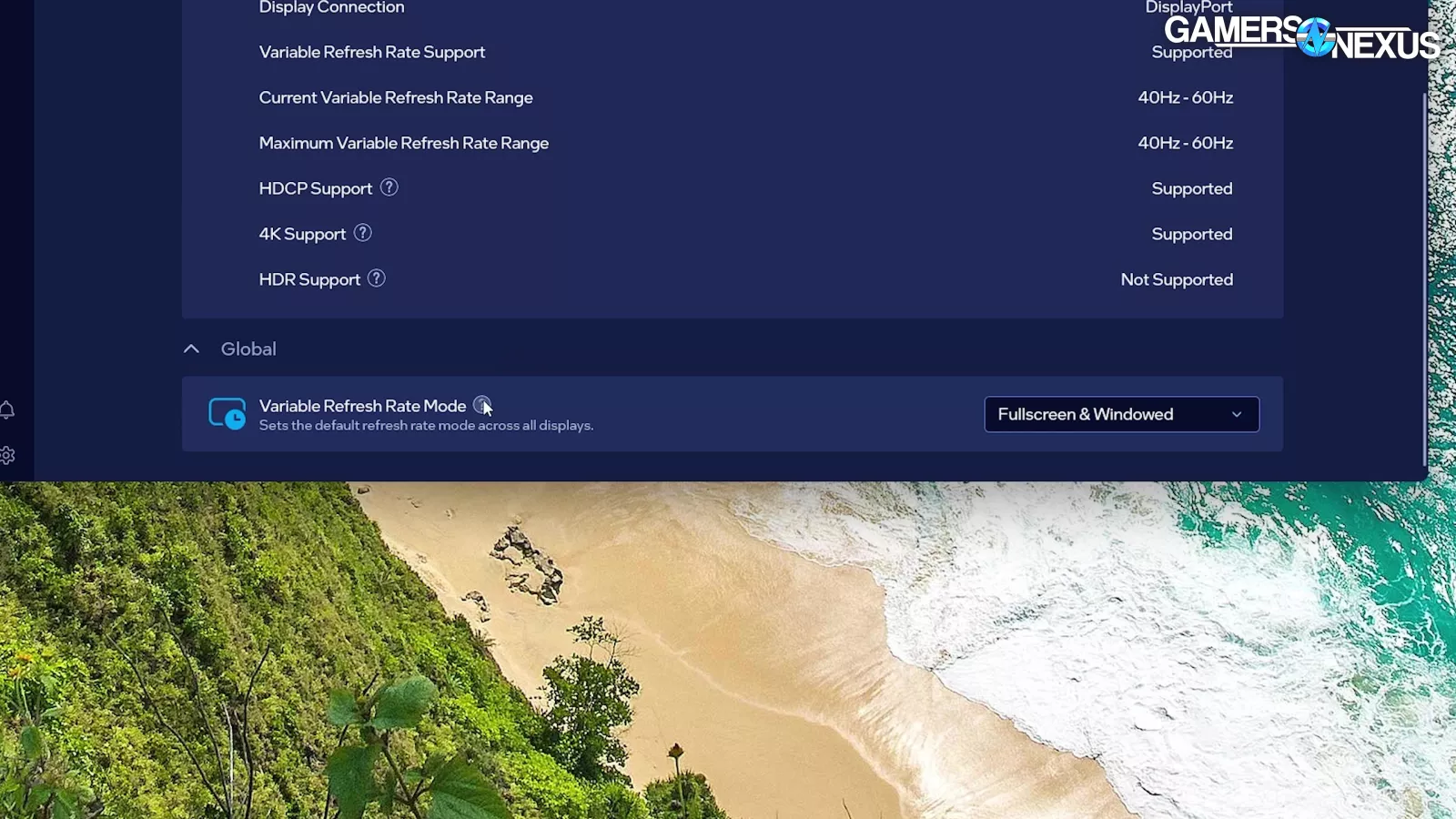
Each of these technically serves a different purpose: The Graphics Software setting is only available when a GPU is connected to a VRR-capable display. The Variable Refresh Rate Mode setting is always available and controls whether VRR is forced on windowed applications in addition to the usual fullscreen ones. We think this option is buried and should be moved up to be alongside the first option.
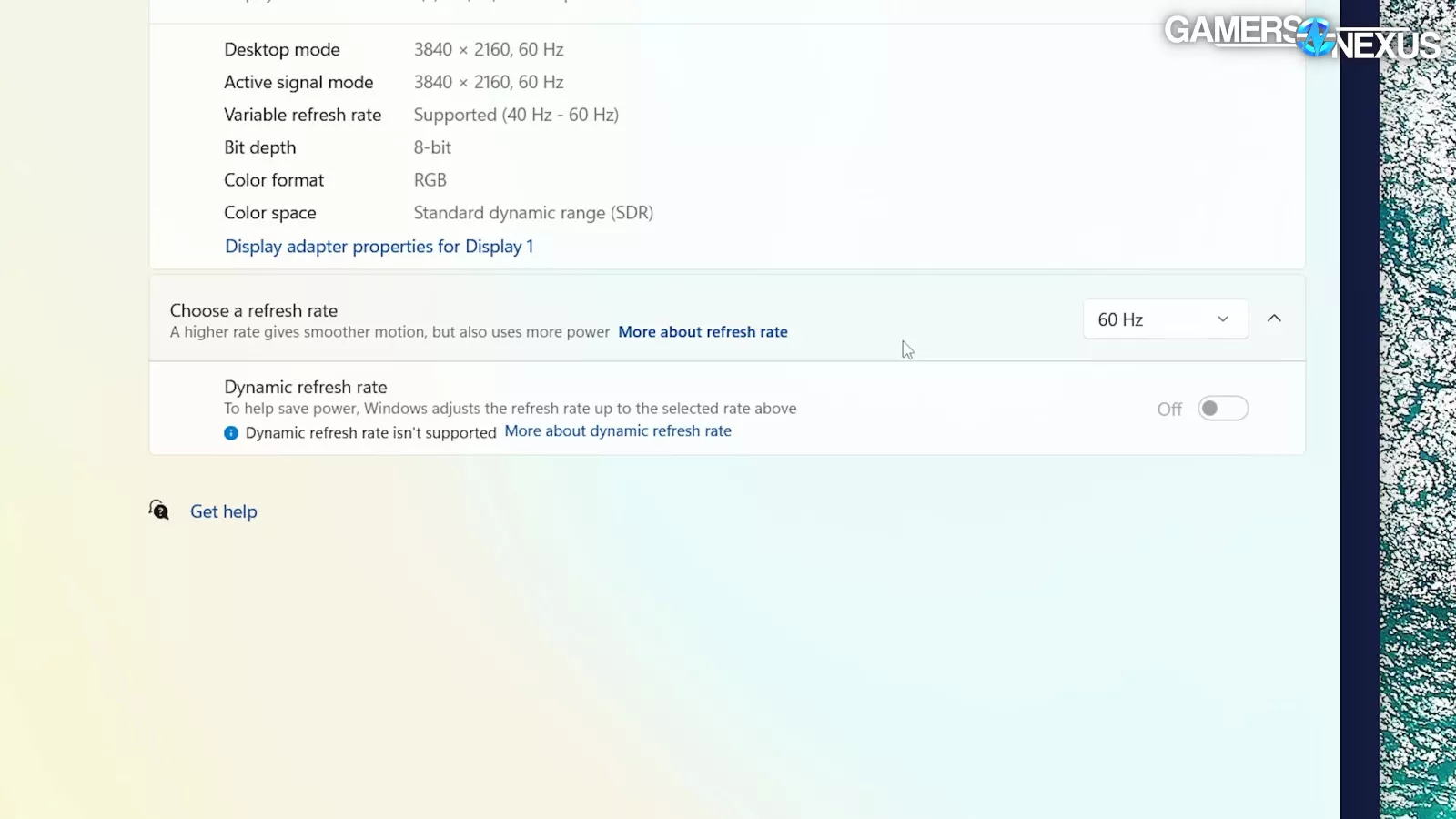
As for dynamic refresh rate, that’s distinct from variable refresh rate and exists to switch the refresh rate of the monitor globally. This requires VRR up to at least 120 Hz.
Driver Support Assistant Forced Install
Intel originally required users to install its “Driver Support Assistant” when installing the Arc Control software, despite having a checkbox that implied the ability to remove it. It was a forced install with the software. Around the time we reviewed the B580, we mentioned that Intel had fixed this.
DSA sits there to notify the user of new driver updates, and runs the risk of downloading them automatically.
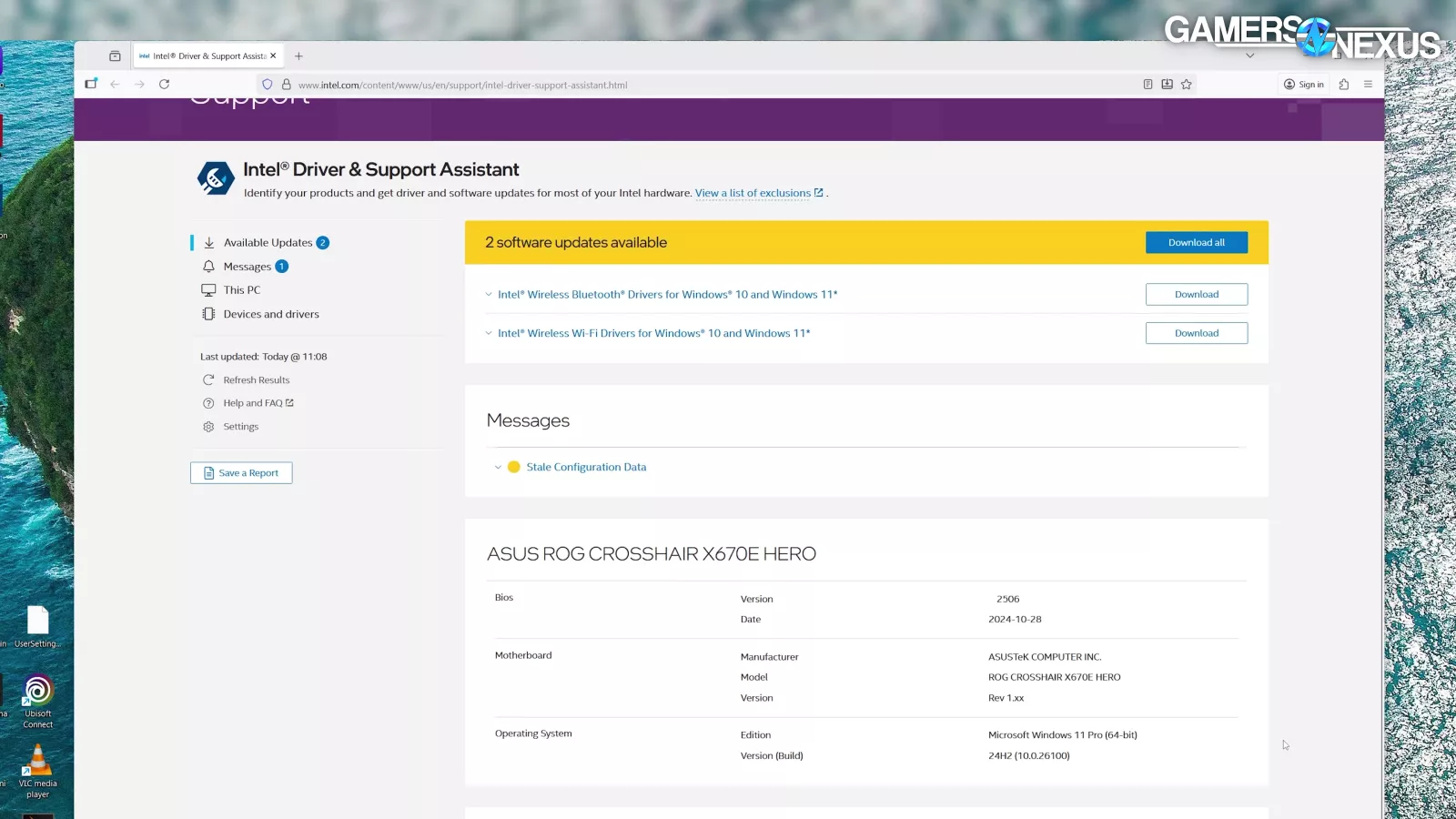
This was a problem and annoyance for us on test benches, so we had to remove it each time.
Thankfully, it’s no longer a forced install and was fixed a little while ago. You’re able to freely choose any of the components and software that sits on top of the base driver. You still have to manually opt out of Intel’s data collection program, but at least you actually can now while still getting the software.
HDCP
HDCP is next: We previously had problems with being able to use a capture card while HDCP was on. We had to use a janky splitter in order to make it happen.

This time, we didn’t have that issue. We didn’t try a bunch of different combinations, but when we hooked up an Elgato 4K X capture card, HDCP support showed as “off” in IGS, and we were able to capture without any friction. We’d still like a manual toggle to control HDCP.
Notification Overload
At launch, Arc Control would blast the desktop with toast notifications, and it wasn’t possible to clear them manually. We just had to wait for them to disappear. During our last revisit, the number of pop-up notifications was reduced, but not eliminated.
Now with IGS, they’re almost totally gone. We caught only 1-2 pop-ups through all of the testing, down from dozens in our first round and a handful in our second. That’s a good move.
Cut Features
Over time, Intel has dropped a couple of features from its graphics software. We had specific criticism in our original review about how Intel was trying to do too much all at once, attempting to duplicate all the features of its competitors like it was knocking out a marketing checklist just for the sake of putting it on the box. They’re narrowing the scope now, which is good.
Intel no longer bundles recording and streaming functionality into the software. That’s fine with us – there’s no need for Intel to compete with OBS at this point when it has to deal with maintaining the software to ensure that it isn’t messed up and broken.
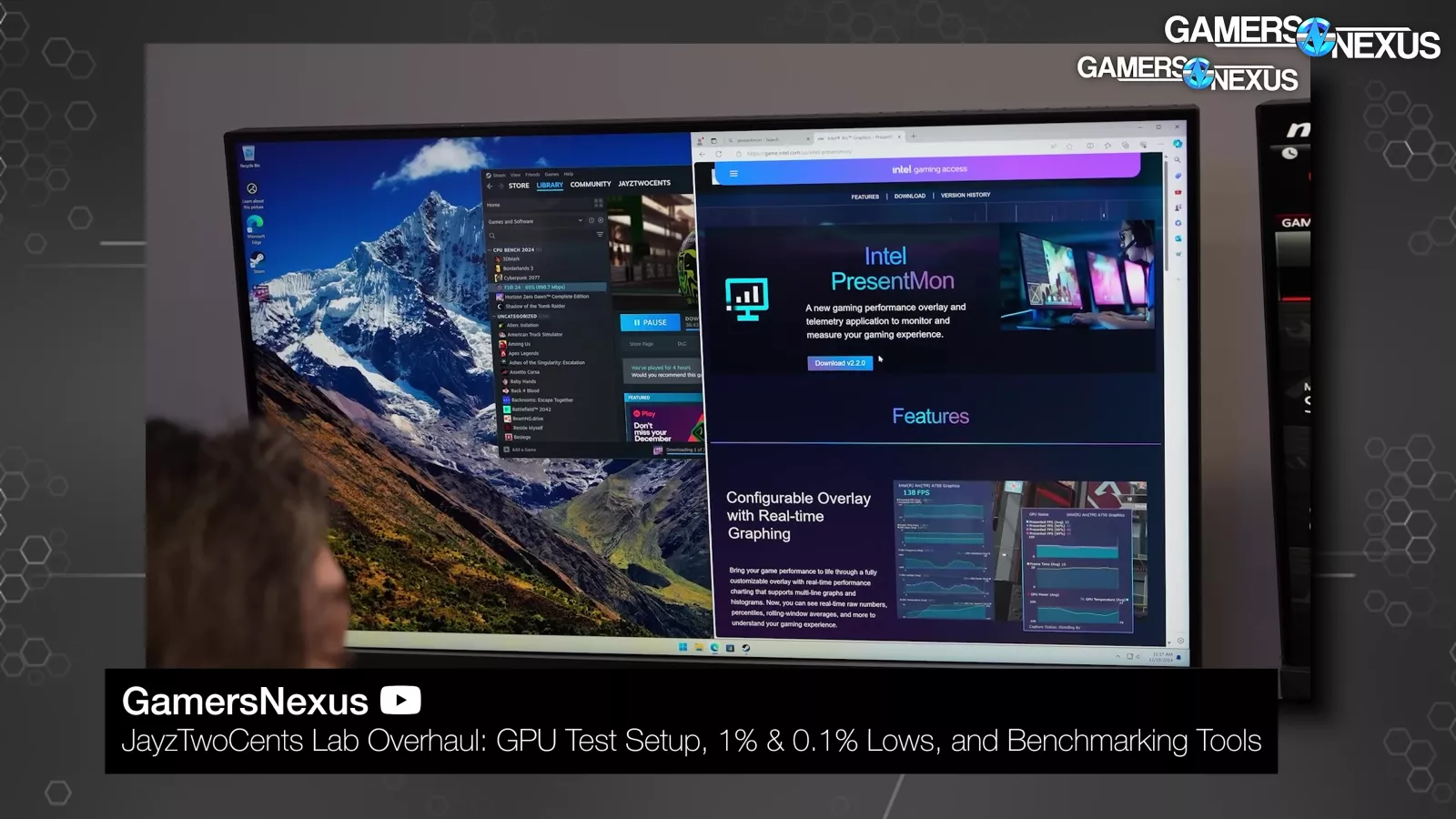
The previous overlays of any kind have been removed. No FPS counter, temperature monitor, nothing. That responsibility now sits entirely on PresentMon, which is its own utility.
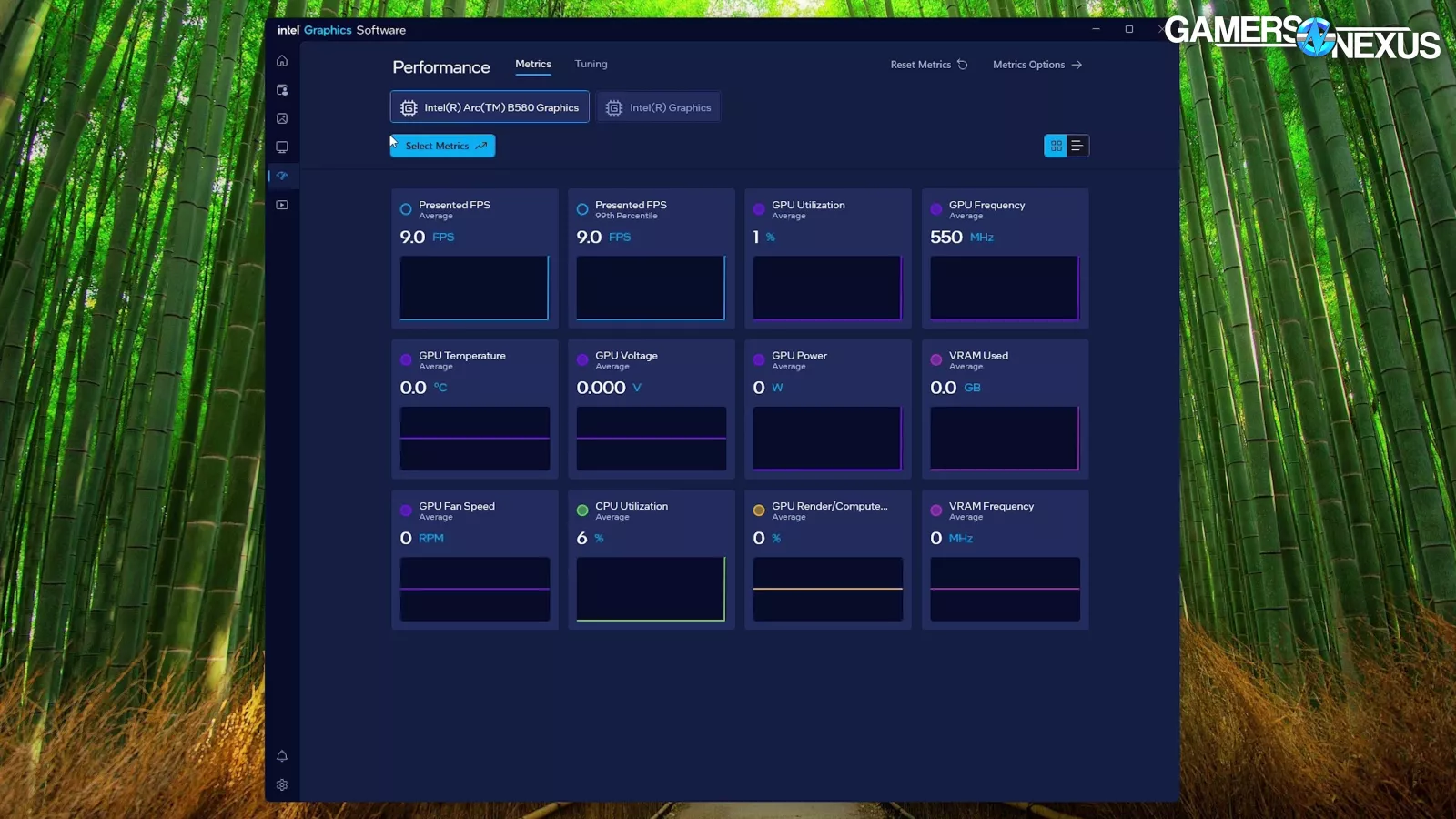
IGS has a tab for metrics, but it’s rough – more on that in a minute.

We previously included overclocking among the things that came off as unnecessary fluff at the time that Arc originally launched, especially since basics like the voltage setting were configured to the incorrect decimal point for the unit of measurement. Performance tuning is still in and they’ve fixed most of the basics – it also makes a lot more sense to us now versus during Intel’s first-wave efforts with the A-Series when all Intel really needed to get right was stability and game support.
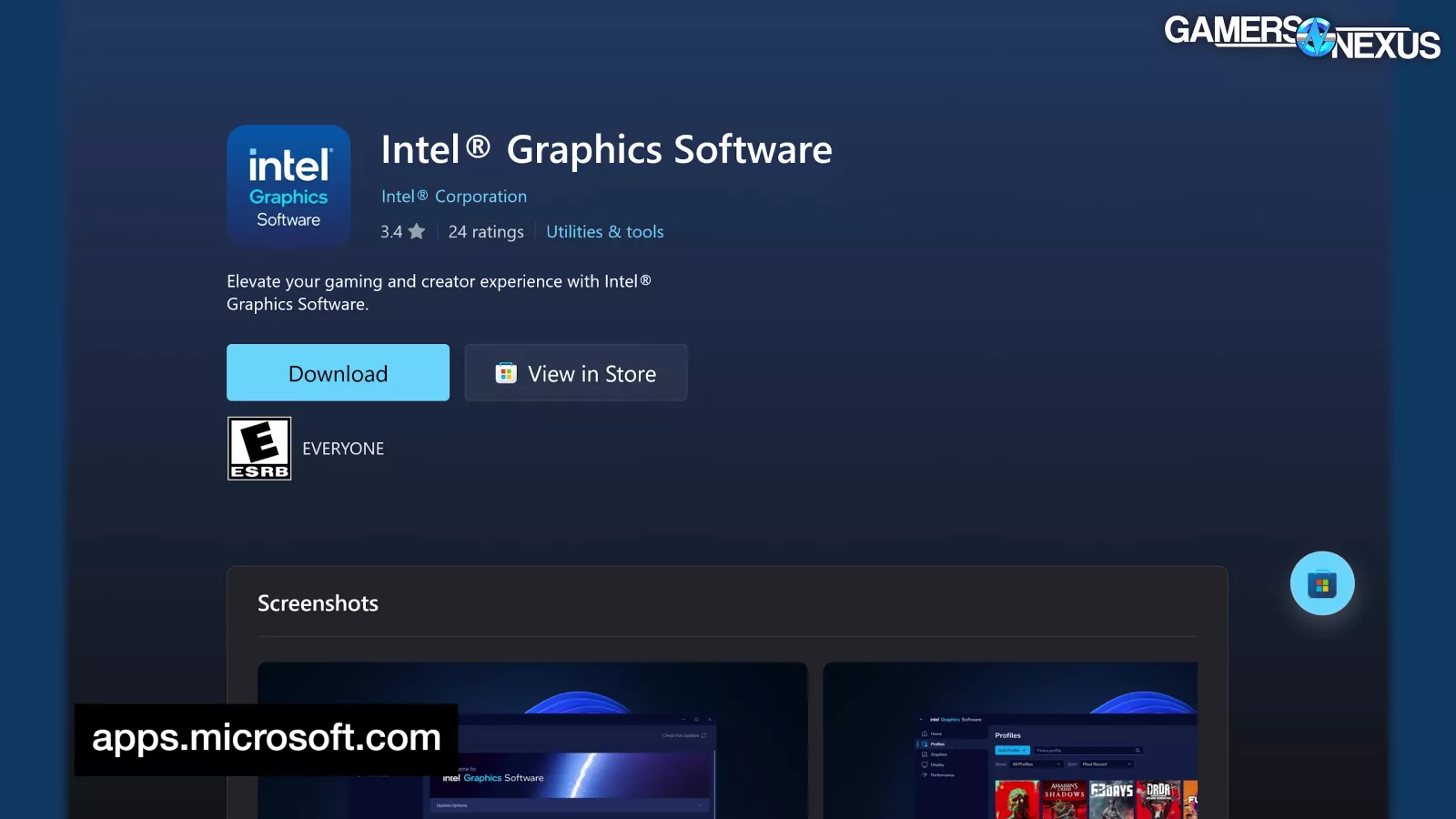
Overall, we think Intel’s graphics software has improved from the simplification and consolidation of software.
Intel Graphics Software’s Features and Issues
As for the current state of Intel’s software, it’s broken down into multiple tabs: Home, Profiles, Graphics, Display, Performance, Video, Notifications, and Settings. We went through all of them, adjusting values, flipping toggles, and generally poking it to see if we could get anything to fall out in a general shake test.

In general, most things appeared to work correctly. For example, the video adjustments panel is so extensive that you can make Cyberpunk look like the image above if you really want to.
Broken Performance Metrics


This next one is weird. IGS has performance metrics monitoring built-in, but it’s unreliable, often incorrect, and has very limited controls.
First off, it’s pretty clear that it uses an internal version of PresentMon for things like frametimes and latency, but we couldn’t find a way to point it at a target application. This should mean that it targets the app with the highest GPU load (like a game).

However, it failed to do so in our testing. Sometimes it showed nothing at all, and sometimes it clearly hooked on some unrelated process, showing frametimes that align with something running well below 60 FPS.
There are options to control the sampling window size (averaging period) and sampling period (the time between polling), but changing them affects the numbers being shown in oddly proportionate ways that don’t make mathematical sense.
For example, stock values of 1,000ms window size and 100ms sampling period resulted in “GPU Time” reading around 100ms average. Dropping the values as low as possible resulted in “GPU Time” of about 50ms average. Setting them all the way up to 5,000ms window size and 250ms sampling period resulted in about 250ms for average GPU time. If you picked up on that pattern, you see that it ends up reading awfully close to whatever the sampling period is set to.
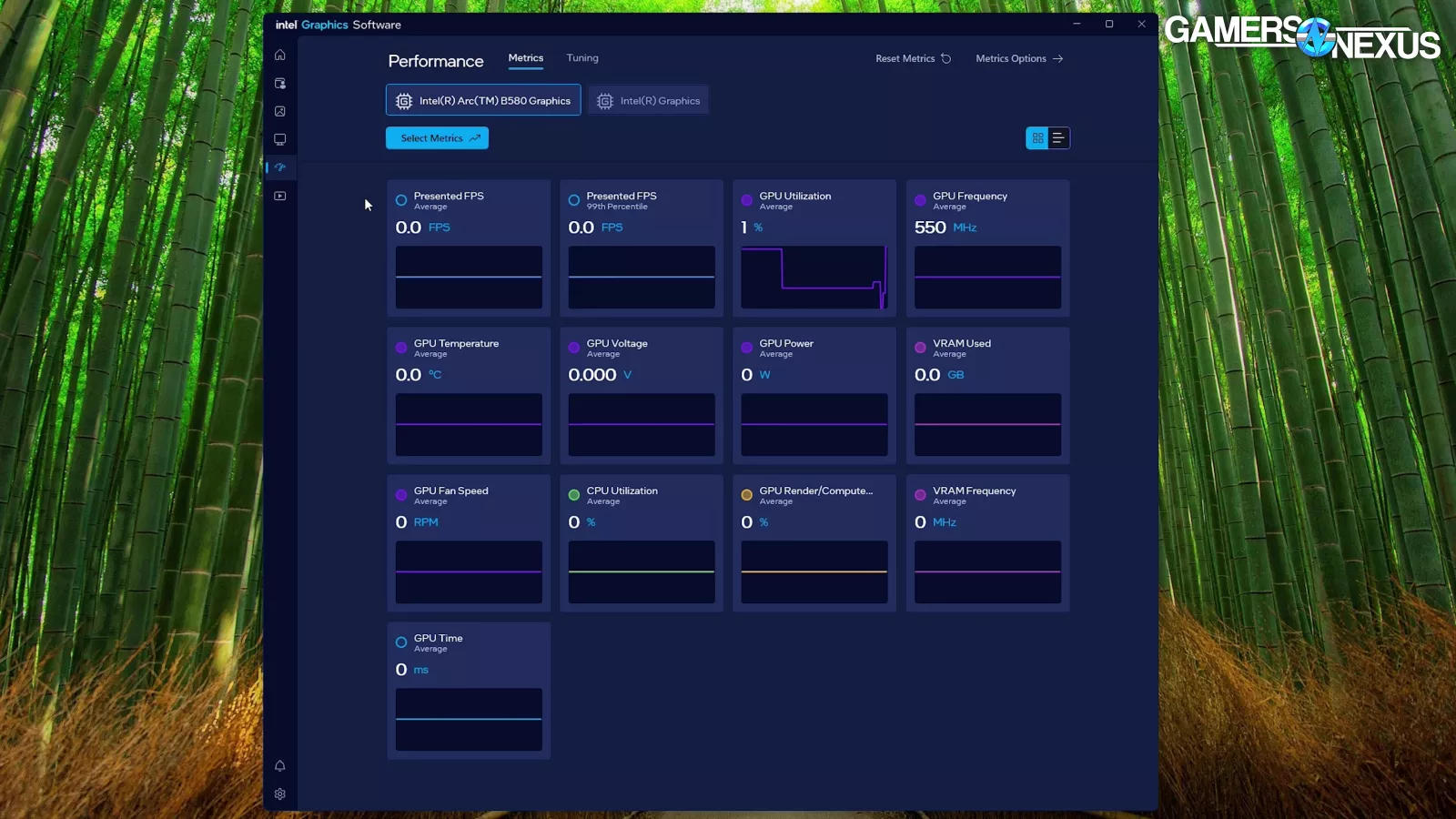
There was even more. Setting the window size to a shorter timespan than the sampling period basically prevents it from working.
We tried it out on one of our test systems and ran PresentMon at the same time to compare the readouts. Sometimes, IGS failed to show anything. The rest of the time, it would be sporadic and clearly wrong, like in the image above, where it shows about 9 FPS AVG, when F1 24 was actually running at 170-ish FPS.
Anyway, the currently useless state of IGS’ monitoring tab needs to be addressed. Intel should either get rid of it or make it work. The good news is that this isn’t critical to actually using the GPU day-to-day.
Video Capture
We briefly tested video capture with OBS on the B580. It’s capable of doing 4K at either of OBS’ non-lossless simple presets, but only if the GPU has headroom. If it doesn’t, the encoder instantly gets overwhelmed and performance falls off a cliff, similar to what you’d see in CPU encoding when the CPU is preoccupied.
The card becomes overloaded, so there’s some forgiveness there, but NVIDIA has an advantage here.

Its NVENC solution has a more graceful way of handling capture concurrently with heavily loaded scenarios. Intel doesn’t seem to live up to that just yet.
Smart VSync
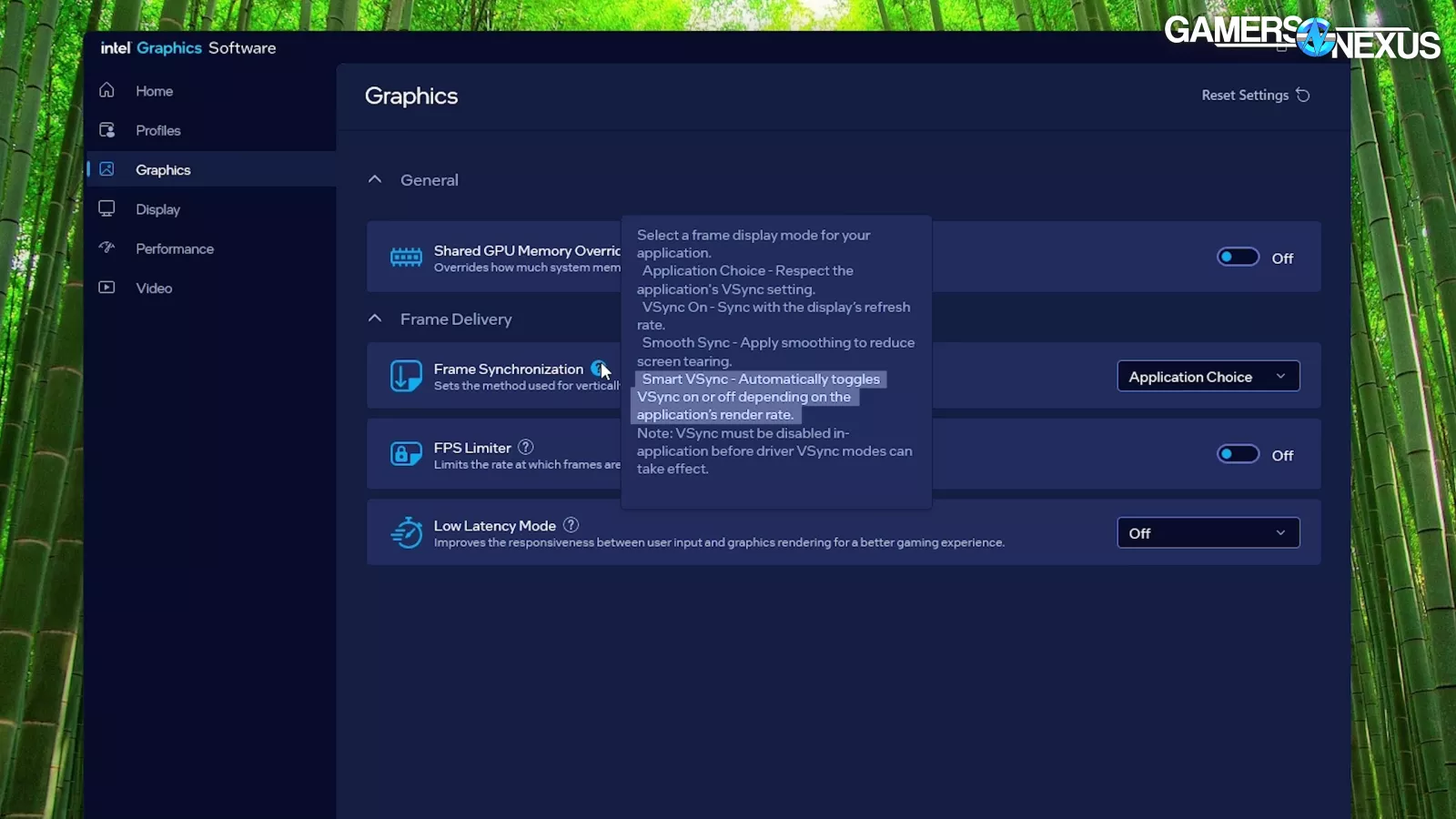
Intel’s inconsistency comes back into play with Smart VSync, which is intended to only turn on when the game’s frame rate exceeds the monitor’s refresh rate. It worked reliably when changing the setting prior to launching the game, but only worked one single time when we changed it while the game was still running; after that, it no longer functioned in this order or way, contributing to the overall confusion caused by Intel’s inconsistent driver behavior.
UI - Minor Bugs and Annoyances
We’re moving on to smaller complaints now.
While we were in the Graphics tab, we found a small UI bug under the Shared GPU Memory Override setting. The default setting on the machine we got this capture from was a memory limit of 57%, or 36.1GB. When we moved the slider, turned off the override, then back on, the slider was still where we had set it, but the value on the left had reset to 36.1GB. One of them is wrong. This is a bug.
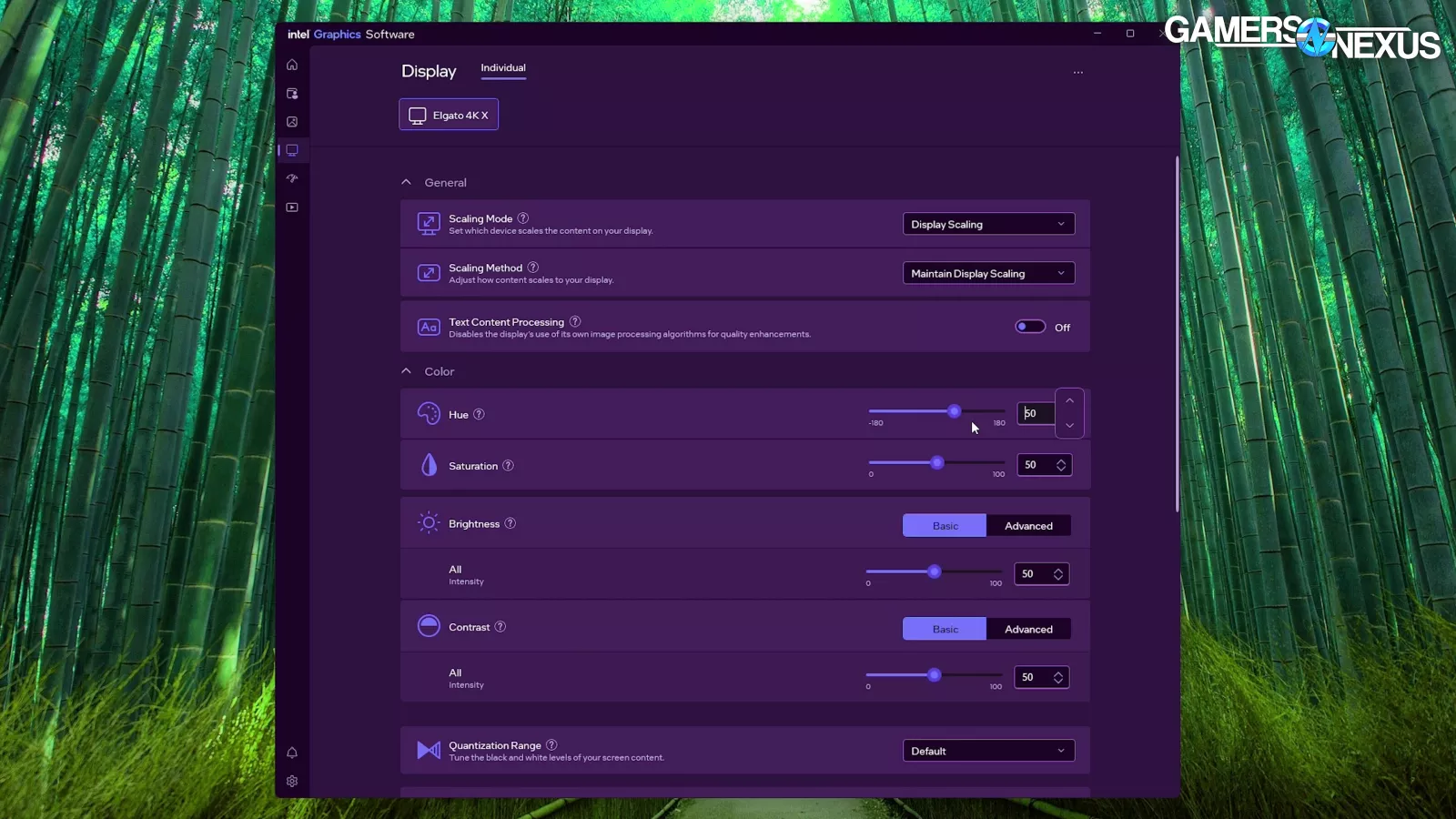
Less a bug and more just annoying was the fact that after manually entering a value, the only way to lock it in was to click on the slider. Pressing enter, escape, or clicking away didn’t work. This was just a usability shortcoming.
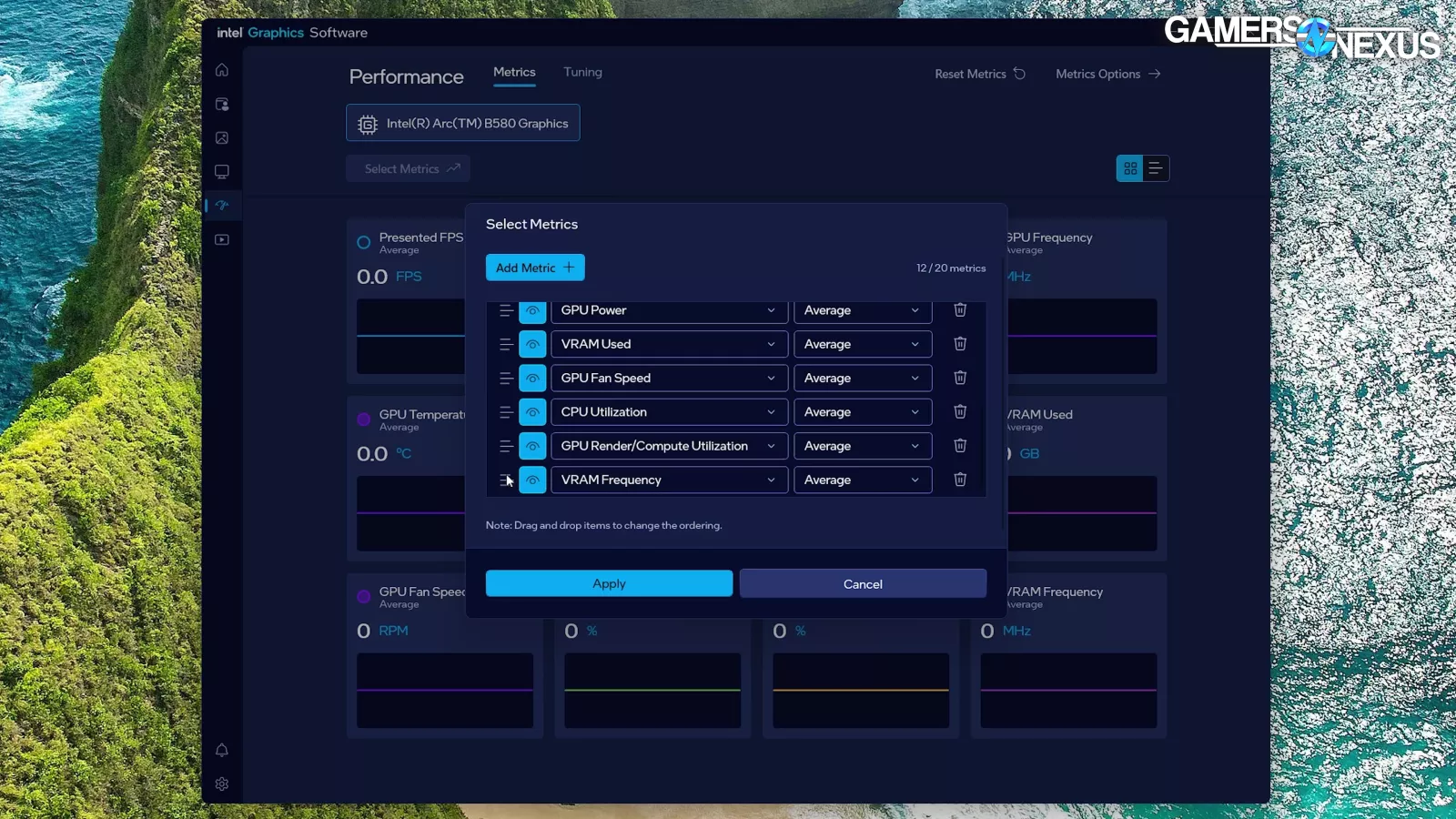
Also annoying was the UI for rearranging the order of the metrics on the Performance tab. You’re supposed to click and drag the item in the list, but it has extremely aggressive edge scrolling, making it difficult to place them where you want.
To wrap up our UI complaints, the VRAM Tuning tooltip doesn’t agree with the slider. The tooltip and the slider represent memory frequency with both GT/s and Gbps, which can be confusing for some users.
Frame Cap Limitations

The next one isn’t a bug at all, but is a limitation. Even though IGS has the ability to limit frame rates, it’s strangely limited to just DX9 and DX11 APIs – no DX10, DX12, or Vulkan. We’d assume that there’s some technical reason for the limitation, but from a consumer standpoint, it’s a shortcoming that’s unexplained.
It’s very easy to set global or per-game frame rate caps with NVIDIA and AMD, and they don’t seem to care about what API is under the hood.
Game Ready
Optimized drivers coinciding with new game launches are critical to the usability of any GPU for gaming.
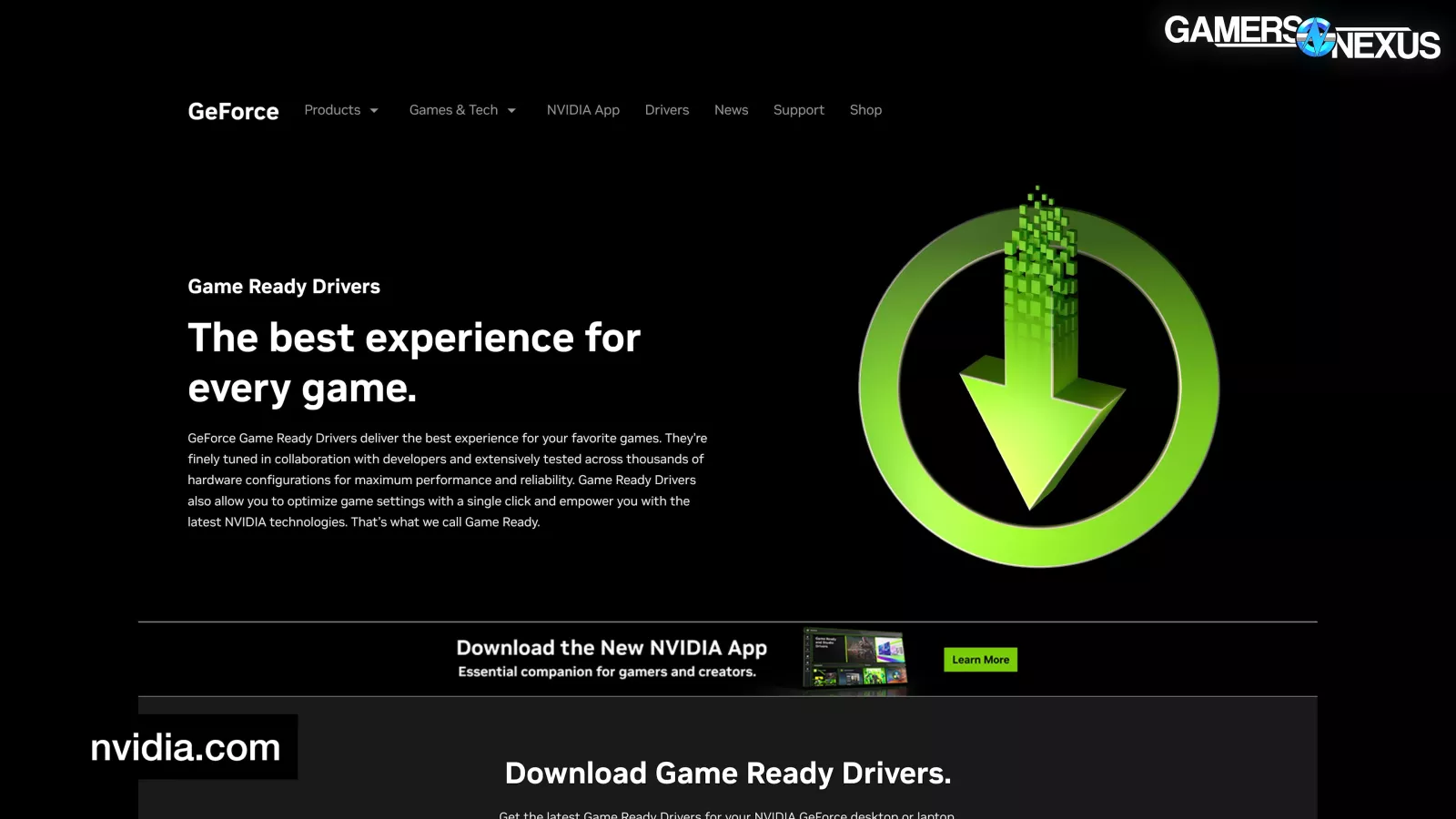
NVIDIA has made a concerted effort to market its “Game-Ready Drivers,” which is one of its more meaningful campaigns and something we can get behind. NVIDIA’s strength is in this specific category, which is having a driver ready for the day a game releases. This requires direct cooperation with the developers to get early access and sometimes provide engineering resources for shader optimization, something we talked with Tom Petersen (now at Intel) about last year.
This is one of the more important areas where Intel needs to deliver.
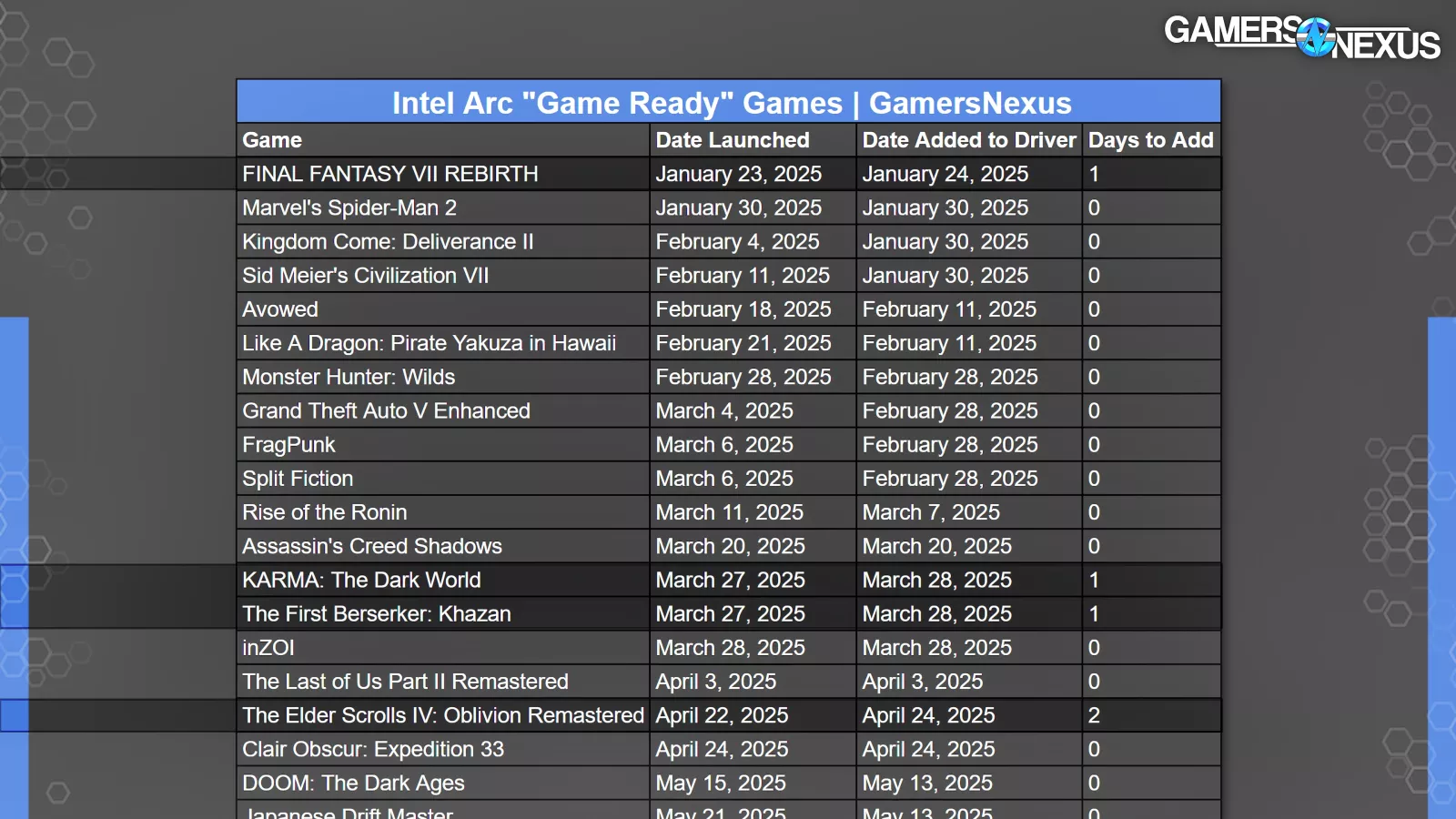
In the time since the B-Series launch to when we stopped gathering data, Intel has included “game ready” support for 39 total games, 34 of which were mentioned as supported on or before the game’s release date. That’s not bad -- 87% of the total named games were supported in time for a player to buy it on launch day and have explicit tuning from Intel.
Of the 5 that got mentioned post-launch in patch notes, the average is just 2.4 days of lag time. This is a significant improvement from Alchemist.
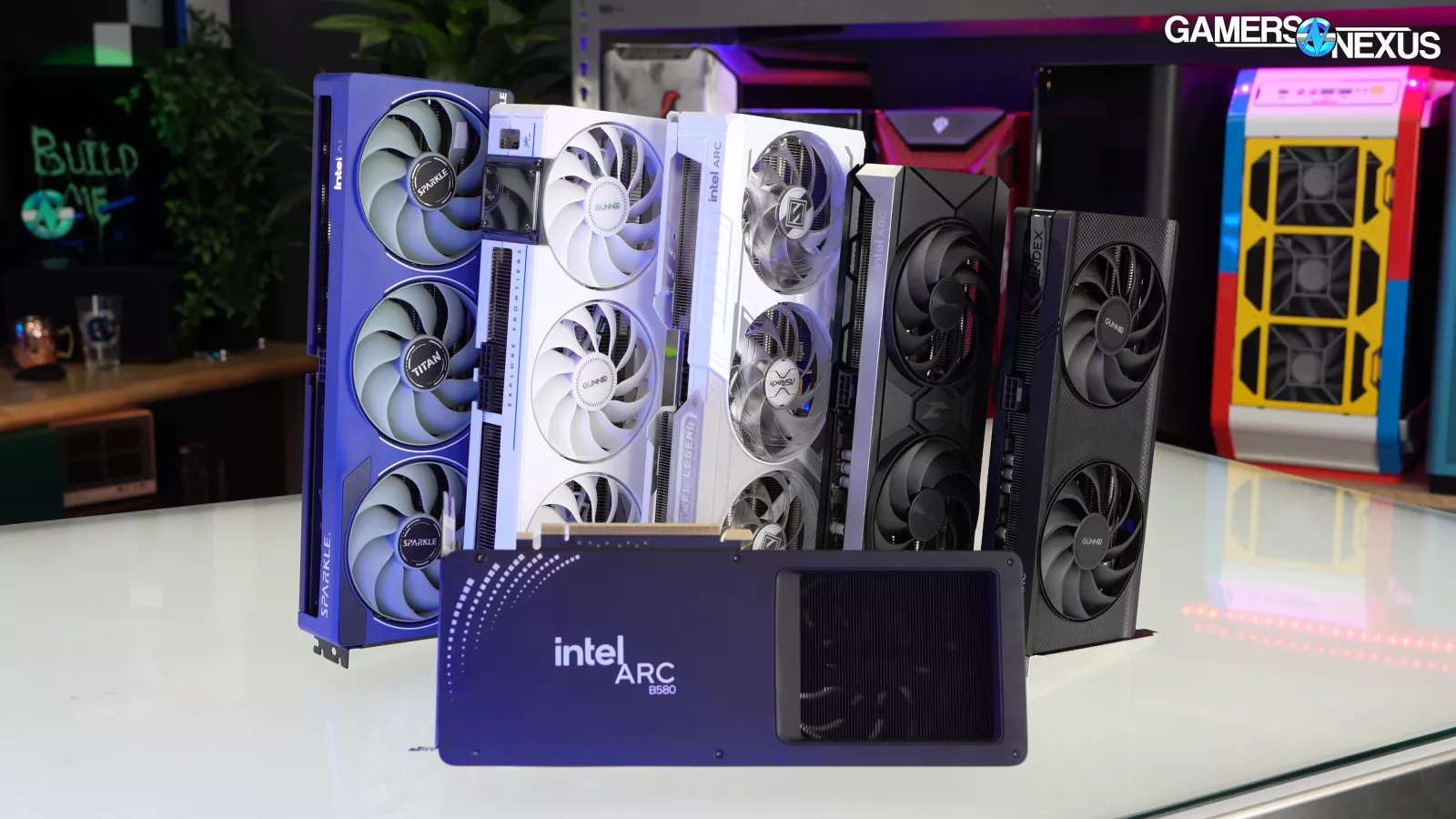
That’s a good ratio of “day zero” games, and pretty reasonable timelines for the few that aren’t. Ironically, the one with the longest wait was Silksong.

We aren’t aware of what Intel’s selection or submission process is for which games get an explicit mention like this, or what level of validation takes place, but based on the data, it seems like Intel is staying on top of new releases. They don’t get all of them -- Starfield at launch was functionally broken on Intel. But to be fair, Starfield at launch was also just functionally broken.
Driver Timeline
We’ll move to a timeline of the driver launches since Battlemage to get an idea for how committed Intel is to Arc.
We gathered archival driver release data from TechPowerUp and Intel, starting at the launch of the B-Series (version 6325, December 13, 2024) until roughly mid-September (version 7029), just before Intel made the main driver package Arc-only and kicked out the 14th Gen IGPs and older. It’s possible we missed a few smaller or less documented hotfixes in this.
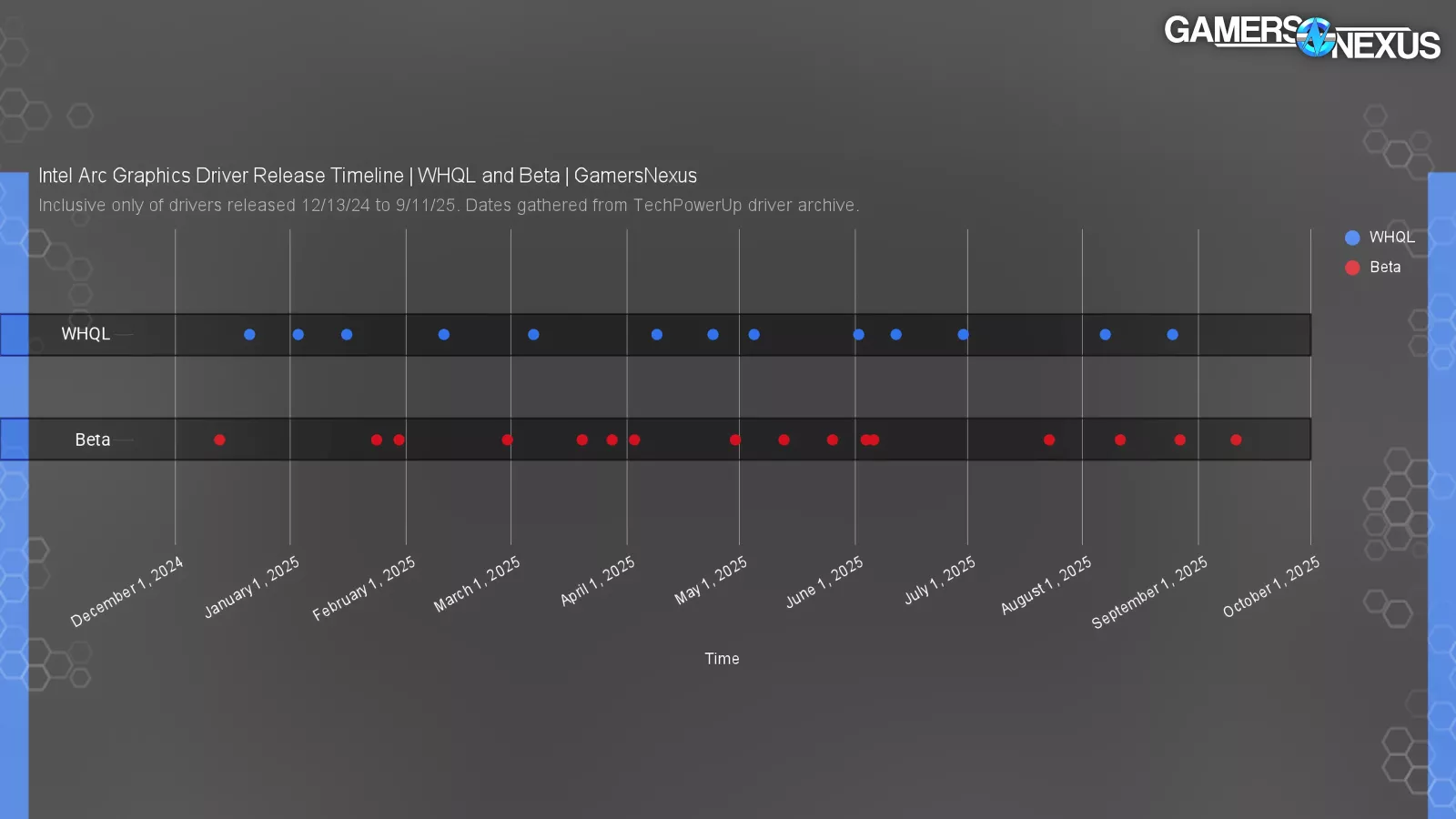
Over the last 10 months from what we found, Intel has released 13 validated WHQL drivers and 16 beta drivers. Intel has some areas it pushed, like late May through June with 3 beta releases and 1 WHQL release.
On May 26th, Intel’s 6795 Beta introduced new game support and performance improvements for Elden Ring Nightreign, which would launch 5 days later, Dune: Awakening to prepare for its June 10th launch, and Monster Hunter Wilds, which came out in February. For at least this driver, Intel illustrated that it’s trying to have drivers ready in time to ensure compatibility with new games or improve their performance.

The 6874 WHQL release from June 2nd had Farming Simulator flickering texture fixes, so these issues still exist for Intel. It also had important power management updates for Lunar Lake Core Ultra 200V series CPUs.
Just two days later, Intel pushed the 6876 beta. It had game support for FBC: Firebreak, Rematch, Stellar Blade, and Rainbow Six Siege X. It also featured what is possibly the most vague fix we’ve ever seen. For the Arc B-Series GPUs, Intel said it fixed “Intermittent visual artifacts may appear in certain usage scenarios.” Ah yes, we fixed the problem that might happen sometimes in a subset of nondescript circumstances. Thanks, Intel.
2 days after that, Intel pushed the 6877 beta driver to address one specific issue tied to audio on Core Ultra Series 2-equipped handhelds. 6 days later on the 12th, they pushed a full release that only noted a fix for crashes in Overwatch 2.
The rapid, quick changes followed by a major driver version shows Intel is at least keeping busy chasing down individual bugs and fixing them as fast as possible. That’s a good sign of responsiveness. We think this is a great philosophy in terms of support that caters to the relatively small group of enthusiasts who have taken the plunge on Arc. It also shows that Intel is alive. So, it’s kind of a canary in the coal mine in terms of if the GPU support will stop.
We’ll quickly run through some light comparisons to NVIDIA and AMD.
In that same time frame, NVIDIA sits in some contrast to Intel’s approach, having pushed 21 total drivers (18 standard, 1 beta, 2 hotfix). The vast majority of the releases are standard WHQL, which makes sense to us considering NVIDIA’s dominant legacy position. Its drivers are mature and rarely require quick fixes -- except the beginning of this year, when they released hotfixes to fix hotfixes.
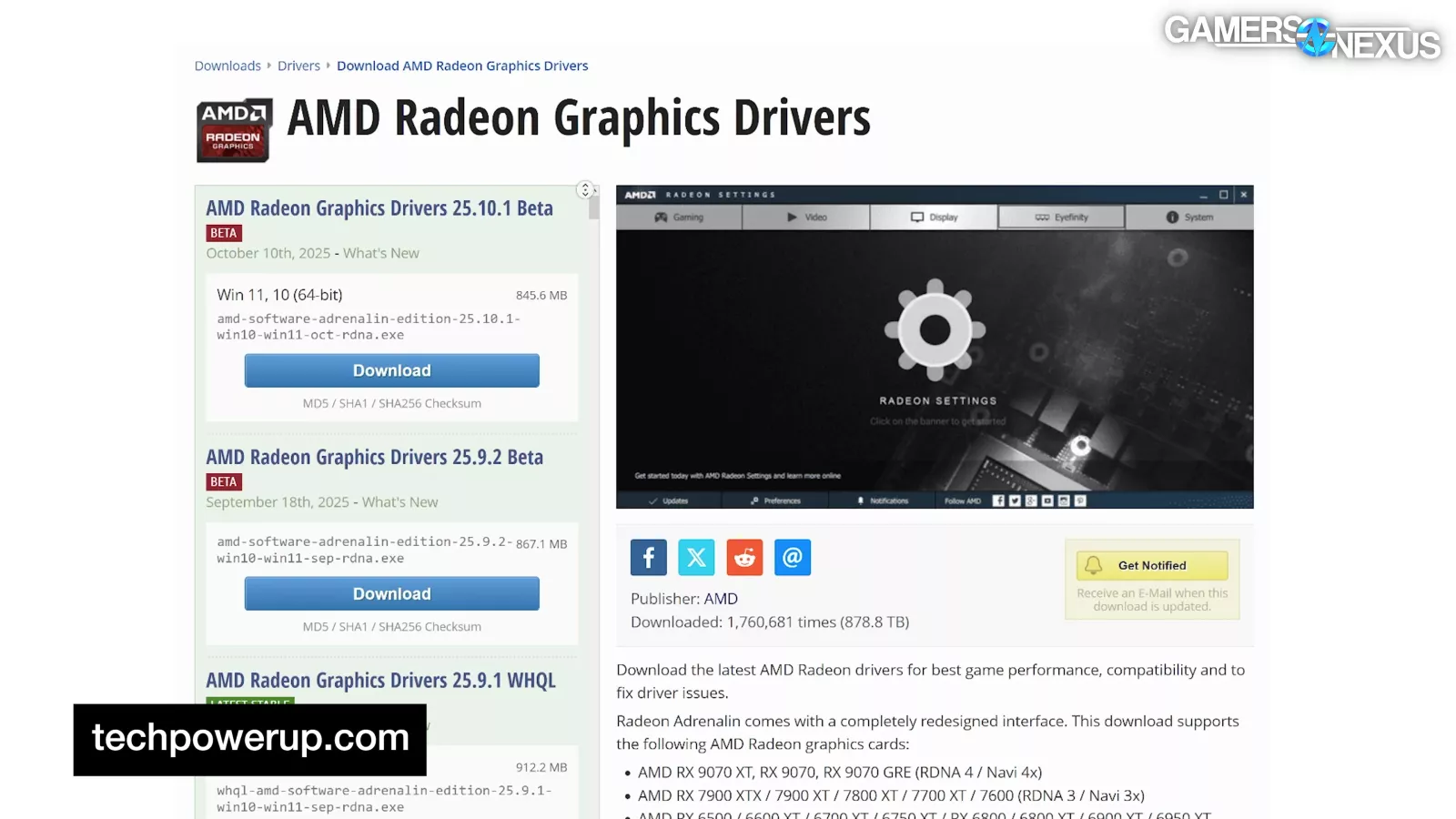
AMD’s Radeon driver team was quiet in comparison to both, having released only 11 drivers (5 standard and 6 beta). To be clear, the quantity of drivers isn’t an indication of the quality of the drivers, but considering the frequency of the game releases, the quantity does matter.
XeSS Support
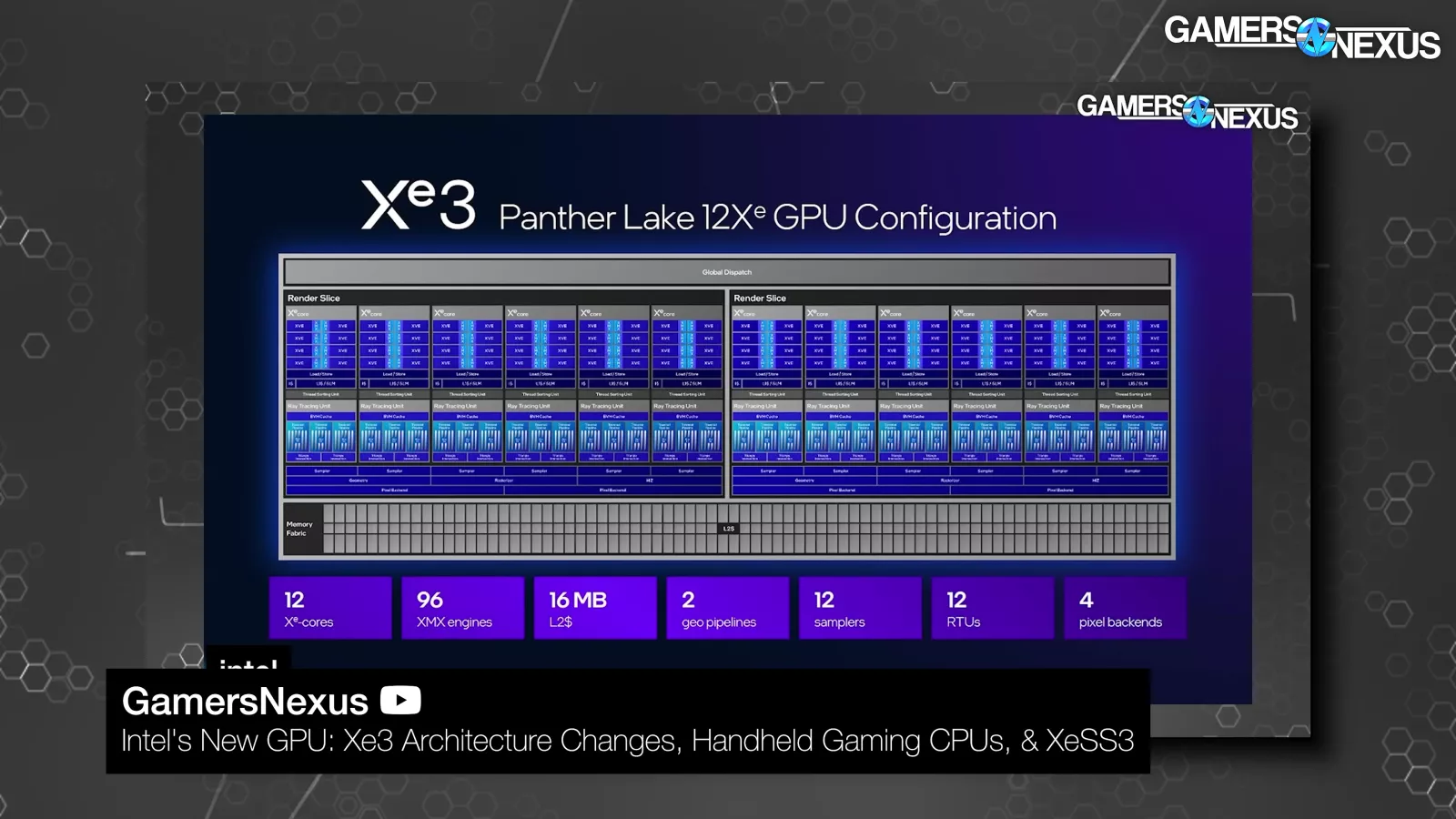
XeSS support is next.
For better or worse, the industry’s favorite buzzword comes into play: AI.
Upscaling is actually an important feature at this point. AMD and NVIDIA have FSR and DLSS. We checked on Intel’s progress with XeSS adoption.

This chart shows how many games support each given form of upscaling. Support for Intel’s XeSS isn’t as extensive as its competitors, totaling 334 titles. This data is pre-XeSS3 announcement, as that’s not fully rolled-out yet.
AMD nearly doubles Intel’s XeSS count at 624 games supporting some form of FSR. FSR 1 is significantly lower quality than the versions that succeeded it due in major part to being strictly spatial and not temporal, but we’re counting it here.
NVIDIA holds a numerical victory against AMD, with 649 titles supporting DLSS Super Resolution.
NVIDIA’s introduction of DLSS overrides means that most DLSS titles should be able to be forced to run the latest models. Of course, the game matters more than just the number of games, but NVIDIA gets credit for having both bases covered.
XeSS 2 is an especially bad situation, with only 44 games officially supported on the list at the time of writing for a solution which launched alongside Battlemage in December. It’s starting to look kind of abandoned. “XeSS 2” is actually an expansion of the feature set to include frame generation and XeLL (low latency), and not a replacement for the actual upscaling in base XeSS. The additional 290 games we have listed under XeSS 1 count just as much when considering upscaling alone.
Also notable is that Intel recently opened up the possibility for NVIDIA and AMD GPUs to officially support XeSS Super Resolution and Frame Generation, aka XeSS-SR-FG, which is nearly a whole alphabet. Intel did this by publishing its XeSS 2.1 SDK. The only requirement is support for Shader Model 6.4, which applies to NVIDIA’s 3000 series onward and AMD’s 6000 series onward. In the time since, Intel has announced XeSS3, which we detailed in our Xe3 architecture article, which talks about their version of MFG.
Lossless Scaling
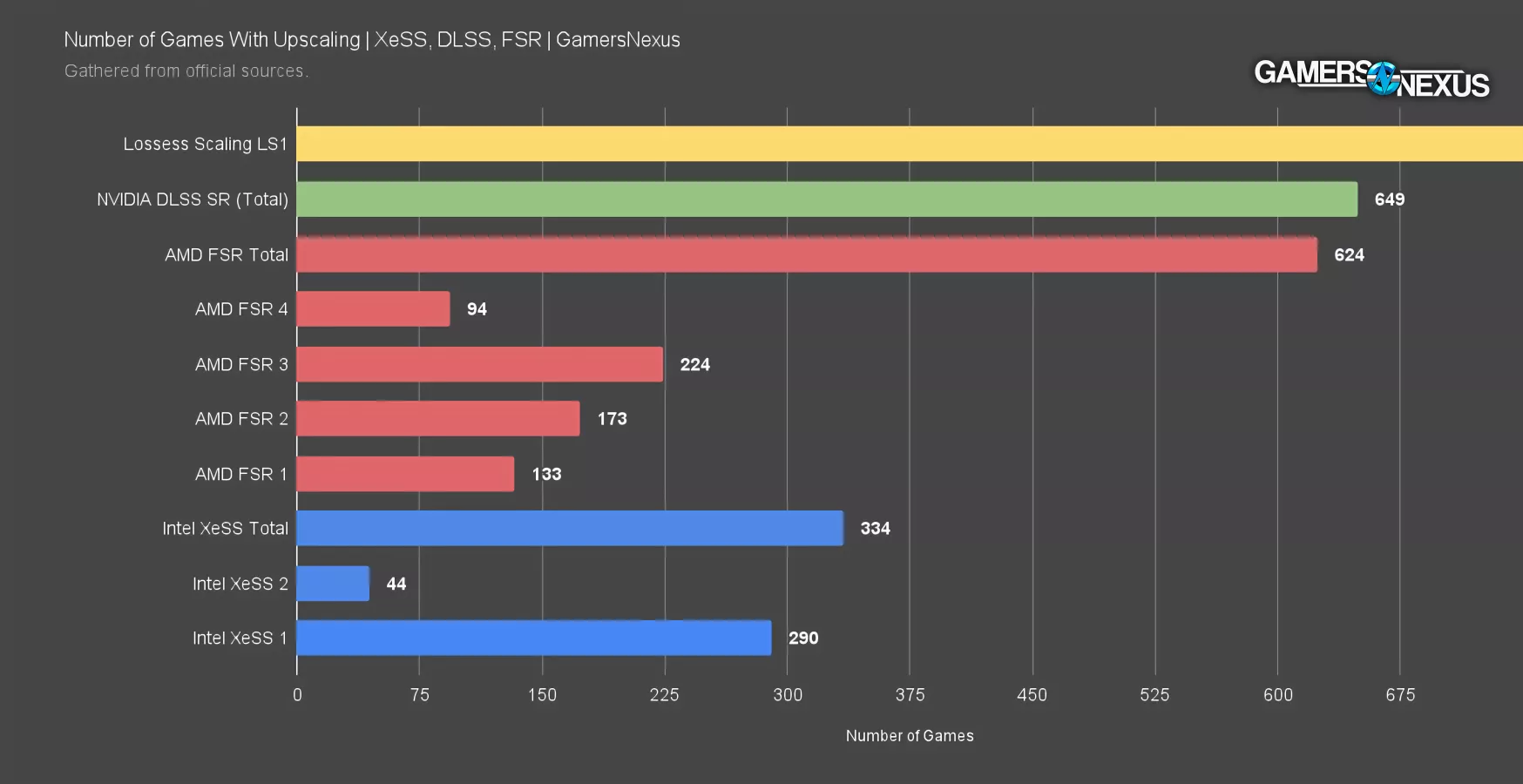
Of course, based strictly on numbers, Lossless Scaling’s LS1 wipes the floor with all of them, supporting a near-infinite number of games (if that’s the metric we’re judging by). That’s the benefit of not needing game or engine integration, though that does mean image quality suffers sometimes significantly. Although on a technicality, FSR1 can also have an infinite bar because Lossless Scaling can run FSR1, which is sort of like, "we heard you like upscaling so we put upscaling in your upscaling so that you can upscale while you upscale."
We have a whole deep dive on that you should go check out if you haven’t seen it.
Fixed and Known Issues
| Intel Arc Graphics Fixed Issues | GamersNexus | |
| Total number of fixed issues | 81 |
| Number of fixes: Arc A-Series | 12 |
| Number of fixes: Arc B-Series | 34 |
| Number of fixes: Ultra 1 CPU | 4 |
| Number of fixes: Ultra 2 CPU | 25 |
| Number of fixes: Software | 5 |
| Number of fixes: Unknown/General | 1 |
| Average number of days to fix issues (From 44 fixed issues that were mentioned as known issues) | 39.9 |
| Number of "fixes" that had to be fixed a second time | 2 |
This table is deceptively small, considering that it required crawling through and collating 641 mentions of known issues and 81 mentions of fixed issues across 9 months worth of patch notes.
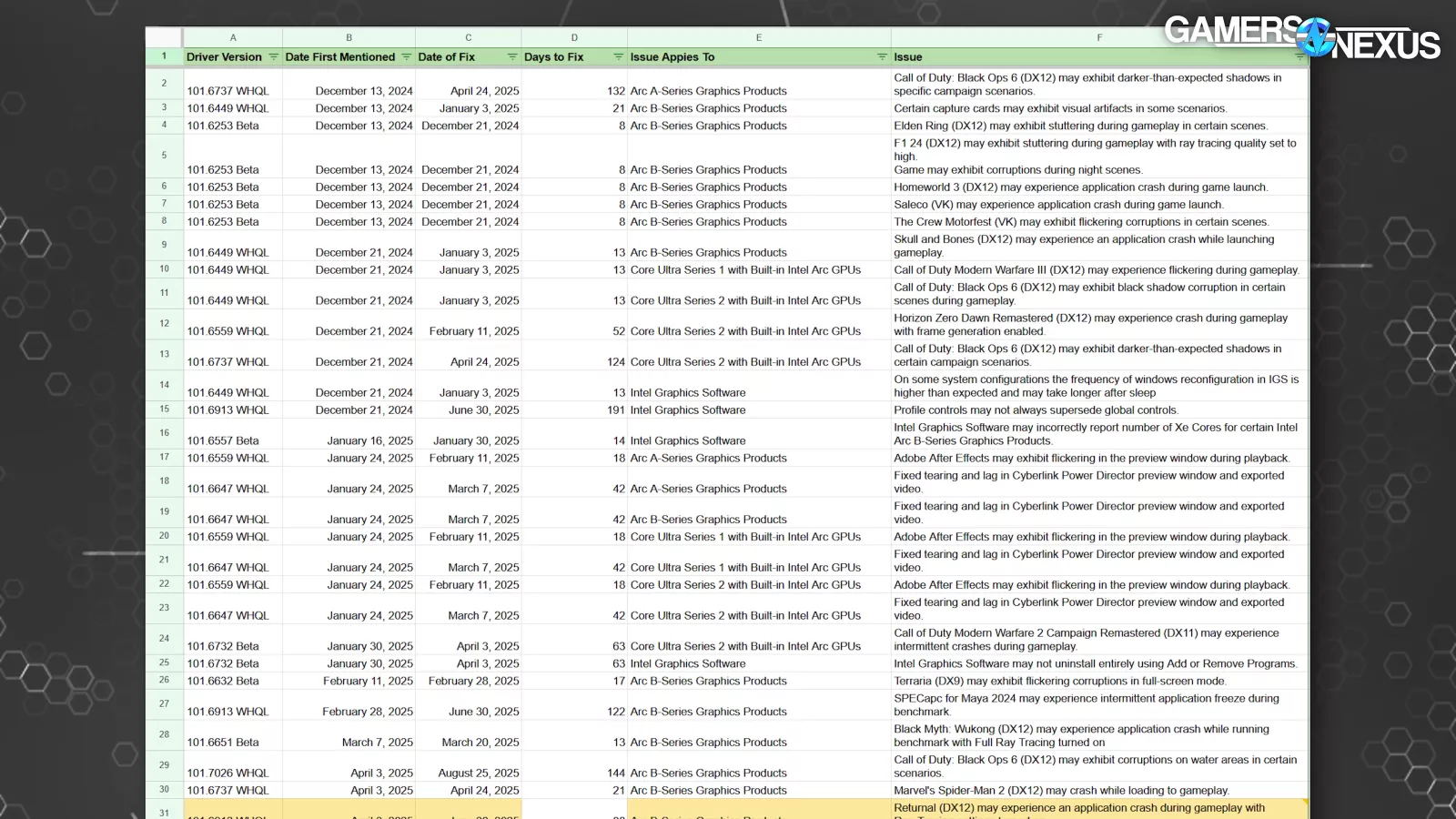
This took a while to put together.
Intel declares 81 total issues fixed since the B-series launch – 12 for A-Series, 34 for B-Series, 4 for Core Ultra 1 integrated GPUs, 25 for Core Ultra 2 integrated GPUs, and 6 for software or general fixes. Only 44 of those total fixes were mentioned previously as known issues. Of those, the average time to fix was 39.9 days. We assume that the rest of the previously-unmentioned fixes were things that got noticed and addressed quickly, such as between releases.
We also noticed two issues that were mentioned as “fixed” twice for the same exact issue and for the same product category.
The first was first mentioned as a known issue on April 3, 2025 for the Arc B-Series GPUs, “Returnal (DX12) may experience an application crash during gameplay with Ray-Tracing settings turned on.” This was marked as a fixed issue on June 30th, but was then fixed a second time on July 23rd, “Returnal (DX12) may experience an intermittent application crash during gameplay with Ray-Tracing settings turned on.” The one difference is the word “intermittent,” leading us to think edge cases that caused Returnal to crash continued to surface.
The second issue was on August 7, 2025 for the Arc A-Series GPUs, “Mafia: The Old Country (DX12) may exhibit corruptions on character hair during gameplay.” It got marked fixed on August 11th, resurfaced, and got fixed again on September 10th. That second update narrowed the scope down to “certain scenes,” which sounds like the same kind of situation – Intel thought it fixed the problem, but somehow "corruptions on character hair” returned. Overall though, the important thing is the average time to fix an issue that’s listed as known, which was just under 40 days.
Conclusion
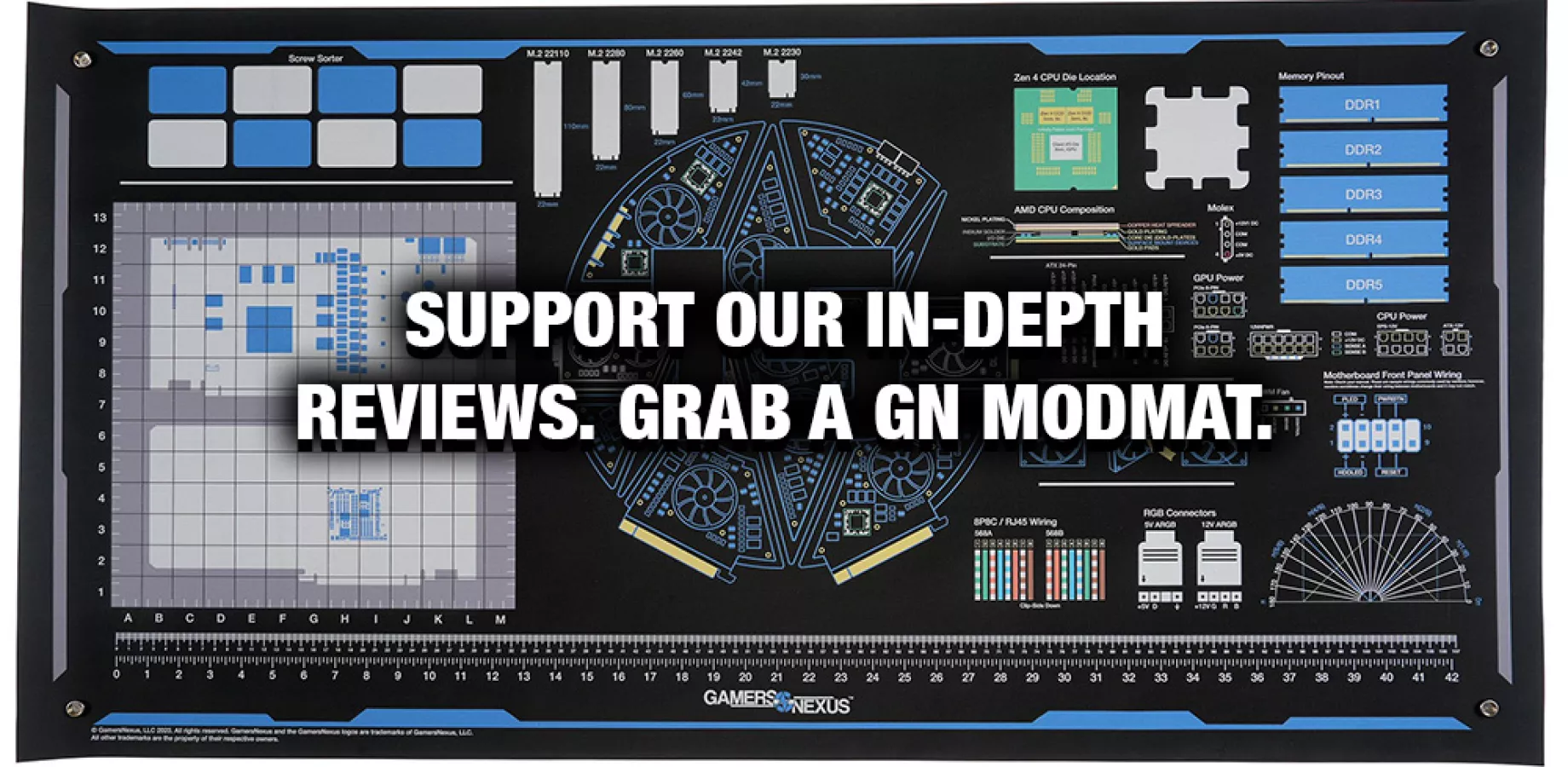
To wrap this up, we think that the usability and general annoyance level of Intel’s Arc GPUs are in a significantly better place than they were a year ago, definitely better than two years ago, and night-and-day from the original Alchemist launch. So they are gradually improving.
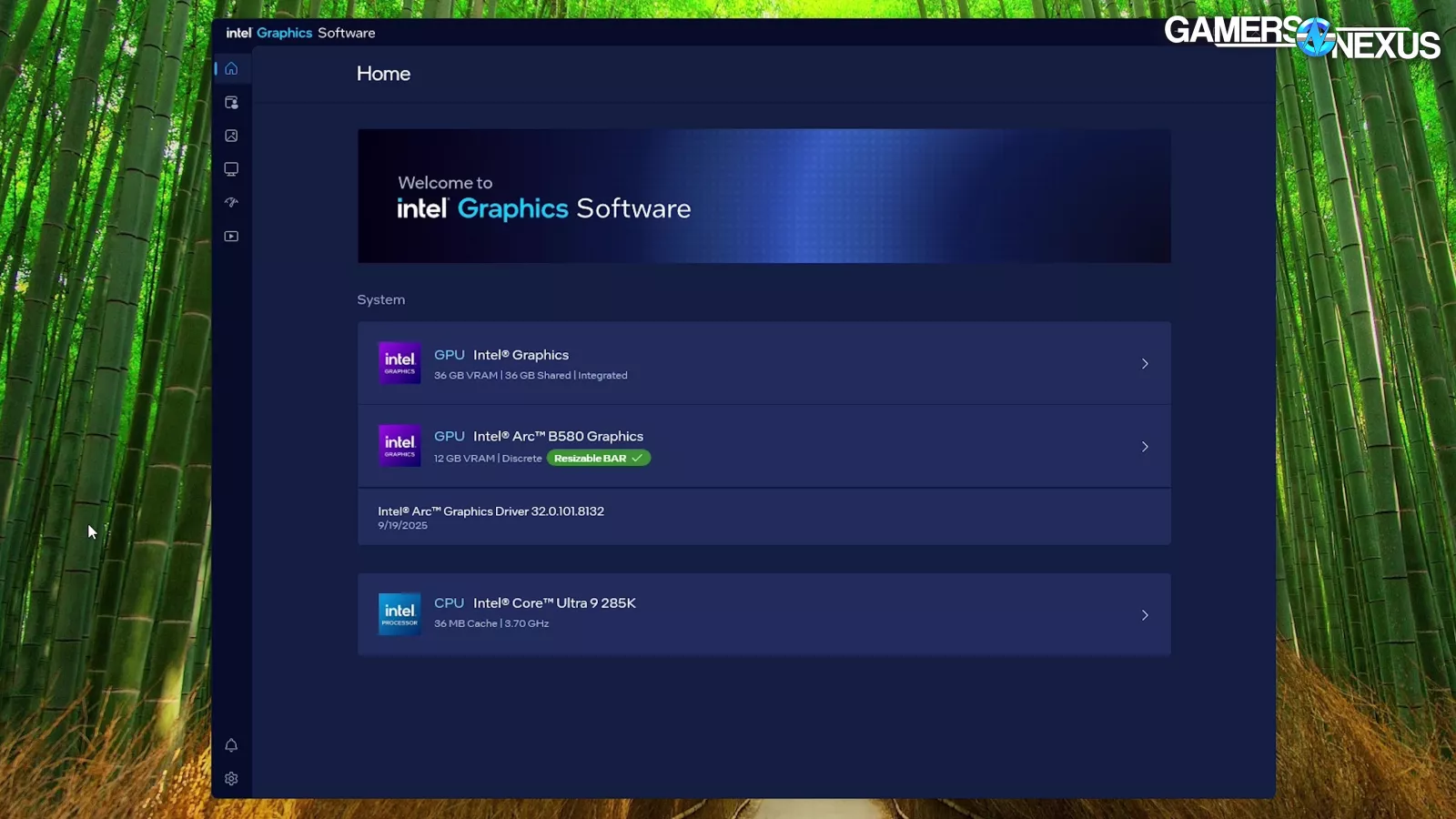
The fact that there’s only one piece of software (Intel Graphics Software) for all settings is a substantial improvement, and the fact that it’s a less bloated app than what came before is also good.
There are still things for Intel to fix, like the seemingly totally broken built-in monitoring and the unreliable frame sync settings. It can be frustrating to have game crashes just from picking Speed Sync, or from seeing Smart VSync work once, but never again.

There’s also things for Intel to upgrade, like adding frame rate caps for more than just DX9 and DX11 games, and if possible, making it easier to capture video while the GPU is fully-loaded.
We think that the more aggressive Intel stays on pushing fixes, the better off Arc will be. Overall, Intel’s drivers have improved significantly. We still wouldn’t recommend the company’s Arc GPUs to someone who doesn’t have a lot of patience or knowledge on how to do any troubleshooting, however. We don’t think the cards are there just yet. For most people in our audience, though, we think Arc is viable and worth considering if you’re able and willing to address potential technical issues if they arise.
In terms of performance per dollar, the cards are in a pretty good spot.
